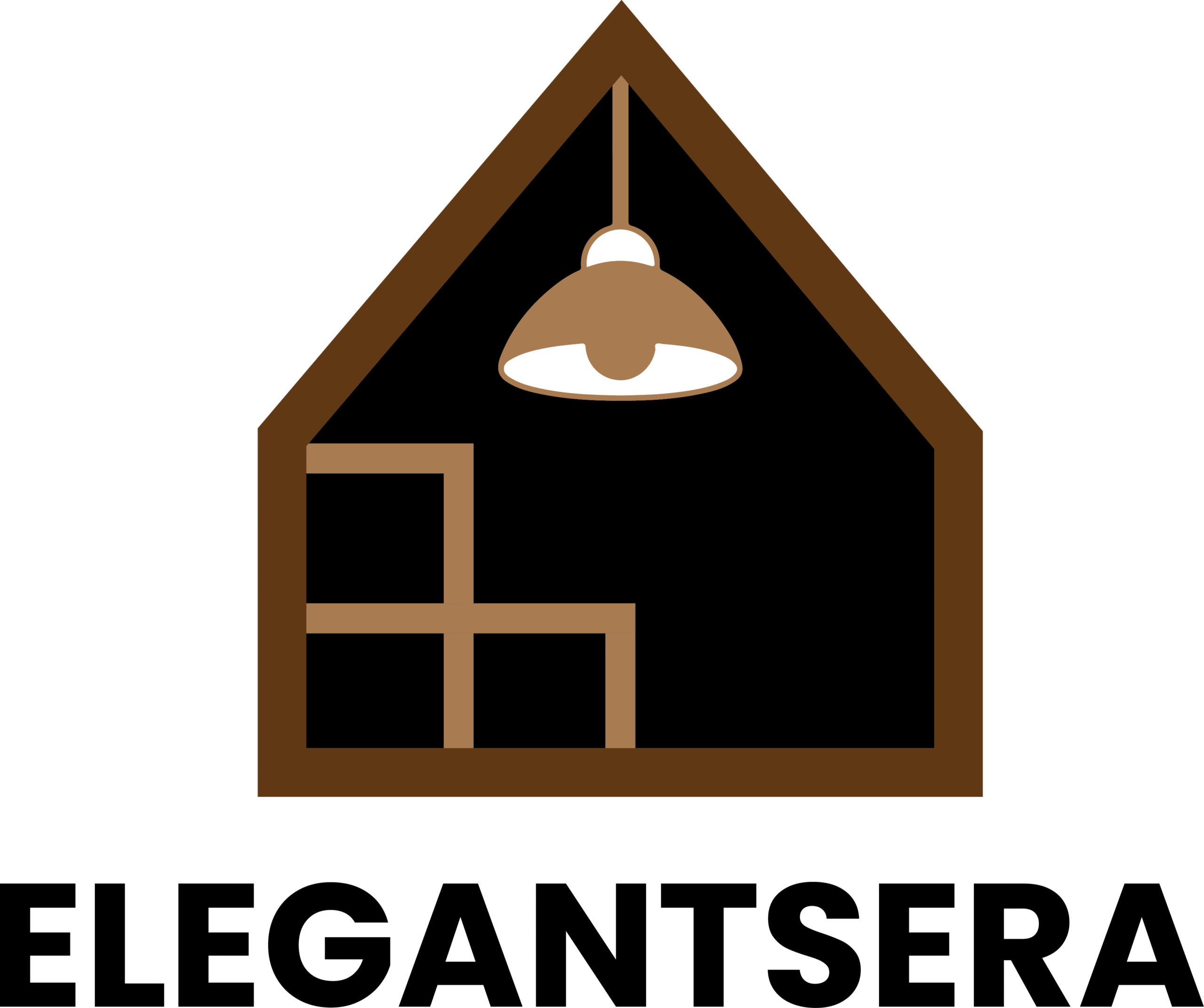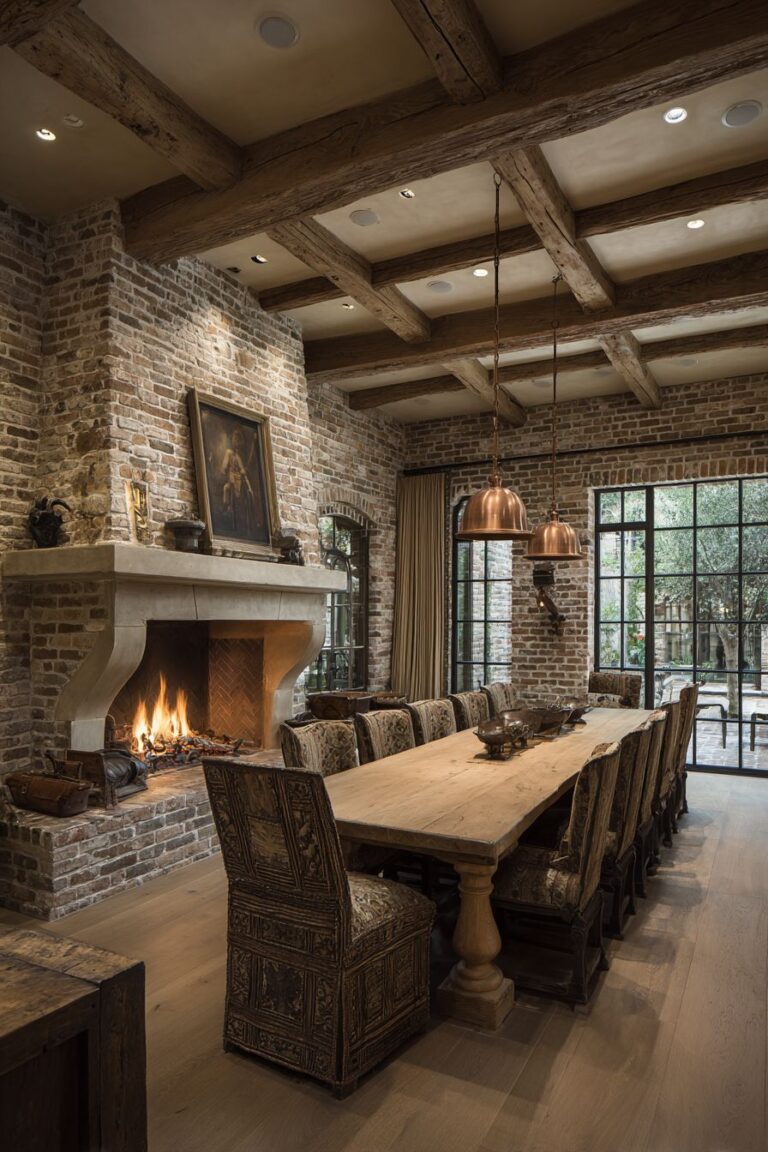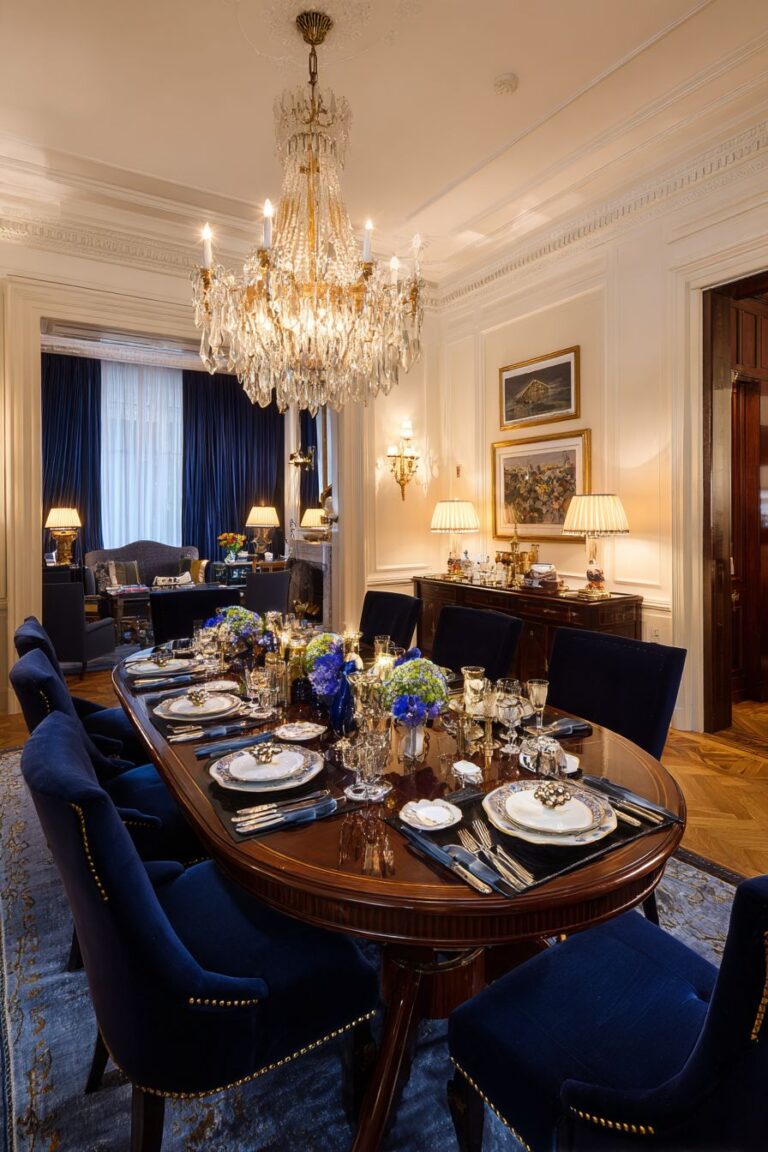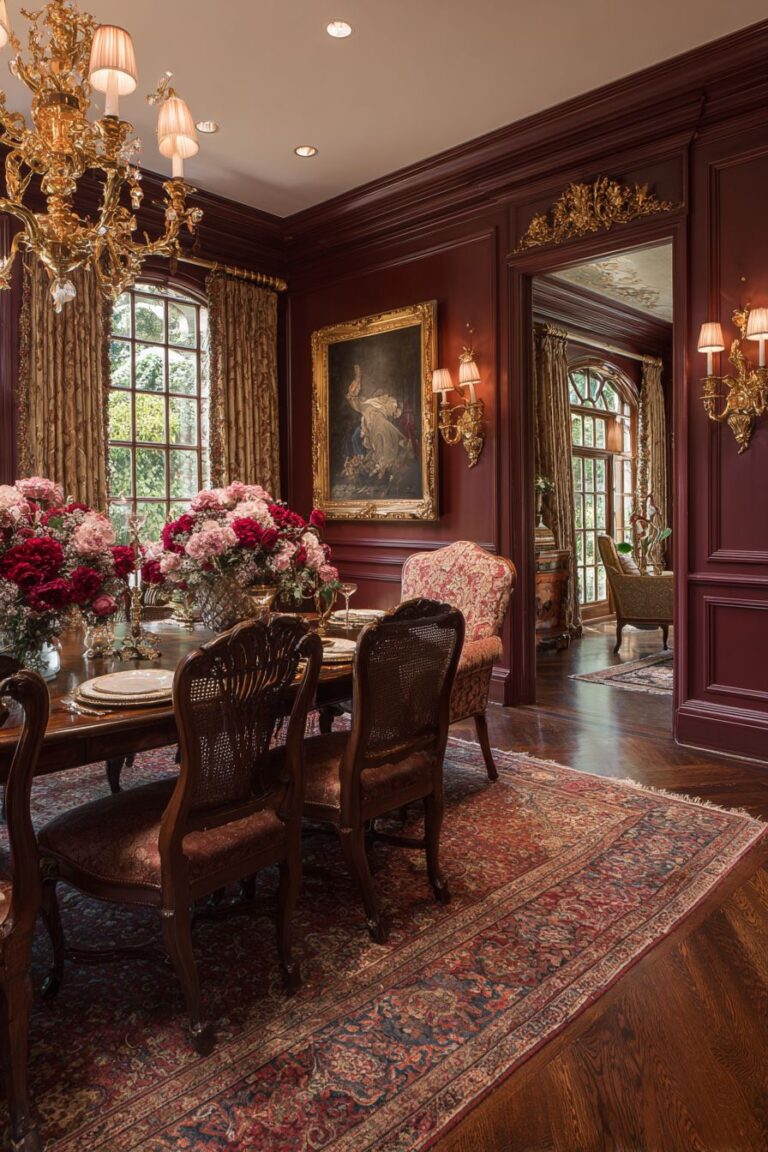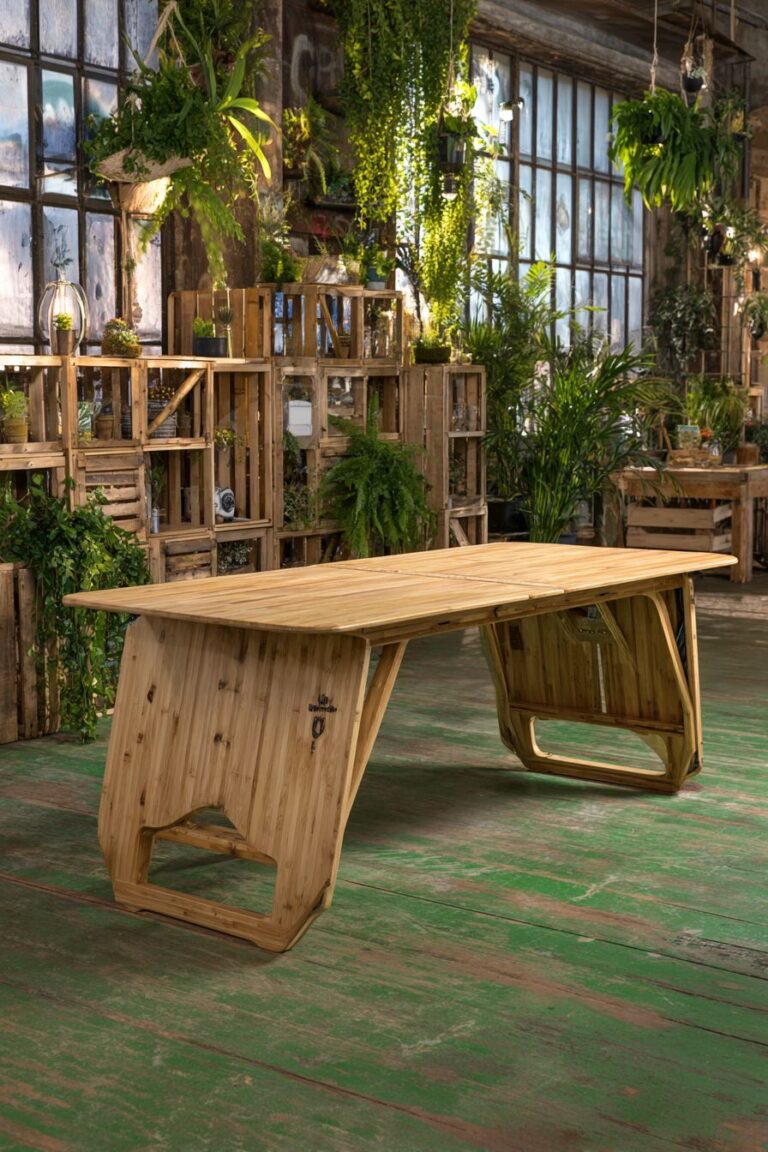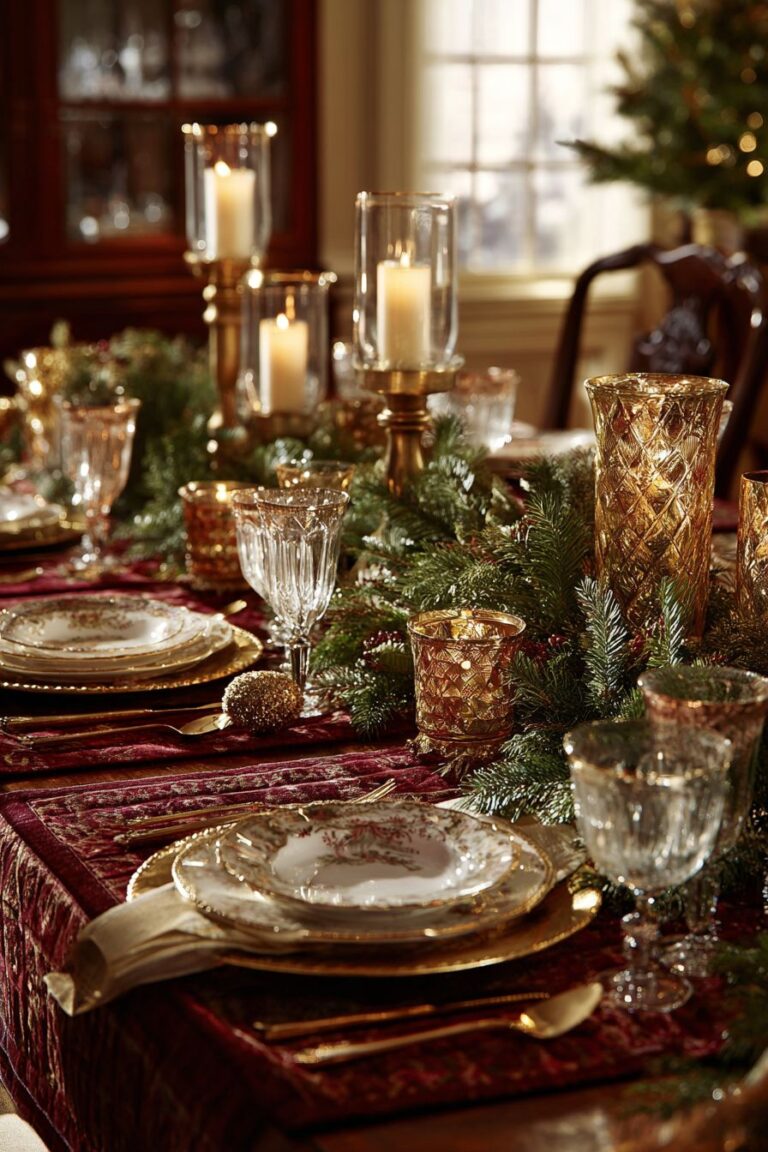18+ Cottage Dining Room Ideas: Creating Warm and Inviting Spaces
The cottage dining room represents the heart of rustic elegance, where warmth meets functionality in perfect harmony. These intimate spaces embody a timeless appeal that transcends fleeting design trends, creating environments where families gather, friends reconnect, and memories are woven into the very fabric of daily life. The essence of cottage dining lies not in perfection, but in the beautiful imperfections that tell stories—weathered wood that bears the marks of countless meals, mismatched chairs that speak of gradual collection over time, and handcrafted details that reflect genuine artisanal care.
In our fast-paced modern world, the cottage dining room offers a sanctuary of simplicity and authenticity. These spaces celebrate the art of slow living, where the act of dining becomes a cherished ritual rather than a hurried necessity. Each element within a cottage dining room serves both aesthetic and practical purposes, from storage solutions cleverly disguised within vintage hutches to lighting fixtures that cast the perfect glow for intimate conversations. The beauty of cottage style lies in its accessibility—it welcomes both grand entertaining and quiet family dinners with equal grace.
Throughout this comprehensive exploration, we’ll journey through twenty distinct cottage dining room concepts, each offering unique interpretations of this beloved design aesthetic. From French country influences to coastal cottage charm, from Arts and Crafts sophistication to shabby chic romance, these spaces demonstrate how cottage style adapts to various regional influences while maintaining its core principles of comfort, authenticity, and timeless appeal. Whether you’re working with a spacious farmhouse dining room or a cozy breakfast nook, these inspiring designs will guide you toward creating your own perfect cottage dining sanctuary.
1. Rustic Farmhouse Charm with Reclaimed Pine
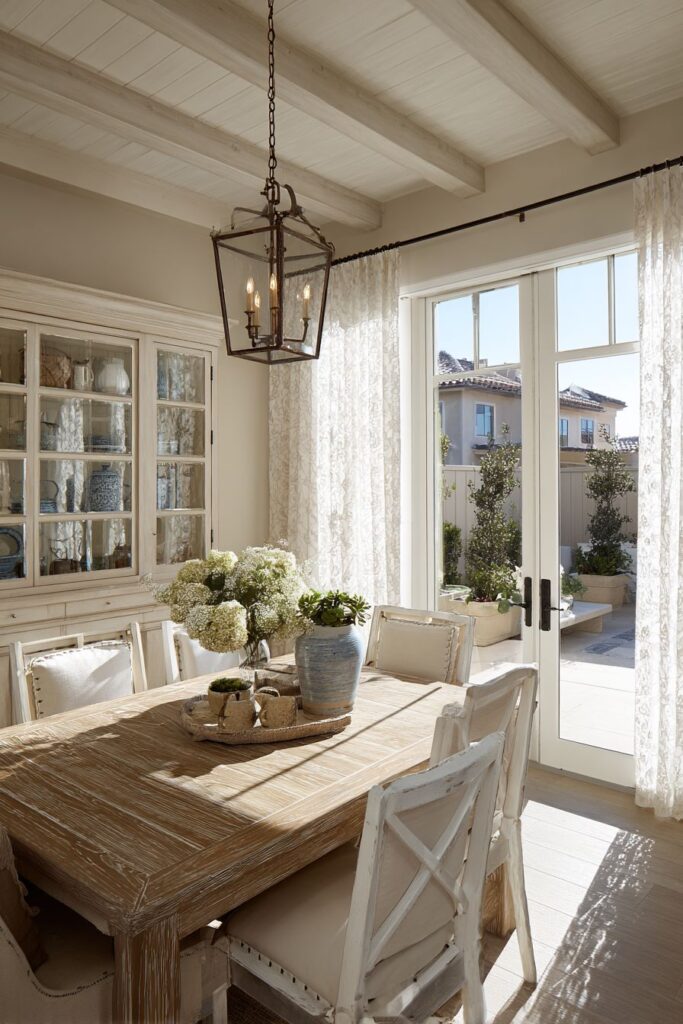
The foundation of authentic cottage dining begins with a magnificent rustic farmhouse table crafted from reclaimed pine, where natural wood grain tells stories of its previous life while subtle weathering adds character that cannot be manufactured. This centerpiece dining table becomes more than furniture—it transforms into a gathering place where the warmth of natural materials creates an immediate sense of welcome. The reclaimed pine surface bears the gentle marks of time, creating a patina that speaks to sustainability and environmental consciousness while delivering unmatched visual appeal.
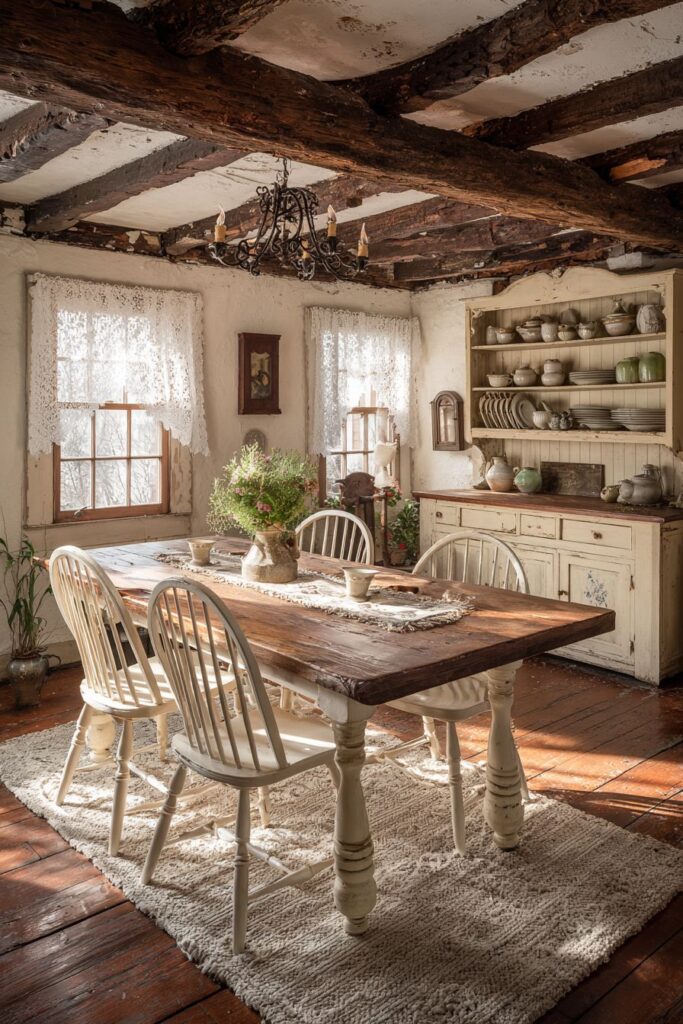
Surrounding this stunning table, Windsor-style chairs painted in soft cream provide both comfort and classic cottage aesthetic. These traditional chairs, with their distinctive spindle backs and solid wood construction, represent timeless craftsmanship that has graced cottage dining rooms for centuries. The soft cream paint finish offers versatility, complementing virtually any color scheme while maintaining the light, airy feeling essential to cottage design. Against one wall, a vintage hutch displays ceramic dishware in muted earth tones, creating both functional storage and visual interest through carefully curated collections.
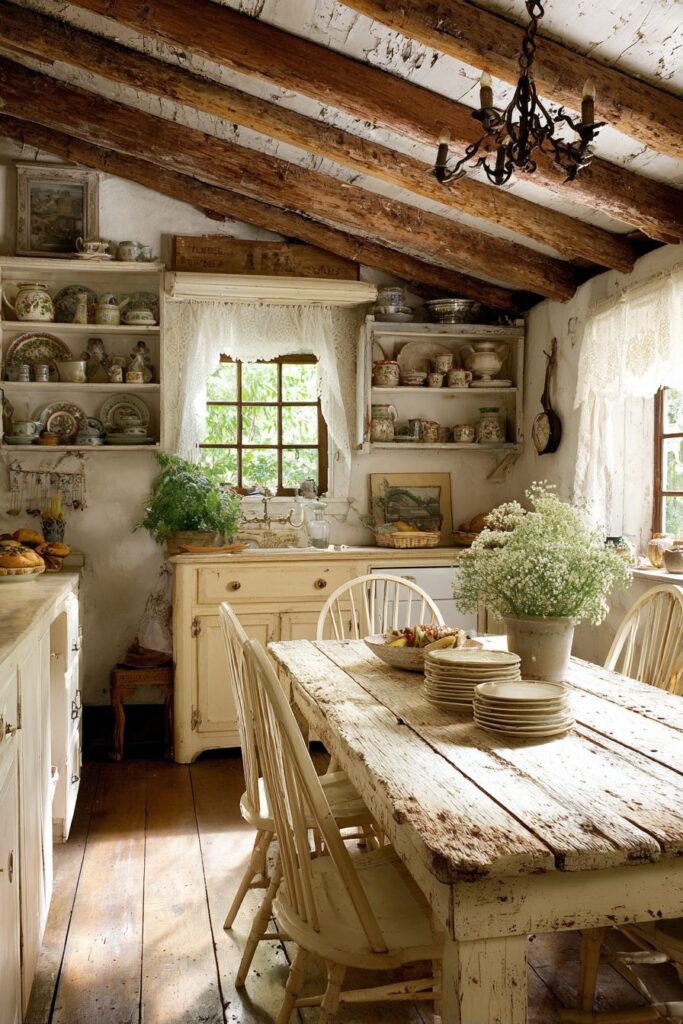
The architectural elements of this space deserve special attention, particularly the exposed ceiling beams that add structural character and visual weight to the room’s upper reaches. These beams, whether original to the structure or added for aesthetic purposes, create a sense of history and craftsmanship that grounds the entire design. Above the dining table, a wrought iron chandelier provides essential ambient lighting, its dark metal finish creating beautiful contrast against the lighter wood tones throughout the space.
Natural light streaming through lace-curtained windows creates the perfect finishing touch, casting soft shadows that highlight every texture and surface. This interplay of light and shadow throughout the day ensures the dining room feels alive and dynamic, never static or staged.
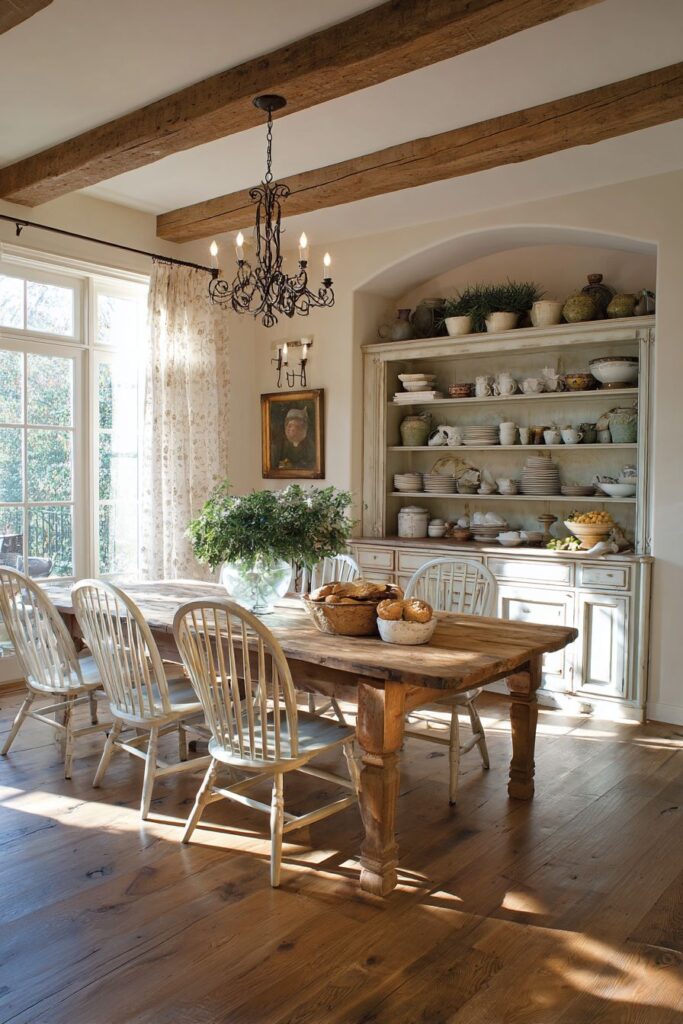
Key Design Tips:
- Choose reclaimed materials: Opt for furniture pieces made from salvaged or reclaimed wood to add instant character and environmental responsibility to your cottage dining room
- Mix textures thoughtfully: Combine smooth painted surfaces with natural wood grains and soft textiles to create visual and tactile interest
- Layer lighting sources: Combine overhead fixtures with natural light and consider adding table lamps or candles for ultimate ambiance control
- Display collections strategically: Use open shelving and hutches to showcase dishware and collectibles that reflect your personal style and cottage aesthetic
2. Intimate Corner Dining with Built-in Seating
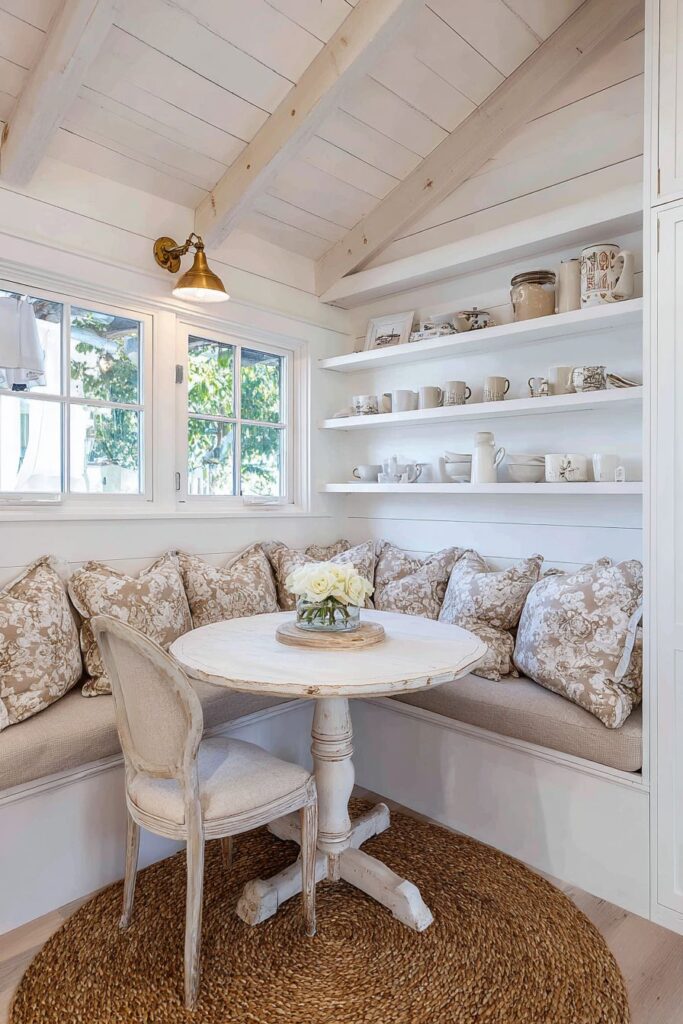
The cottage dining room reaches new heights of coziness when designed around built-in corner bench seating, creating an intimate breakfast nook atmosphere that maximizes both comfort and space efficiency. This clever design solution transforms what might otherwise be an underutilized corner into the most coveted seating in the house. The built-in benches, upholstered with floral cushions in faded rose and sage patterns, provide not only comfortable seating but also valuable storage underneath for linens, seasonal dishware, or table accessories.
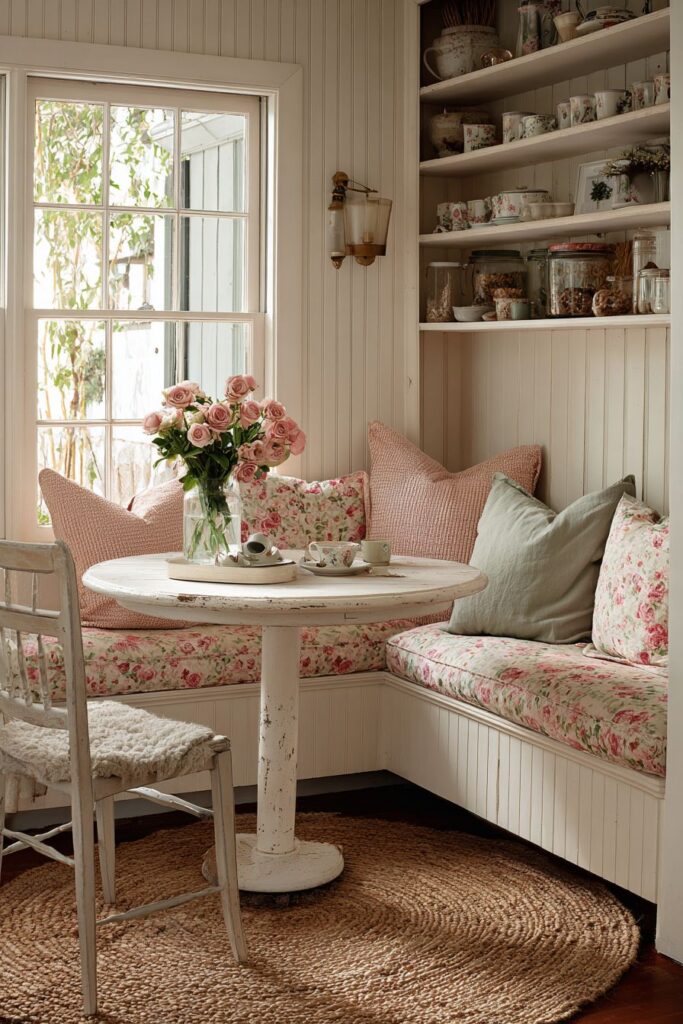
The round pedestal table positioned at the center of this seating arrangement creates the perfect scale for intimate gatherings, its distressed white paint finish echoing the cottage aesthetic while the circular shape promotes conversation and connection. This table style works particularly well in smaller spaces, as the single pedestal base allows for flexible seating arrangements and easier movement around the space. The distressed finish suggests years of family meals and celebrations, adding instant history to even the newest installation.
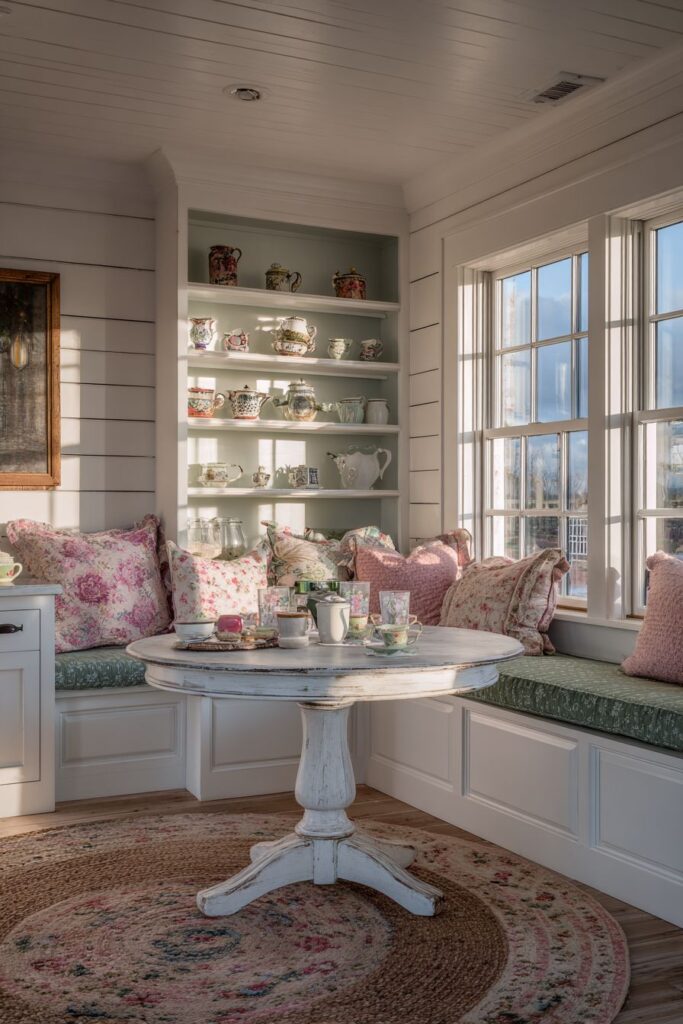
Open shelving throughout this design displays vintage teacups and mason jars, creating both functional storage and decorative appeal. These shelves, whether built-in or free-standing, allow for the display of collections that personalize the space while maintaining the cottage emphasis on functionality. Shiplap walls in soft white create subtle texture and visual interest without overwhelming the intimate scale of the space, while their horizontal lines help the room feel more spacious than its actual square footage might suggest.
The flooring in this design features a braided rug in natural fibers, which grounds the seating area while adding warmth and texture underfoot. Golden hour lighting filtering through vintage windowpanes creates magical moments throughout the day, transforming this corner dining area into a sun-drenched retreat perfect for morning coffee or afternoon tea.
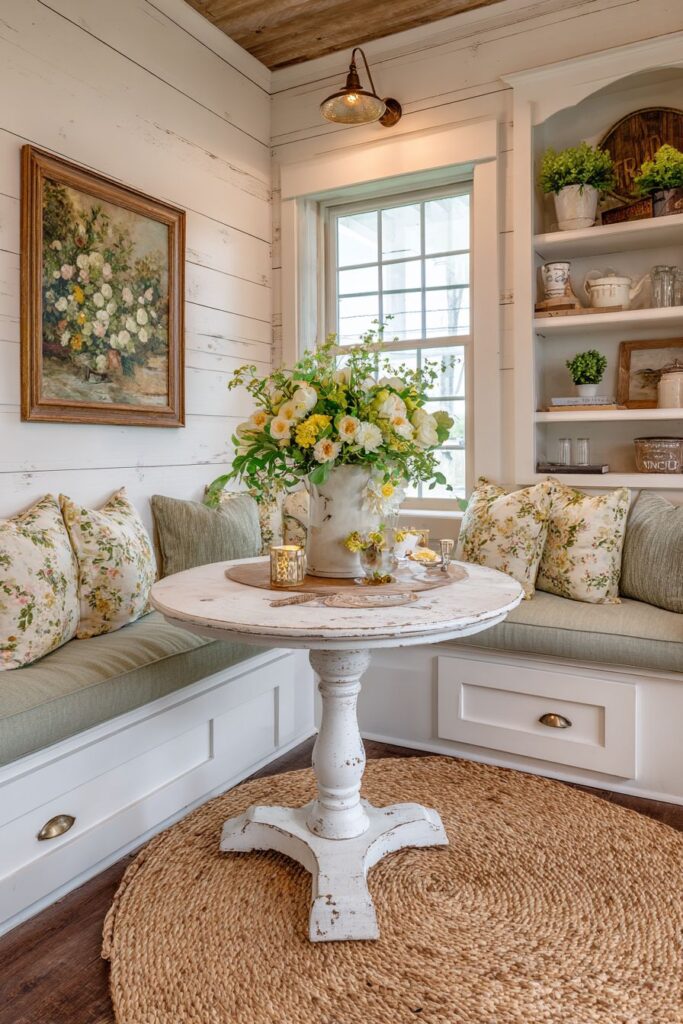
Key Design Tips:
- Maximize corner spaces: Use built-in seating to transform unused corners into functional dining areas that feel intentional and designed
- Choose round tables for intimacy: Circular dining tables promote conversation and work especially well in compact spaces
- Incorporate storage solutions: Take advantage of built-in seating to create hidden storage for dining essentials and seasonal items
- Layer patterns carefully: Mix floral cushions with natural textures to create visual interest without overwhelming small spaces
3. Welsh Dresser Storage Solutions
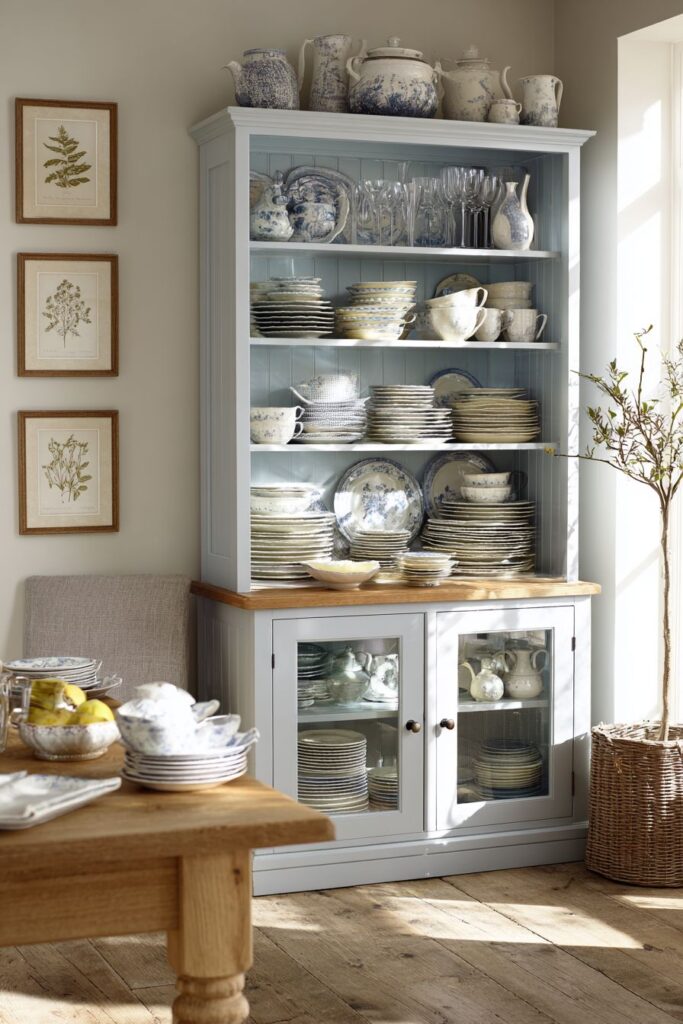
The painted Welsh dresser stands as a cornerstone of cottage dining room design, offering both magnificent display opportunities and essential storage functionality in one beautifully crafted piece. This particular example, finished in soft blue-grey paint, demonstrates how color can transform a utilitarian piece into a stunning focal point that anchors the entire room’s design scheme. The dresser’s generous proportions allow for the display of mismatched vintage china and glassware, creating a curated collection that tells the story of the family’s history and travels.
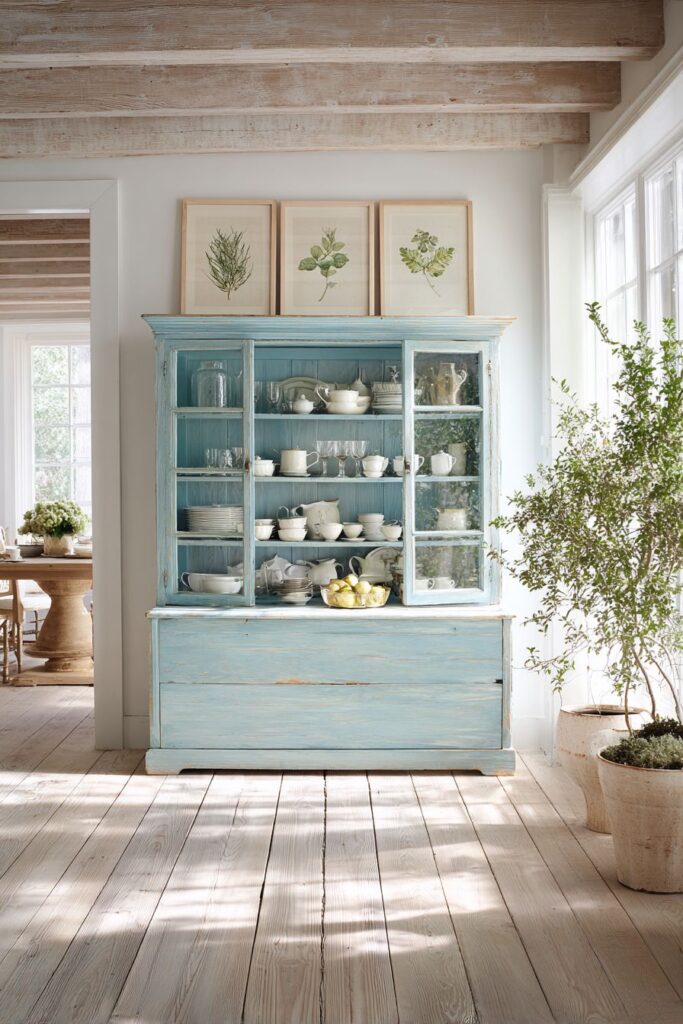
The beauty of the Welsh dresser lies in its dual nature—the lower cabinets provide concealed storage for everyday dining essentials, while the upper open shelving creates opportunities for artistic display. This combination makes it an ideal piece for cottage dining rooms, where both functionality and beauty are equally important. The soft blue-grey paint finish adds a gentle color note to the space while maintaining the serene, calming atmosphere essential to cottage design.
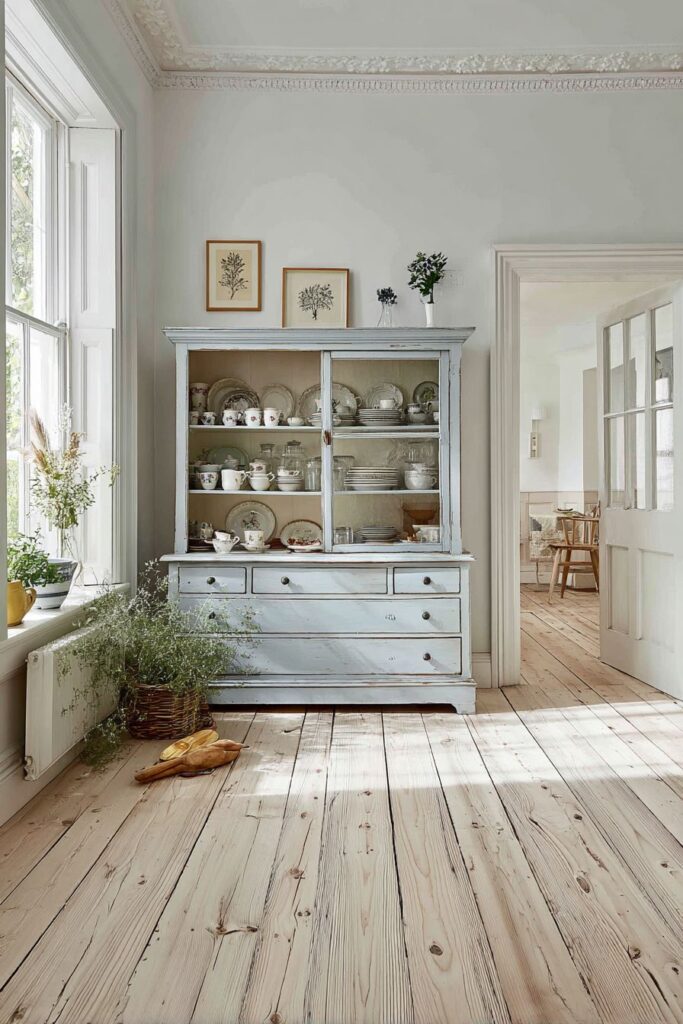
Natural pine flooring throughout this space shows gentle wear patterns that speak to authentic cottage living, where beauty is found in the honest marks of daily life rather than pristine perfection. These floors, with their warm honey tones and visible grain patterns, provide the perfect foundation for the room’s layered design elements. The gentle wear patterns around the dresser and dining table create pathways that tell the story of family routines and gathering patterns.
Botanical prints in simple wooden frames add wall interest without competing with the dresser’s commanding presence, their natural subjects reinforcing the cottage connection to garden and countryside. The soft natural lighting from nearby windows creates gentle highlights on both the dresser’s painted surface and the displayed collections, ensuring that this storage solution becomes a true centerpiece rather than merely functional furniture.
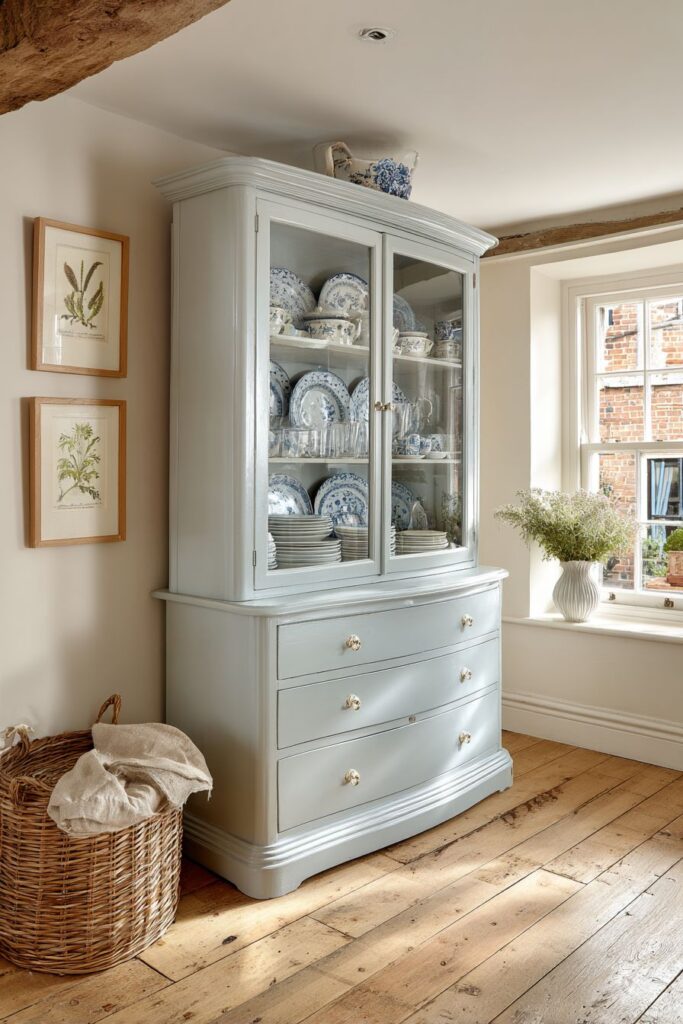
Key Design Tips:
- Choose statement storage pieces: Invest in one large, beautiful storage piece like a Welsh dresser to anchor your cottage dining room design
- Display collections with intention: Arrange dishware and glassware to create visual vignettes that tell your family’s story
- Embrace gentle wear patterns: Allow floors and furniture to show honest signs of use rather than pursuing sterile perfection
- Balance open and closed storage: Combine display opportunities with concealed storage for a lived-in yet organized appearance
4. Harvest Table with Mismatched Seating
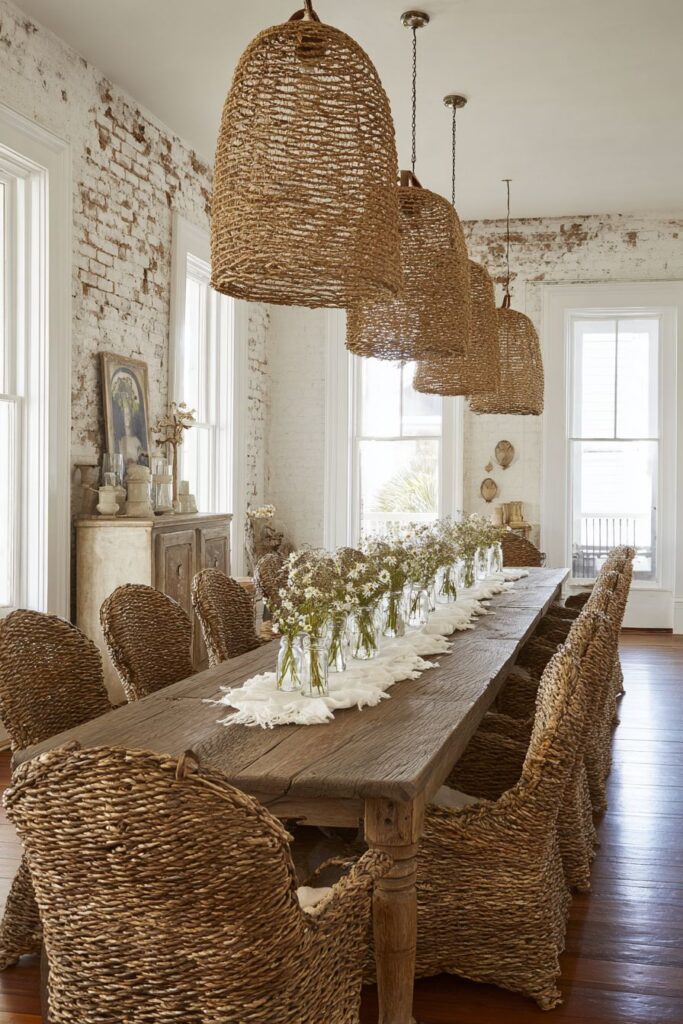
The long harvest table crafted from weathered oak represents the ultimate in cottage dining room functionality, providing generous space for large gatherings while maintaining the intimate atmosphere essential to cottage style. This substantial piece, with its weathered finish and solid construction, suggests years of harvest celebrations and family gatherings, making it the perfect centerpiece for a dining room designed around hospitality and connection. The weathered oak surface tells stories through its patina and gentle imperfections, creating a table that improves with age and use.
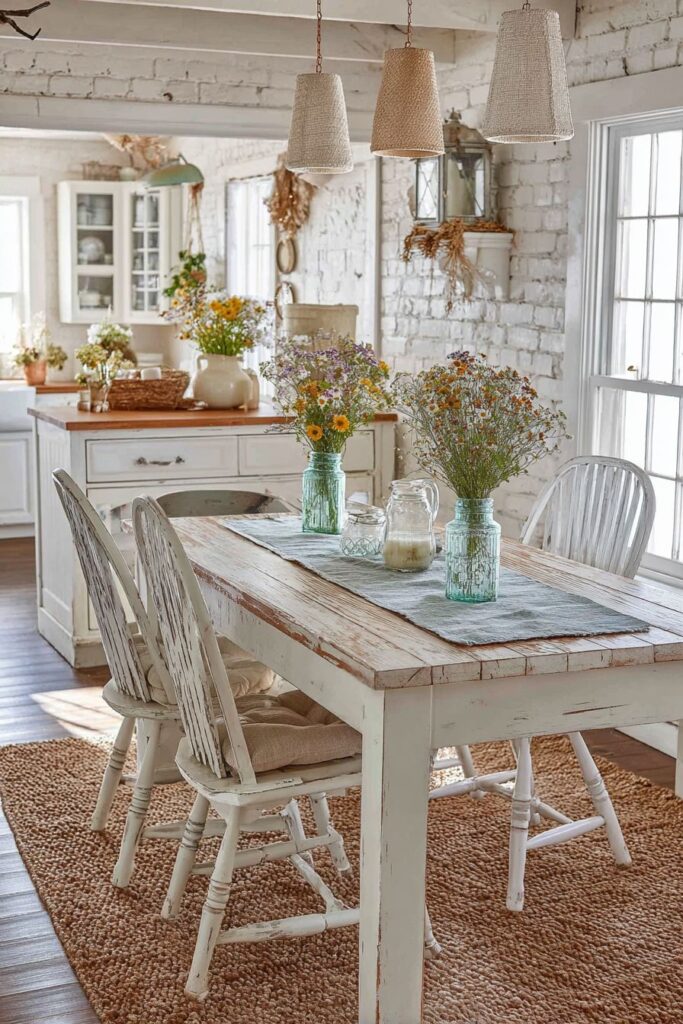
The genius of this design lies in the deliberately mismatched antique chairs, each bringing its own unique character and patina to the dining experience. This eclectic seating arrangement—featuring perhaps a Windsor chair, a ladder-back, and a spindle chair—creates visual interest while demonstrating the cottage principle of collecting beautiful pieces over time rather than purchasing matching sets. Each chair contributes its own story and personality, creating seating that engages guests and encourages lingering conversations.
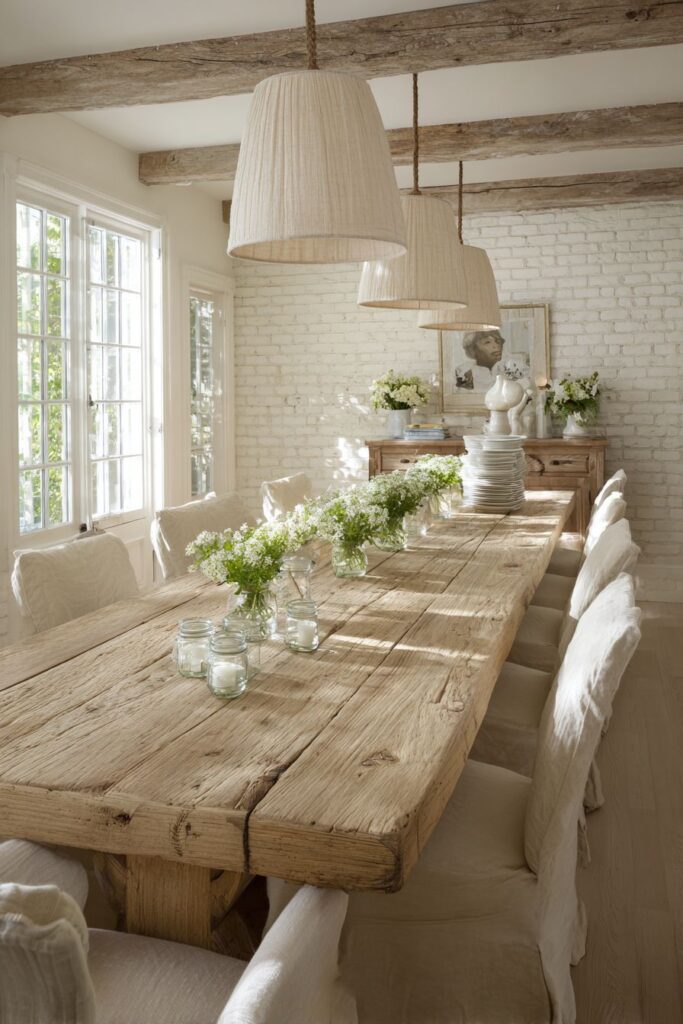
Fresh wildflowers arranged in mason jars create simple yet stunning centerpieces that celebrate the cottage connection to nature and seasonal change. This approach to table decoration emphasizes natural beauty over elaborate arrangements, using readily available materials to create displays that feel fresh and unpretentious. The mason jars themselves reinforce the cottage aesthetic while providing practical vessels that won’t break the budget or require special care.
Against one wall, a vintage sideboard provides essential serving space and storage while adding another layer of authentic cottage character. The whitewashed brick walls create textural interest and architectural appeal, their irregular surfaces and natural variations providing the perfect backdrop for the room’s collected furnishings. Hanging pendant lights with fabric shades cast warm pools of light over the harvest table, creating intimate illumination that makes every meal feel special.
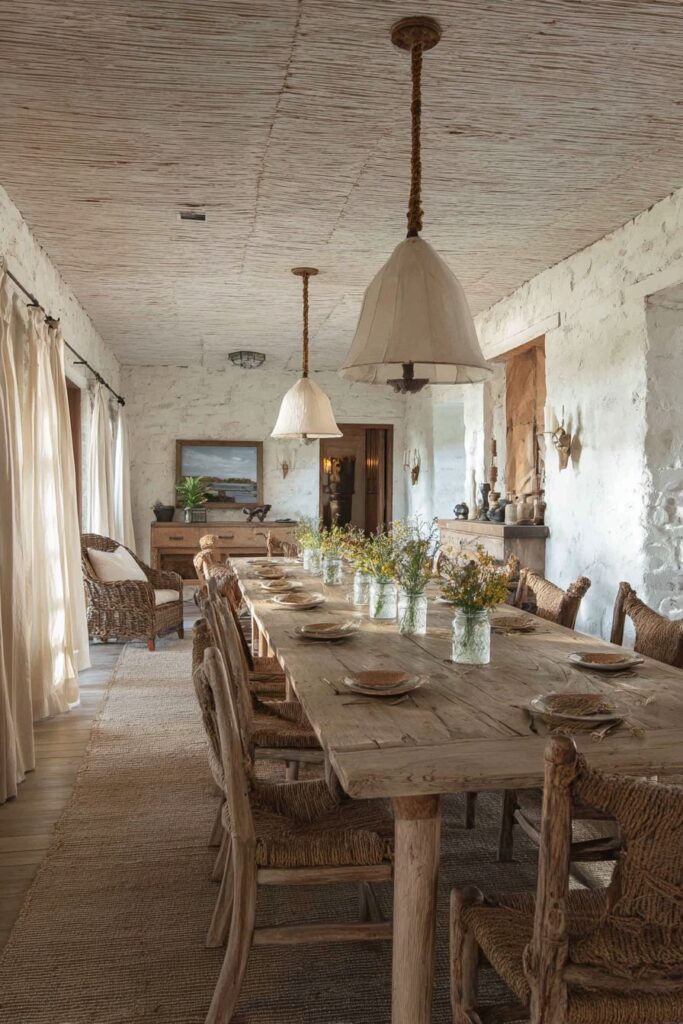
Key Design Tips:
- Invest in substantial tables: Choose dining tables that can accommodate large gatherings while maintaining cottage charm and character
- Embrace mismatched seating: Collect chairs with different styles and stories to create eclectic, interesting seating arrangements
- Use natural centerpieces: Arrange seasonal flowers and plants in simple containers for centerpieces that feel fresh and authentic
- Layer lighting thoughtfully: Combine pendant lights with natural light to create flexible illumination for different dining occasions
5. Space-Saving Drop-Leaf Solutions
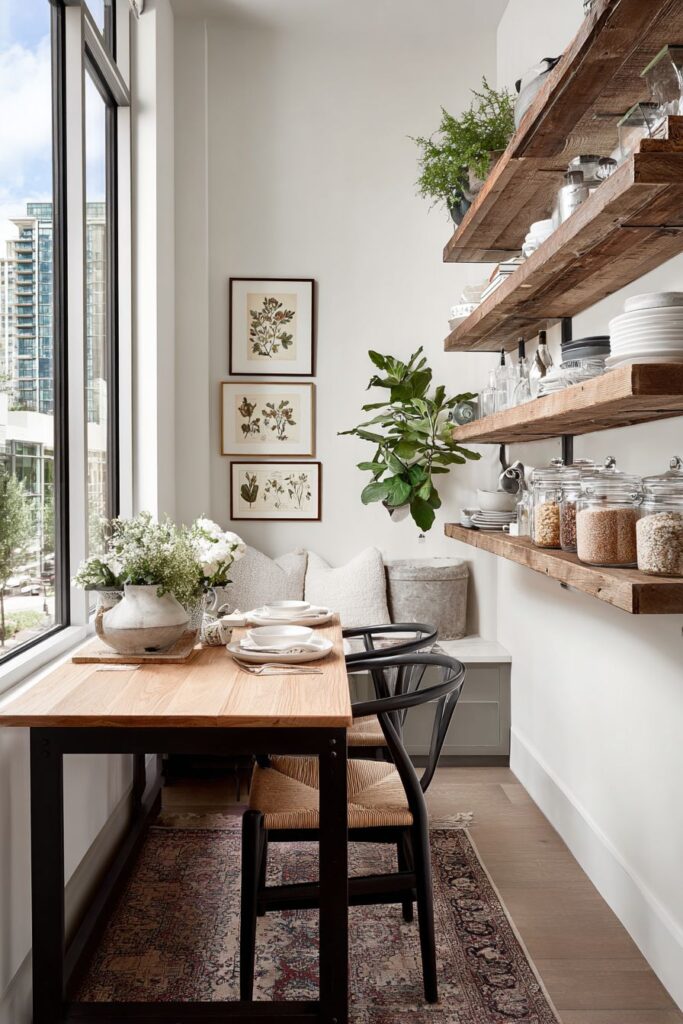
Small cottage dining rooms require creative solutions that maximize functionality without sacrificing style, and the drop-leaf table represents one of the most elegant answers to this challenge. Positioned against the wall when not in use, this clever piece of furniture takes up minimal floor space while providing the flexibility to expand for gatherings and special occasions. The drop-leaf design speaks to traditional cottage ingenuity, where every piece of furniture needed to serve multiple purposes while maintaining beauty and craftsmanship.
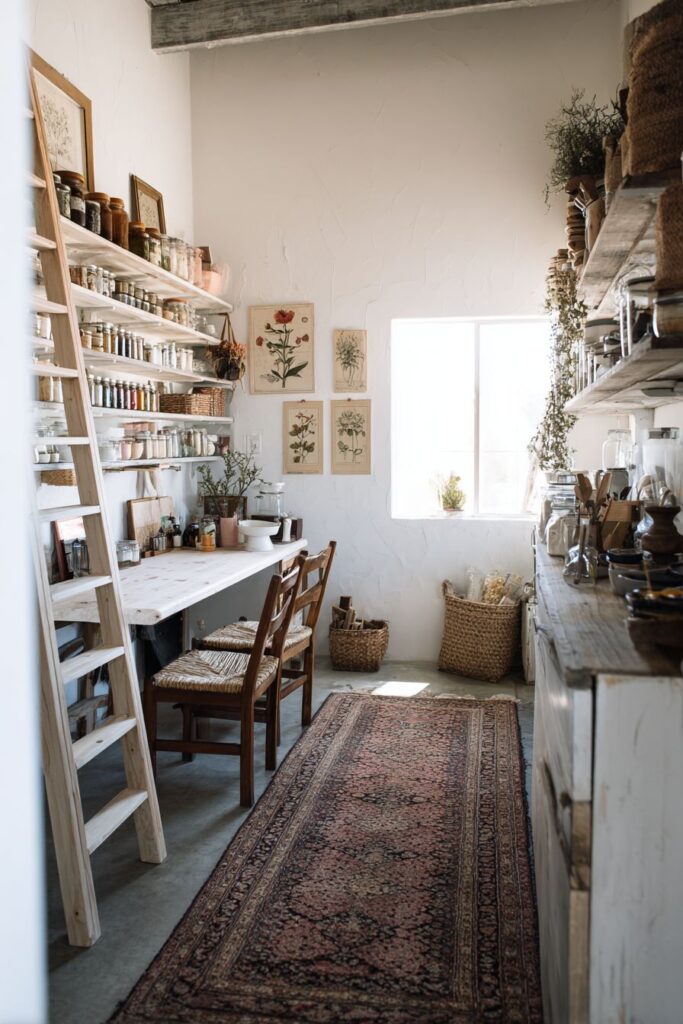
Two ladder-back chairs with rush seats complement this space-saving approach, their traditional styling and compact proportions making them perfect for smaller dining areas. These chairs can be easily moved throughout the cottage as needed, serving as desk chairs, bedroom seating, or extra dining chairs when entertaining. The rush seats add natural texture and traditional craftsmanship while providing comfortable seating that improves with age and use.
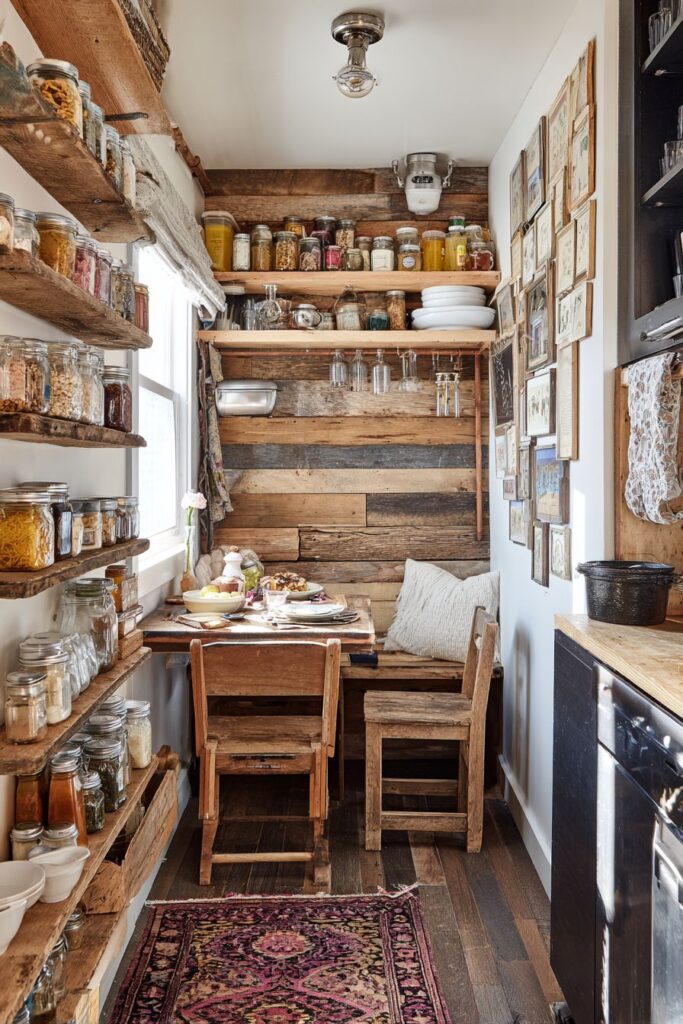
Open shelving made from reclaimed barn wood creates vertical storage that draws the eye upward, making the small space feel larger while providing essential display and storage opportunities. These shelves showcase everyday dishes and preserving jars, keeping frequently used items within easy reach while creating attractive displays that reinforce the cottage aesthetic. The reclaimed barn wood adds character and sustainability to the design while providing sturdy, functional storage.
A carefully curated collection of vintage botanical prints covers one wall, creating visual interest and personality without overwhelming the compact space. These prints, with their natural subjects and vintage appeal, reinforce the cottage connection to garden and countryside while adding color and artistic interest. A small Persian rug defines the dining area, its intricate patterns and rich colors providing warmth and definition to the eating space within the larger room.
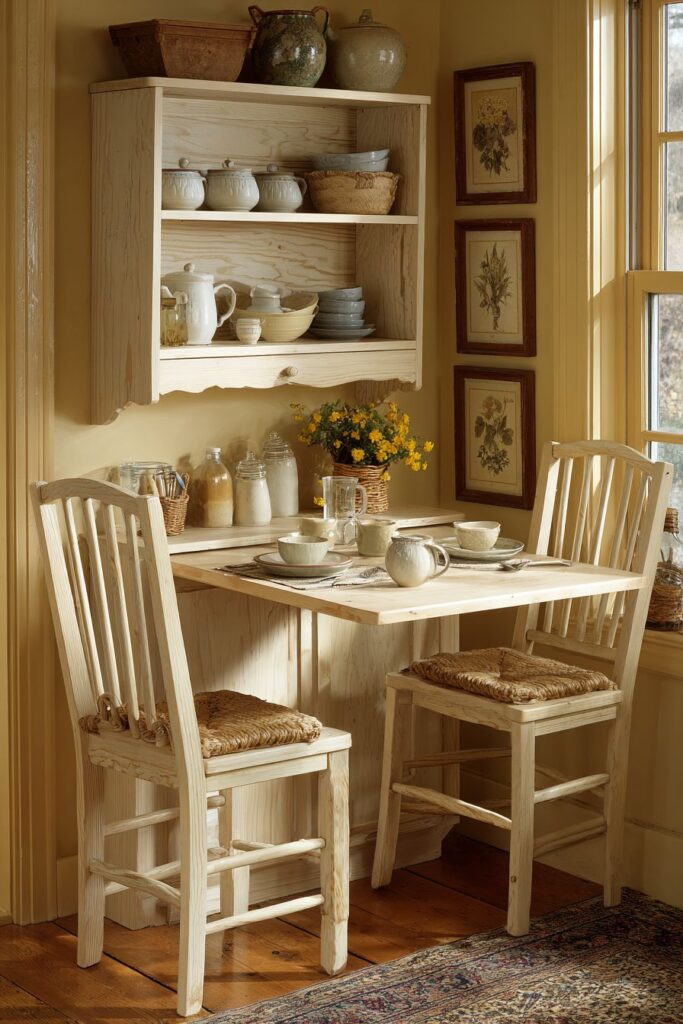
Key Design Tips:
- Choose flexible furniture: Opt for pieces like drop-leaf tables that can adapt to different needs and space requirements
- Utilize vertical storage: Use wall-mounted shelving to create storage without consuming valuable floor space
- Define spaces with rugs: Use area rugs to create defined zones within larger rooms or open floor plans
- Curate wall displays: Choose artwork and prints that reflect your personal style while maintaining cottage charm
6. Painted Trestle Table Elegance
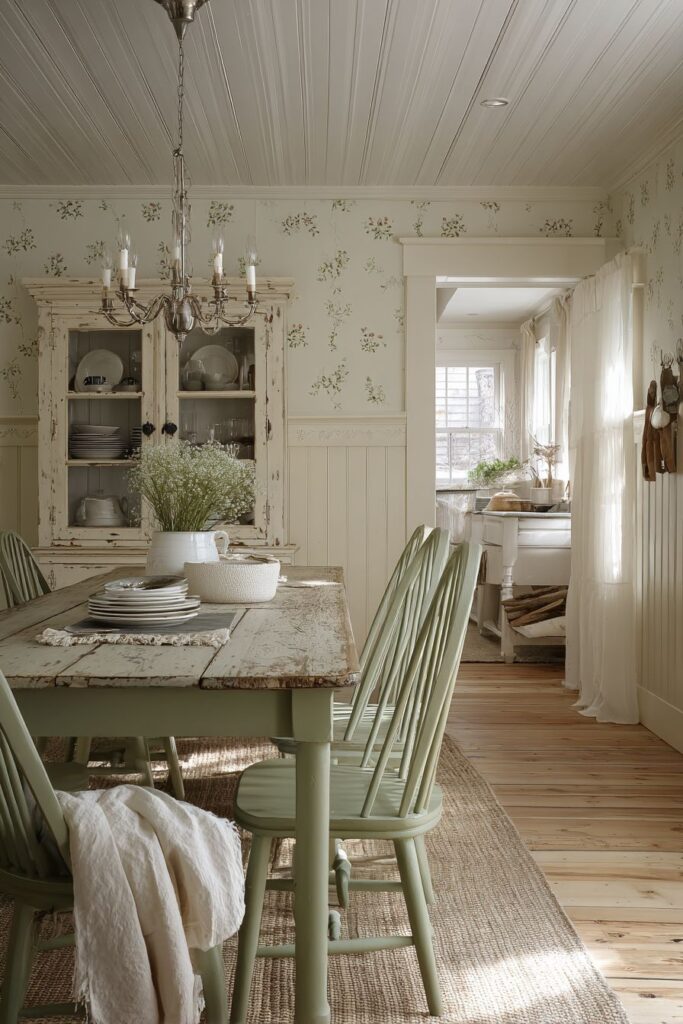
The painted trestle table in soft sage green demonstrates how color can transform traditional cottage furniture into something both fresh and timeless, its naturally worn tabletop revealing glimpses of wood underneath that speak to authentic use and cherished history. This beautiful patina, where paint has worn away through daily use, creates the kind of character that cannot be artificially manufactured, making each mark and worn spot a testament to family meals and gathered friends. The soft sage green paint color brings a touch of garden freshness indoors while maintaining the serene, calming atmosphere essential to cottage dining rooms.
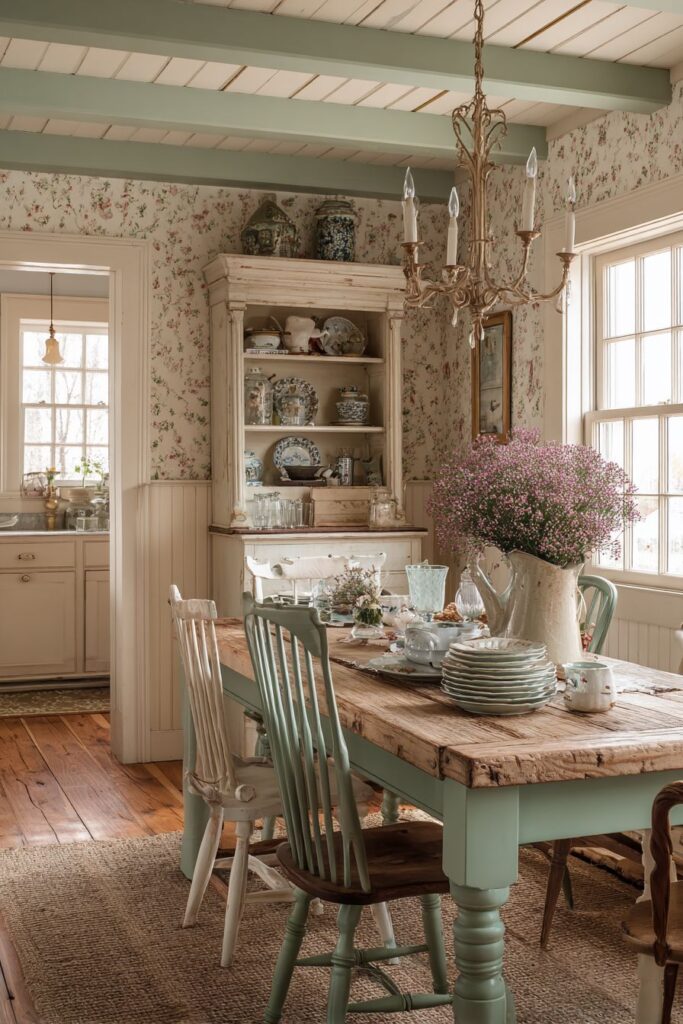
Spindle-back chairs in coordinating colors create a cohesive seating arrangement that feels curated rather than matched, their traditional styling and comfortable proportions making them perfect for long dinner conversations. These chairs, with their classic cottage proportions and timeless appeal, provide both visual interest and practical comfort. The coordinating colors—perhaps variations of the table’s sage green mixed with cream or soft blue—create unity while avoiding the monotony of exact matches.
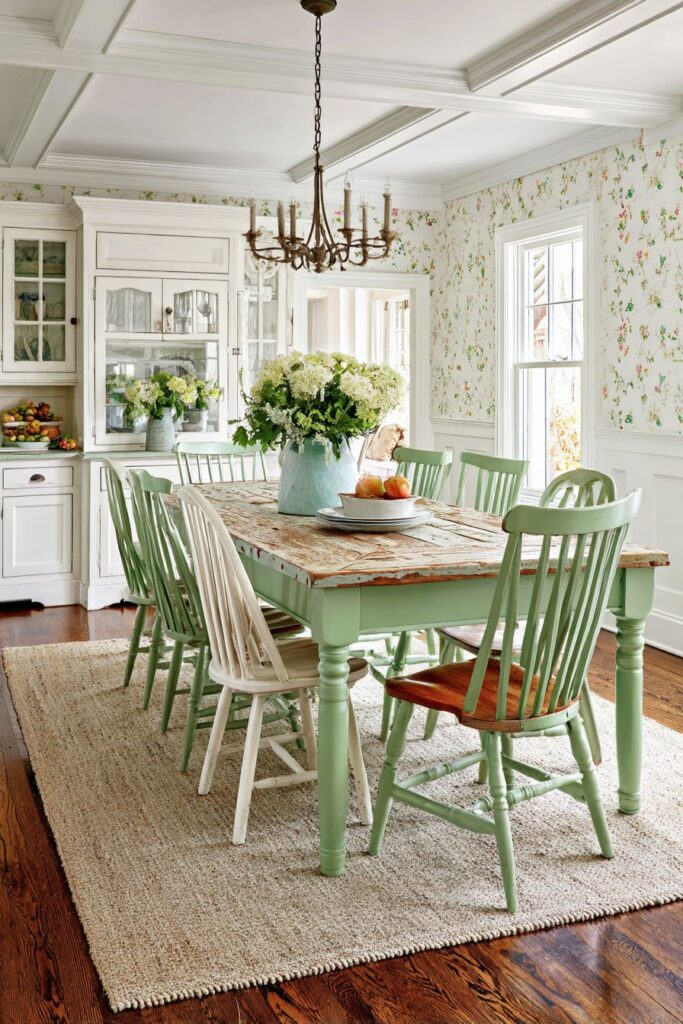
Above this charming tablescape, a farmhouse-style chandelier with candle-style bulbs provides essential ambient lighting while reinforcing the cottage aesthetic through its traditional materials and proportions. This lighting choice creates the perfect atmosphere for dining, its multiple small bulbs providing warm, even illumination that flatters both food and faces around the table. The candle-style bulbs reference historical lighting methods while providing modern convenience and reliability.
The architectural details in this space deserve special attention, particularly the wainscoting in cream paint that contrasts beautifully with wallpaper featuring tiny floral motifs above. This combination creates visual interest and traditional cottage charm while providing practical protection for the lower walls. Against one wall, a vintage pie safe displays linens and serving pieces, its punched tin doors and solid construction representing authentic American cottage craftsmanship.
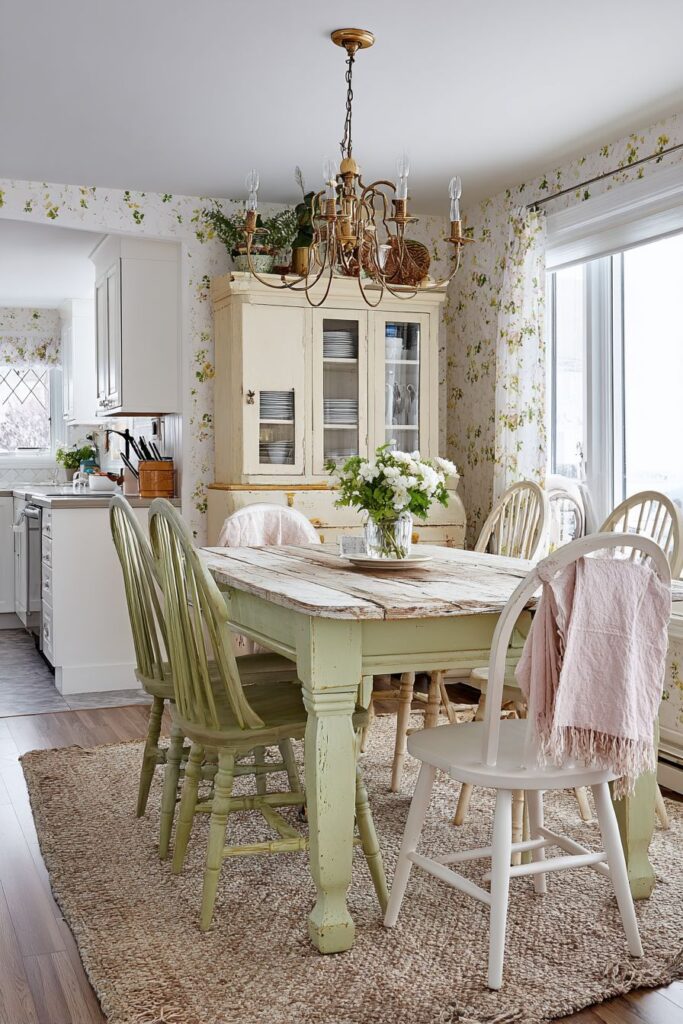
Key Design Tips:
- Embrace painted furniture: Use paint to refresh and coordinate cottage furniture while allowing natural wear to show character
- Layer architectural details: Combine wainscoting with wallpaper to create visual interest and traditional cottage appeal
- Choose period-appropriate lighting: Select fixtures that reference historical styles while providing modern functionality
- Display functional collections: Use vintage storage pieces to showcase linens and serving pieces that reinforce cottage charm
7. French Country Sophistication
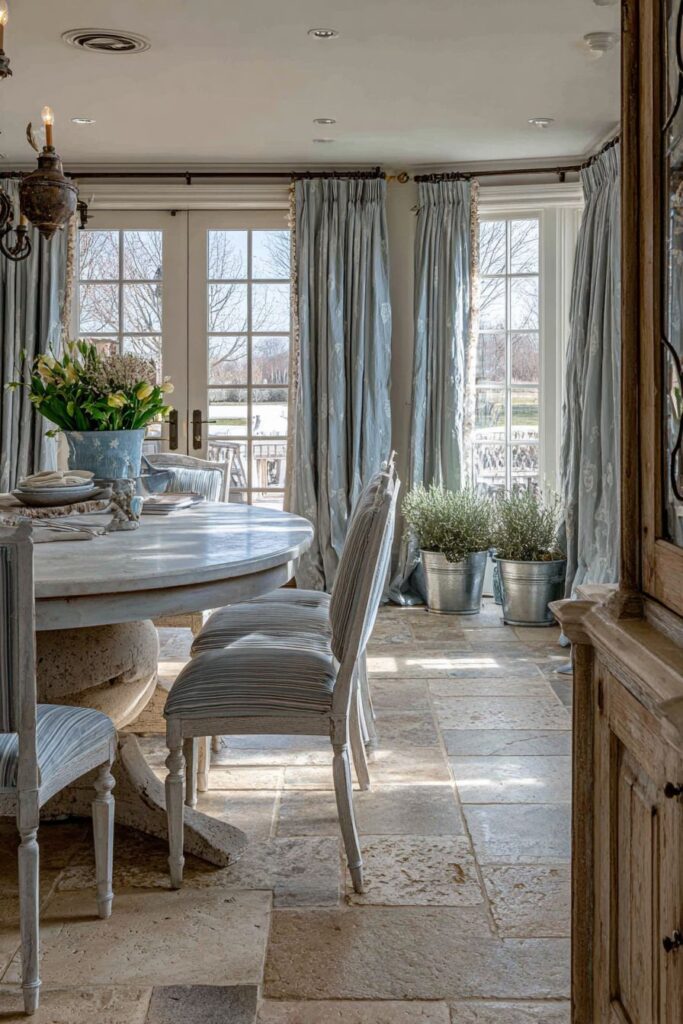
The French country cottage dining room elevates rustic charm with sophisticated touches, beginning with a round pedestal table featuring a marble top and painted base that brings European elegance to cottage living. This combination of materials—the cool luxury of marble paired with painted wood—creates a refined yet approachable aesthetic that defines French country style. The marble top provides both beauty and functionality, its surface perfect for pastry making and casual dining while adding a note of understated luxury to the cottage environment.
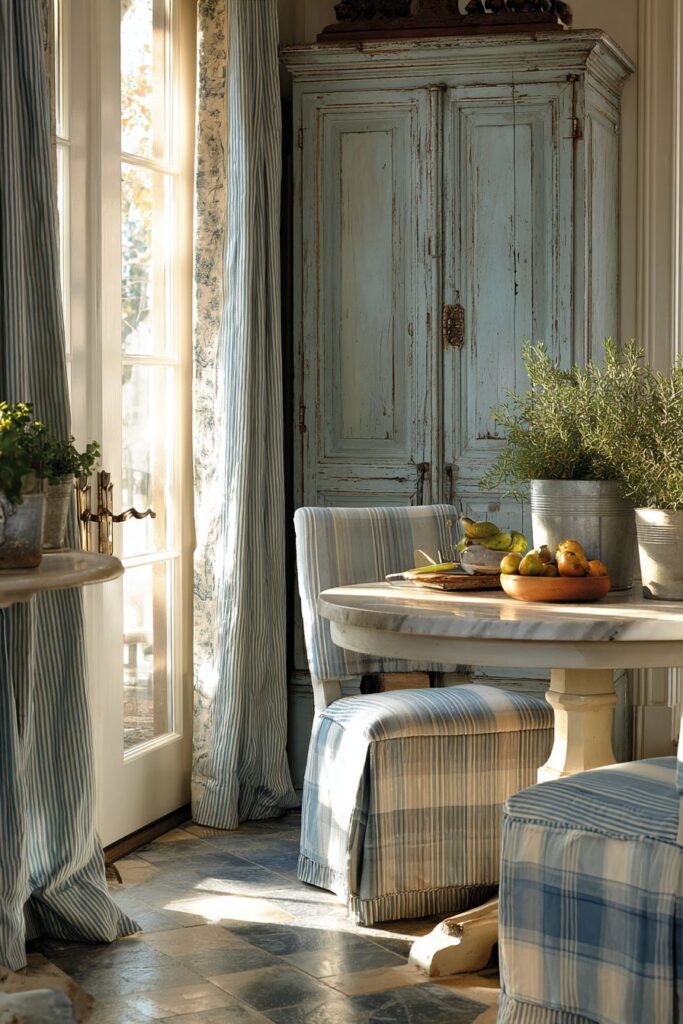
Upholstered chairs in classic ticking stripe fabric provide comfortable seating while introducing the blue and white color palette so beloved in French country design. These chairs, with their generous proportions and quality upholstery, invite lingering over long meals and intimate conversations. The ticking stripe pattern references traditional French textiles while remaining timeless and versatile enough to work with changing seasonal decor and table settings.
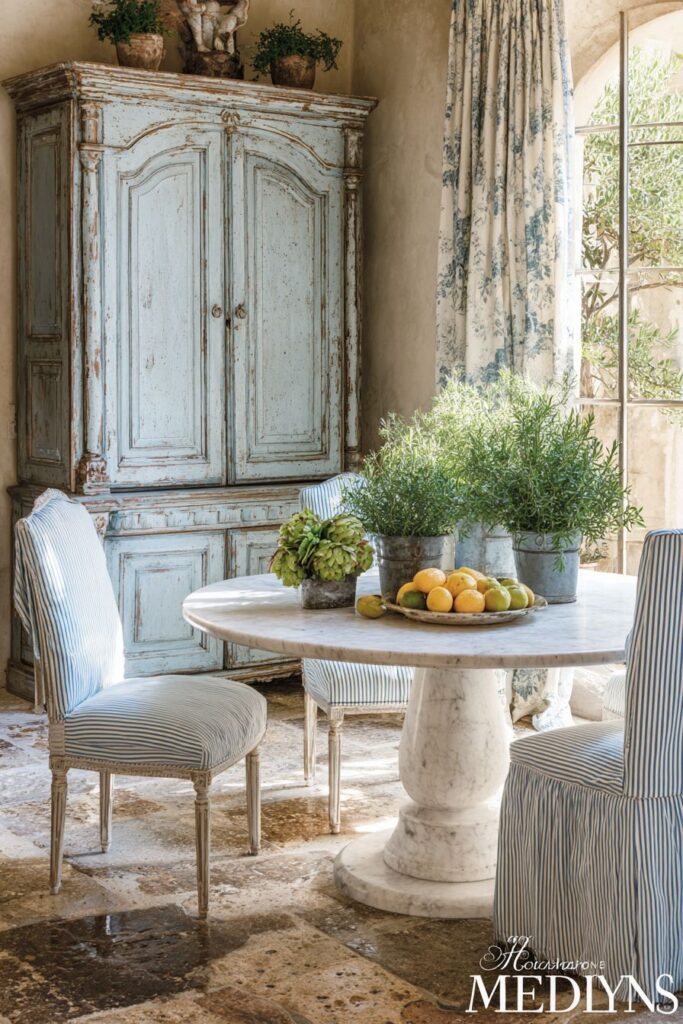
A vintage armoire serves multiple purposes in this sophisticated cottage dining room, providing both storage and display opportunities while adding architectural presence and French country authenticity. These substantial pieces, often passed down through generations, bring instant character and European provenance to cottage dining rooms. The armoire might house fine china, table linens, or serving pieces, keeping them protected yet accessible for special occasions and everyday use.
Toile curtains in soft blue frame tall windows, their pastoral scenes and traditional patterns reinforcing the French country connection while providing privacy and light control. The stone floor shows natural variation and beautiful wear patterns that speak to European cottage traditions, where stone floors were both practical and beautiful, improving with age and developing character through daily use.
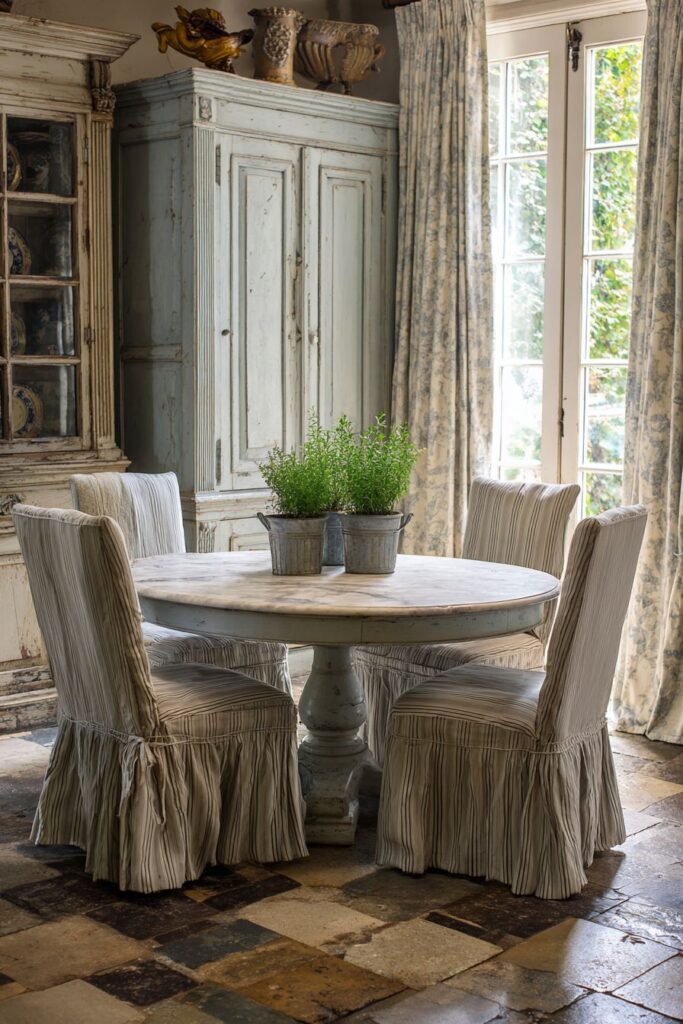
Key Design Tips:
- Mix materials thoughtfully: Combine marble, painted wood, and natural stone to create sophisticated yet approachable cottage elegance
- Invest in quality upholstery: Choose fabrics like ticking stripe that offer both comfort and timeless French country appeal
- Add architectural storage: Incorporate substantial pieces like armoires that provide storage while adding European cottage character
- Embrace natural floors: Consider stone flooring that develops beautiful patina and character through daily use
8. Bay Window Breakfast Nook
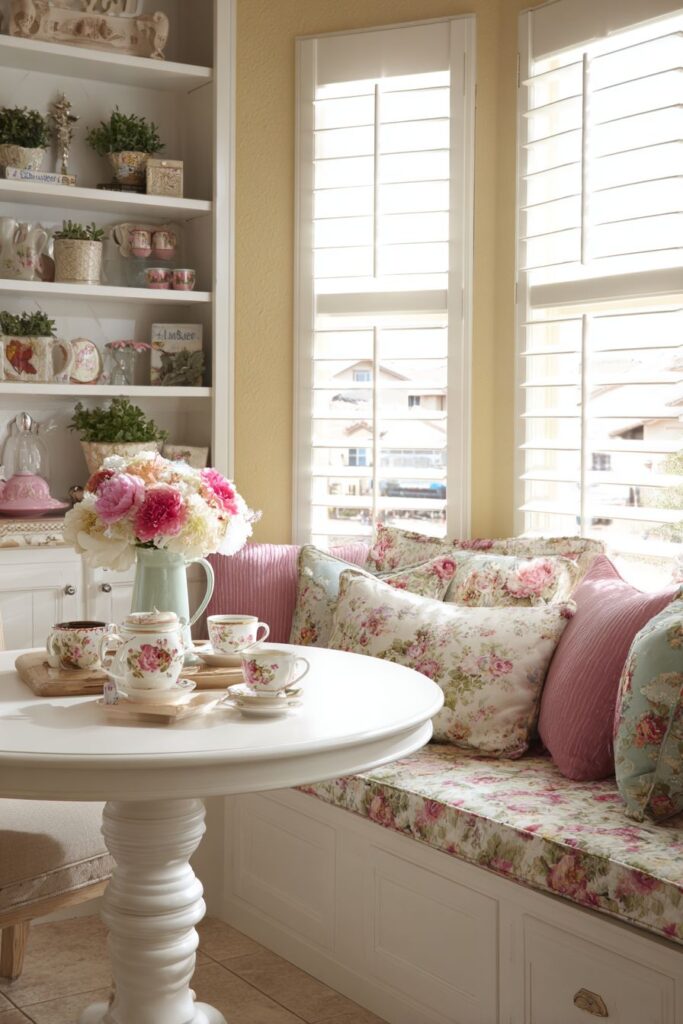
The cottage dining room reaches its most intimate and charming expression when designed as a bay window breakfast nook, where built-in bench seating maximizes the unique architectural opportunity while providing hidden storage underneath. This design approach transforms the bay window from simply a source of natural light into the room’s primary seating element, creating a breakfast nook that feels like a secret garden retreat within the home. The built-in benches, custom-fitted to the bay window’s curves, provide comfortable seating while utilizing every inch of available space.
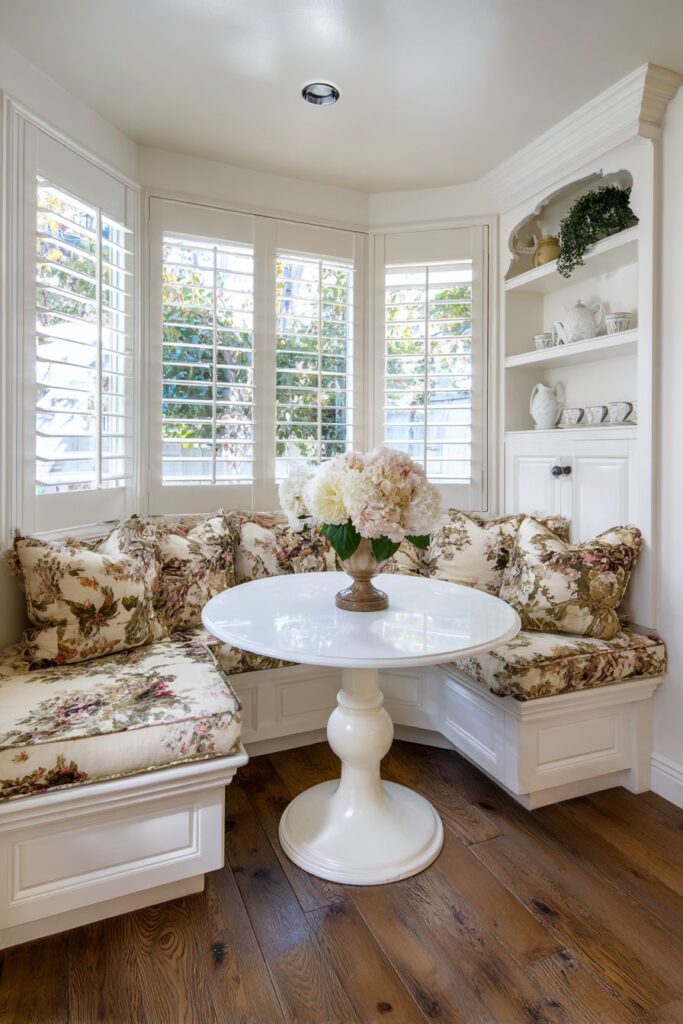
Cushions in vintage floral fabrics add both comfort and pattern to the bench seating, their soft colors and botanical motifs reinforcing the cottage connection to garden and countryside. These cushions, whether sewn from vintage fabrics or new materials with vintage appeal, create seating that invites relaxation and lingering. The floral patterns might include roses, lavender, or wildflowers, bringing the beauty of the cottage garden indoors through textile choices.
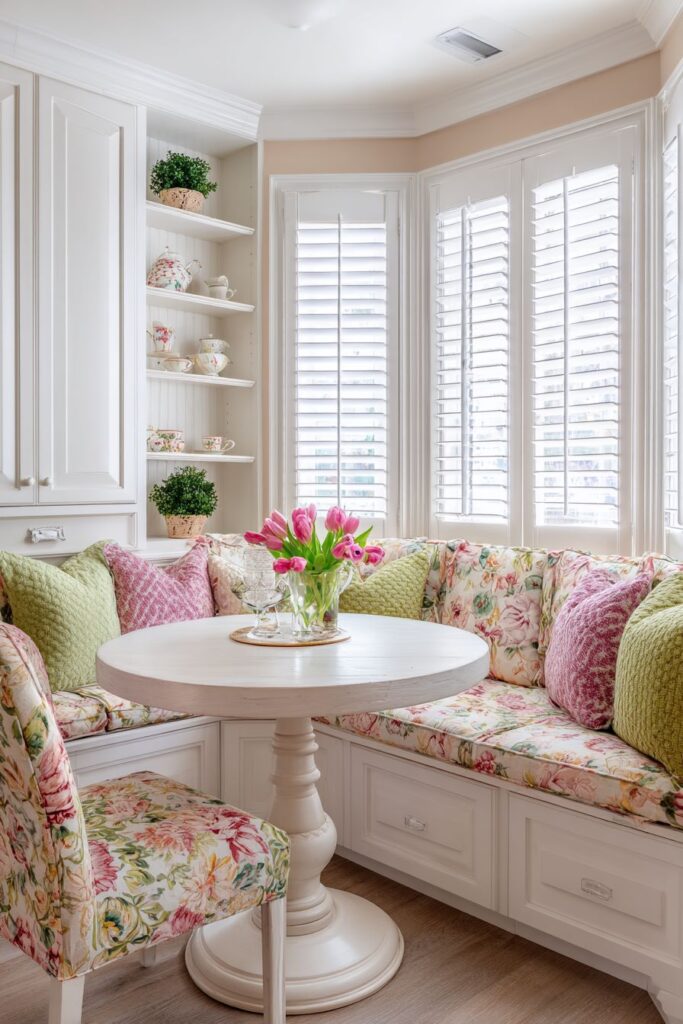
A small round table with pedestal base provides the perfect scale for this intimate dining space, its compact size ensuring easy movement while providing adequate surface area for breakfast, lunch, or afternoon tea. The pedestal base works particularly well in this application, as it allows for flexible seating arrangements and accommodates the curved bench seating without creating awkward leg placement issues.
Open shelving within the bay window area displays teacups and small plants, creating both functional storage and decorative appeal while taking advantage of the abundant natural light. These shelves might hold a collection of vintage teacups, small potted herbs, or seasonal decorative objects that personalize the space. Simple white shutters on the windows provide privacy options while maintaining the cottage aesthetic through their traditional styling and crisp white finish.
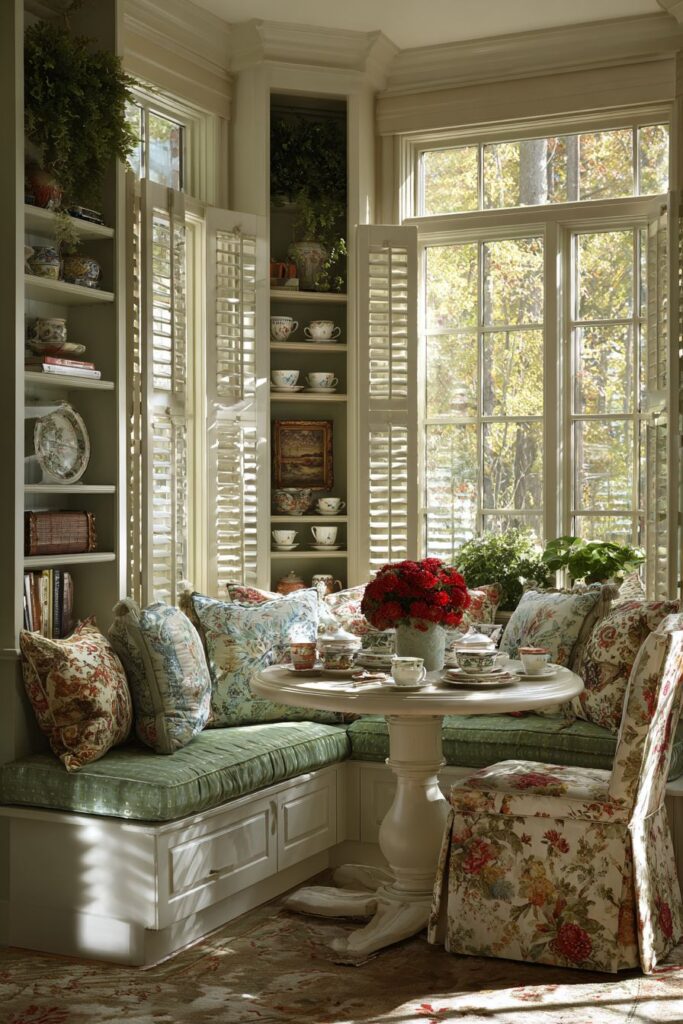
Key Design Tips:
- Maximize unique architecture: Take advantage of bay windows and other architectural features to create intimate dining spaces
- Incorporate hidden storage: Use built-in seating to create storage opportunities for dining essentials and seasonal items
- Choose appropriate scale: Select furniture that fits the intimate proportions of breakfast nook spaces
- Layer window treatments: Combine shutters with cushions and plants to create privacy while maximizing natural light
9. Authentic Antique Pine Character
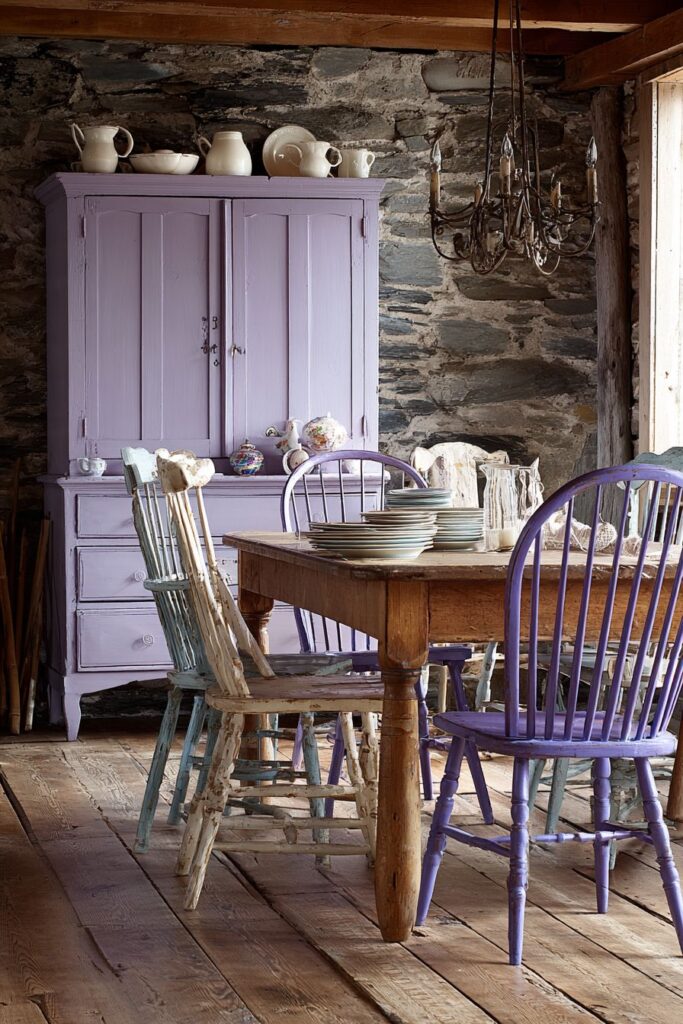
The cottage dining room achieves ultimate authenticity through an antique pine dining set that showcases honest wear and beautiful patina developed through generations of family use, its rectangular table bearing the gentle marks of countless meals and celebrations. This authentic piece, with its naturally aged finish and solid construction, represents the ideal cottage dining room centerpiece—beautiful, functional, and rich with character that cannot be manufactured or rushed. The pine’s honey-colored patina and gentle wear patterns create a surface that tells stories while providing a warm, welcoming foundation for daily dining.
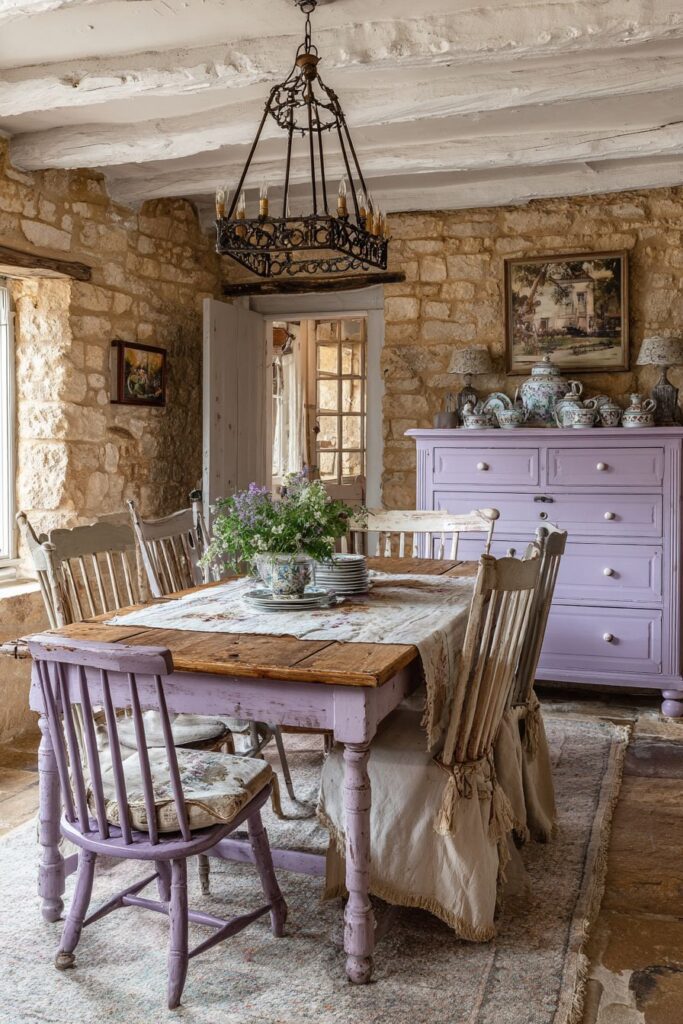
The mismatched vintage seating arrangement—featuring a Windsor chair, a ladder-back, and a spindle chair—creates an eclectic collection that demonstrates cottage style’s emphasis on personality over perfection. Each chair brings its own unique character and history to the dining experience, their different styles and finishes creating visual interest while providing comfortable seating options. This approach to seating reflects traditional cottage life, where furniture was collected over time as families grew and prospered, creating dining rooms with genuine personality and authentic charm.
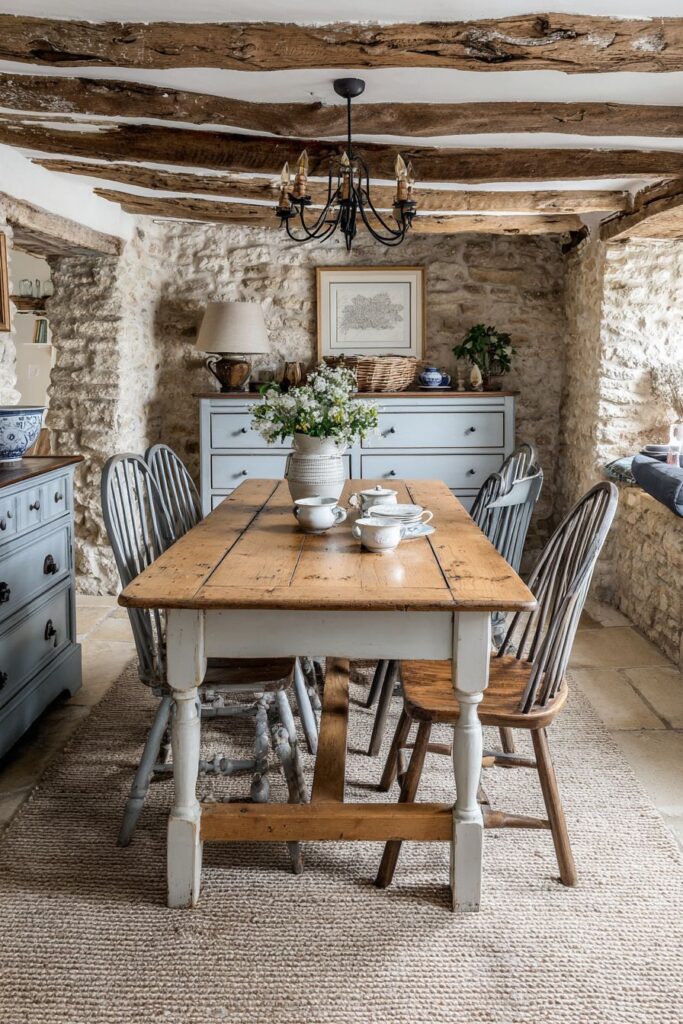
Against one wall, a Welsh dresser painted in soft lavender provides both storage and display opportunities while adding a gentle color accent to the predominantly natural wood palette. This painted piece demonstrates cottage style’s love of soft, garden-inspired colors while providing essential functionality for dishware and serving piece storage. The lavender paint color, inspired by cottage garden flowers, adds femininity and charm while remaining sophisticated enough for formal dining occasions.
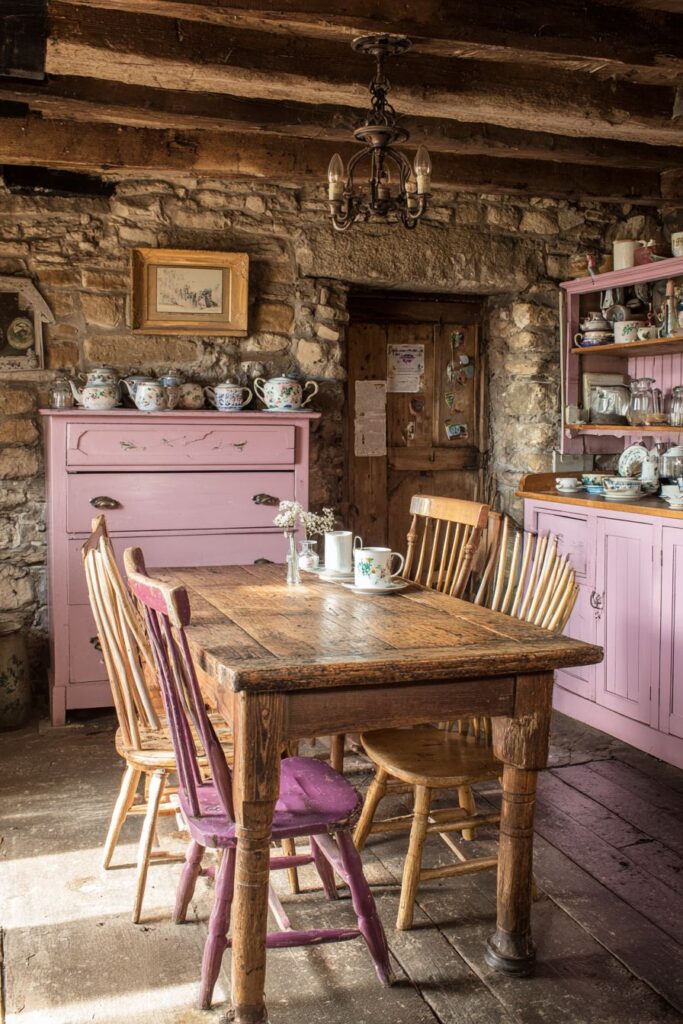
The exposed stone walls create rustic texture and authentic cottage atmosphere, their irregular surfaces and natural variations providing the perfect backdrop for the room’s antique furnishings. These walls, whether original to the structure or added for cottage authenticity, create the kind of architectural character that grounds cottage design in historical precedent and traditional building methods.
Key Design Tips:
- Invest in authentic pieces: Choose genuine antique furniture that brings real history and character to cottage dining rooms
- Embrace eclectic seating: Collect different chair styles over time to create interesting, personalized seating arrangements
- Add gentle color accents: Use soft, garden-inspired paint colors to highlight special pieces while maintaining natural material focus
- Incorporate architectural texture: Add or expose stone walls and other textural elements that reference cottage building traditions
10. Shabby Chic Romance
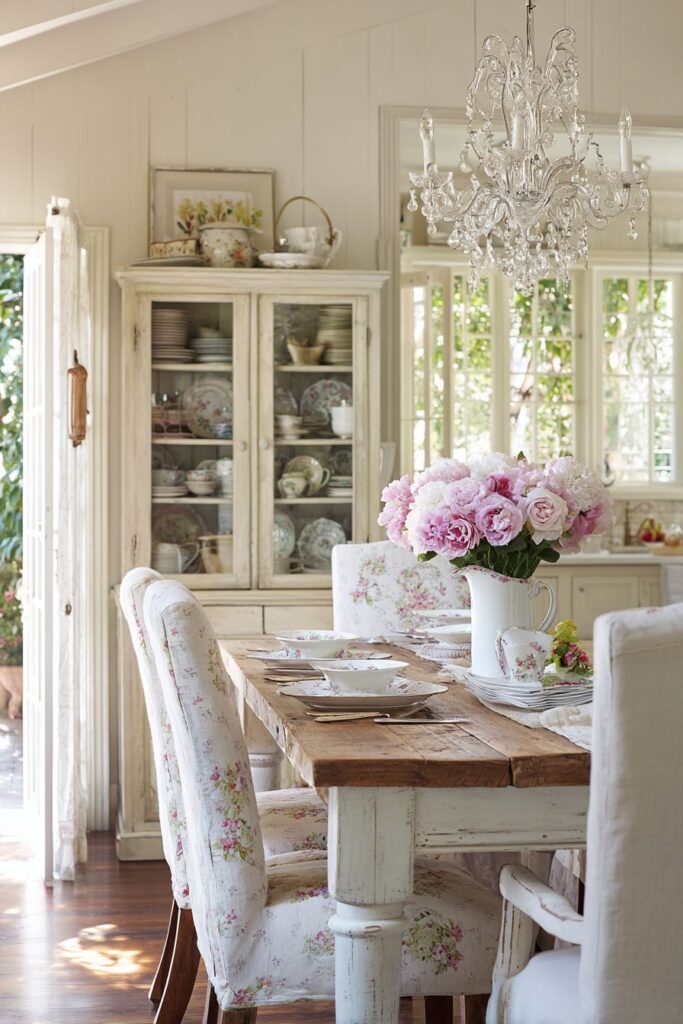
The cottage dining room embraces romantic femininity through shabby chic elements, beginning with a dining table painted in distressed white that reveals a natural wood top, creating the perfect balance between painted elegance and natural material beauty. This combination speaks to shabby chic style’s emphasis on gentle wear and romantic imperfection, where painted surfaces show honest use while natural wood provides warmth and character. The distressed white finish suggests years of loving use while maintaining the fresh, clean appeal essential to cottage dining rooms.
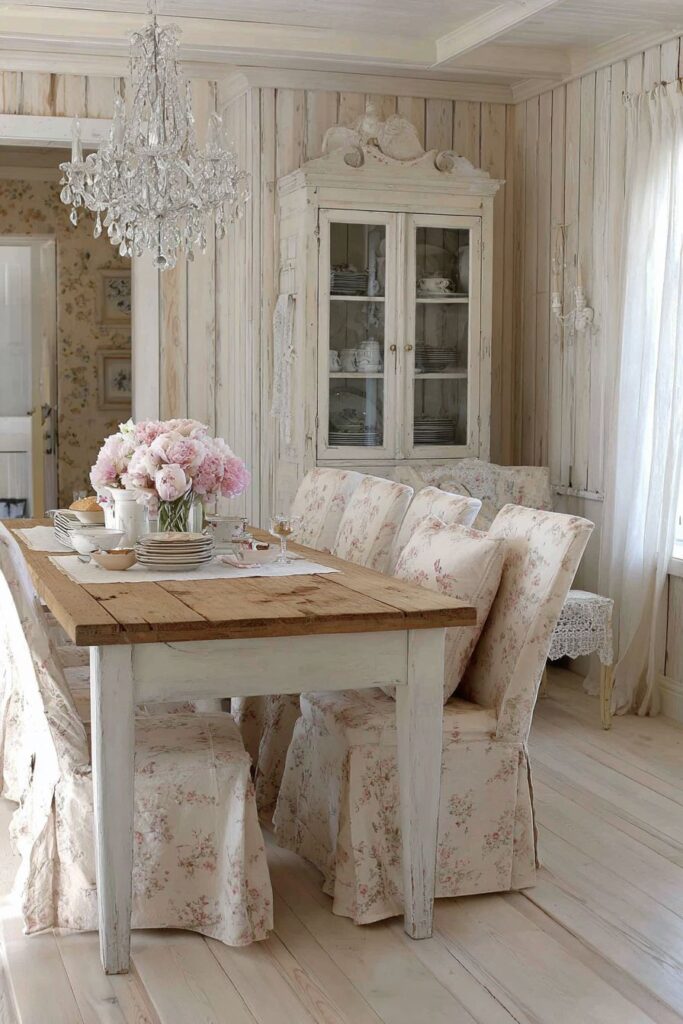
Slipcover chairs in faded floral linen surround this romantic table, their soft fabrics and garden-inspired patterns creating seating that feels like a summer garden party. These slipcovered chairs offer both practical benefits—easy cleaning and seasonal change options—and aesthetic appeal through their relaxed, comfortable styling. The faded floral patterns reference English cottage gardens while providing the soft, romantic atmosphere that defines shabby chic design.
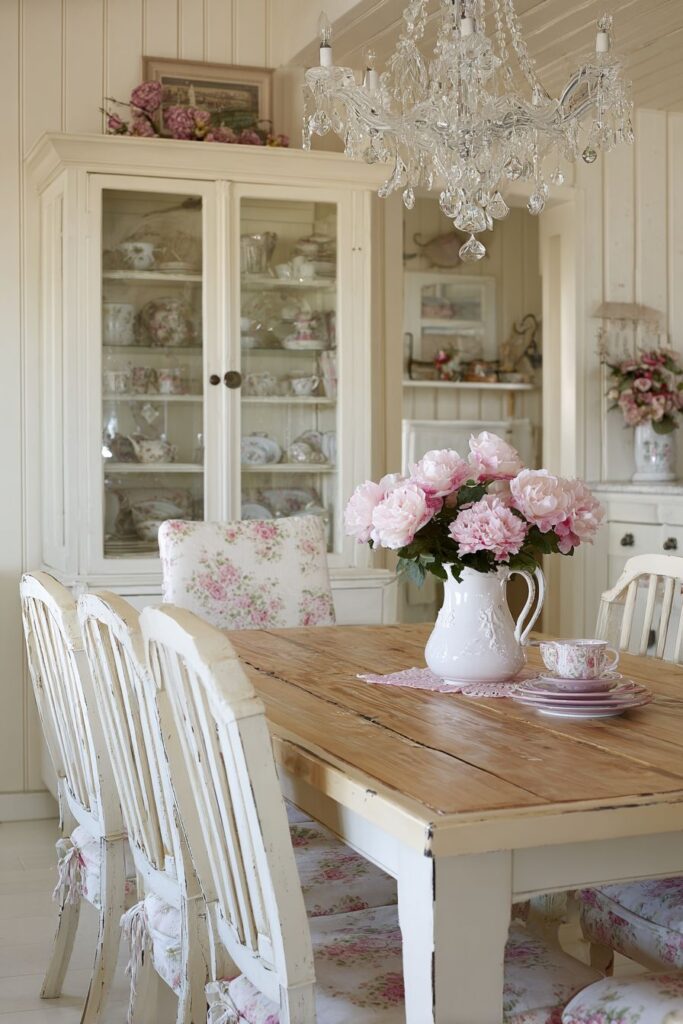
A vintage glass-front cabinet displays china collections, its transparent doors creating opportunities for beautiful displays while protecting precious dishware from dust and damage. This piece, with its graceful proportions and traditional styling, provides both functional storage and romantic cottage charm. The glass fronts allow for artistic arrangement of china patterns and serving pieces, creating displays that change with seasons and occasions.
Beadboard walls in soft cream create vertical interest and traditional cottage texture, their narrow planks and painted finish providing the perfect backdrop for romantic shabby chic furnishings. Above the dining table, a crystal chandelier adds unexpected elegance, its sparkling facets creating beautiful light patterns while elevating the cottage dining room from rustic to romantic. Fresh peonies in a transferware pitcher provide natural centerpieces that celebrate the romantic, garden-inspired aesthetic.
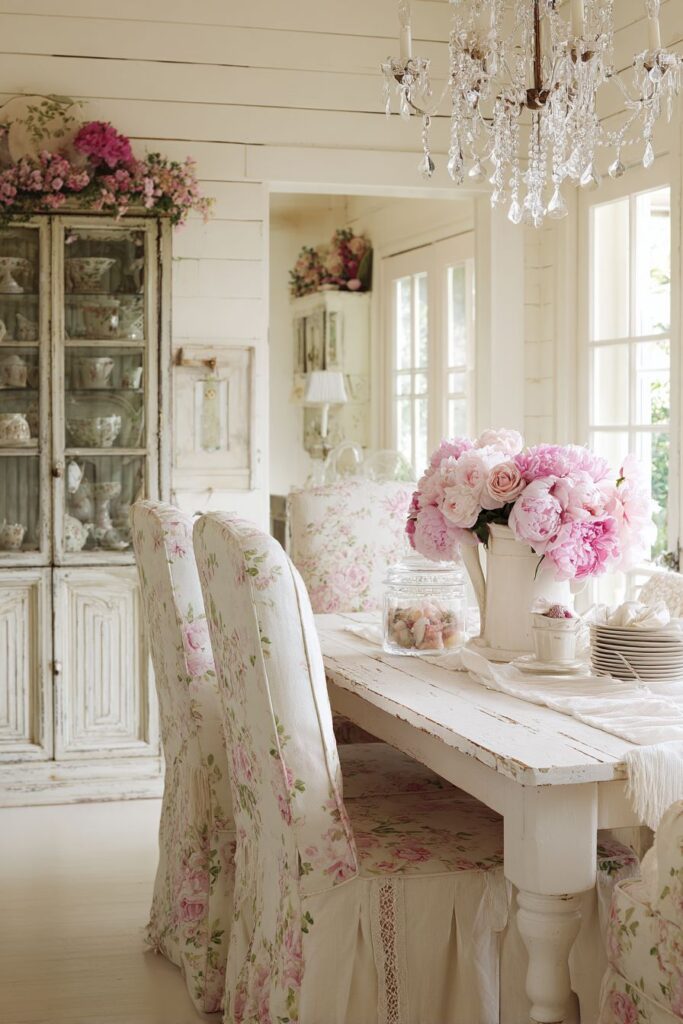
Key Design Tips:
- Balance painted and natural finishes: Combine distressed painted surfaces with natural wood to create romantic yet authentic appeal
- Choose soft, feminine fabrics: Use faded florals and gentle patterns to create romantic, garden-inspired seating
- Display collections behind glass: Protect and showcase china collections in glass-front cabinets for both beauty and functionality
- Add unexpected elegance: Incorporate crystal or other refined elements to elevate cottage charm with romantic sophistication
11. Scandinavian Simplicity
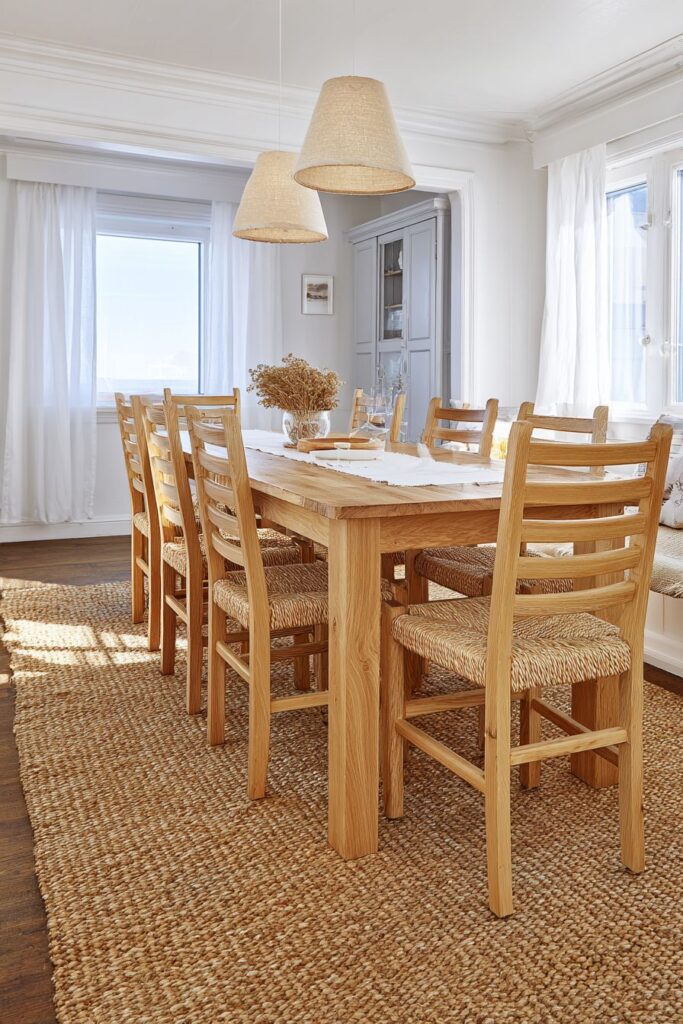
The cottage dining room takes inspiration from Scandinavian design principles through a light oak dining table with clean lines and natural wood finish that celebrates the beauty of simplified form and honest materials, creating a space that feels both contemporary and timeless. This Nordic influence brings a sense of calm and order to cottage design while maintaining the warmth and comfort essential to successful dining spaces. The light oak finish provides gentle warmth while the clean lines create visual serenity that makes the dining room feel like a peaceful retreat.
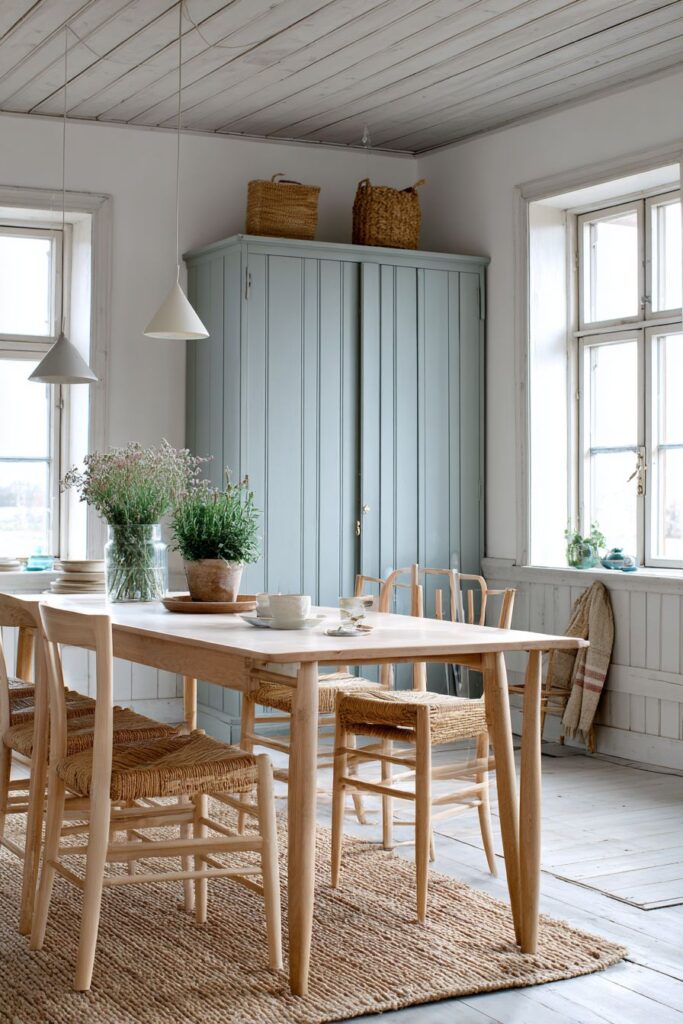
Simple wooden chairs with woven rush seats maintain the minimalist aesthetic while providing comfortable seating that references traditional Scandinavian craftsmanship, their honest construction and natural materials creating furniture that improves with age and use. These chairs, with their clean lines and organic textures, provide the perfect balance between comfort and visual simplicity. The rush seats add natural texture while remaining neutral enough to work with changing seasonal decor.
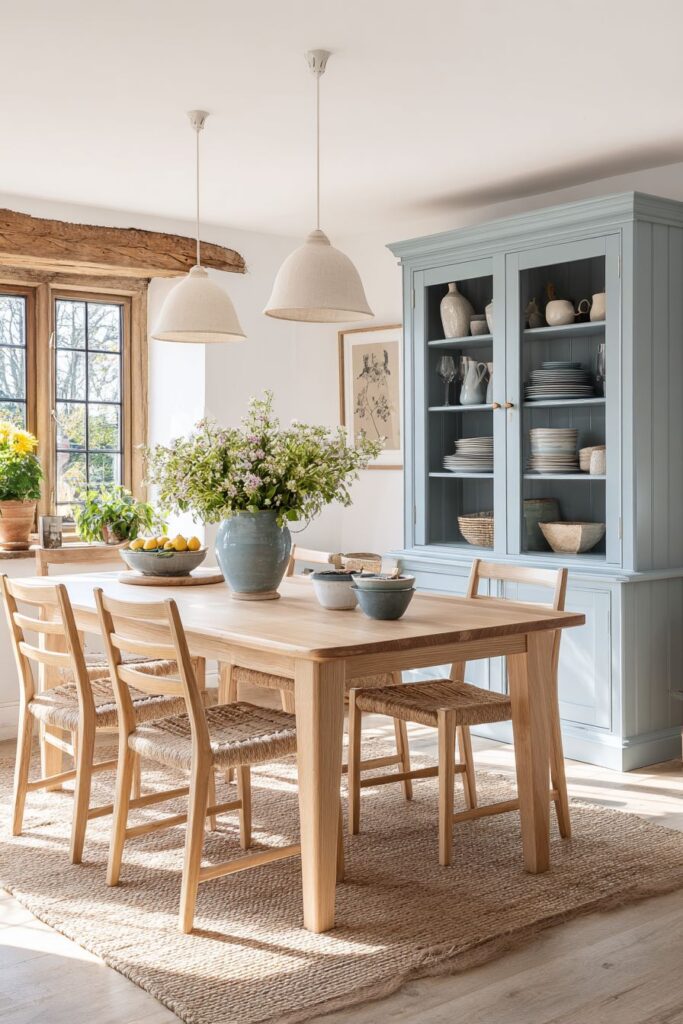
A painted cupboard in soft grey-blue provides essential storage while adding a gentle color note to the predominantly natural palette, its simplified styling and beautiful proportions demonstrating Scandinavian design’s emphasis on functionality and understated beauty. This storage piece might house everyday dishes, table linens, or serving pieces, keeping them organized and accessible while maintaining the room’s serene, uncluttered appearance.
White walls with natural wood trim create a clean, fresh backdrop that maximizes natural light while adding architectural interest through the contrast of painted and natural surfaces. This combination creates visual depth without overwhelming the simplified aesthetic. Pendant lights with linen shades provide gentle illumination that enhances the room’s peaceful atmosphere, while a jute rug grounds the space naturally with its organic texture and neutral color.
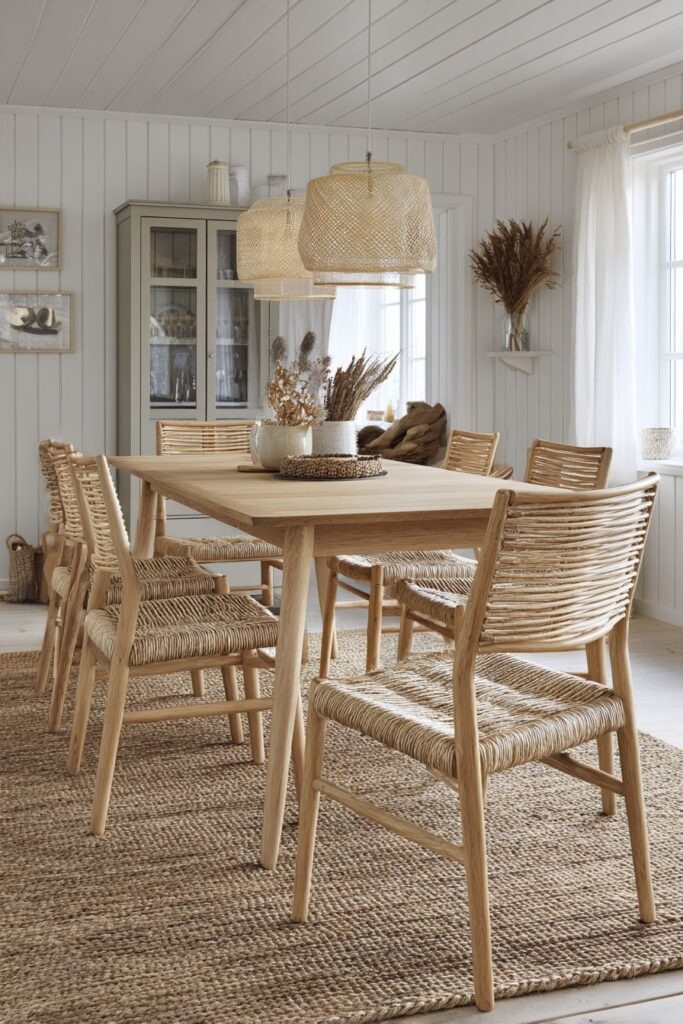
Key Design Tips:
- Embrace clean lines: Choose furniture with simplified forms that celebrate natural materials and honest construction
- Use minimal color palettes: Focus on natural wood tones with gentle accent colors for serene, timeless appeal
- Maximize natural light: Use white walls and minimal window treatments to create bright, airy dining spaces
- Choose organic textures: Incorporate natural materials like rush, linen, and jute to add warmth to simplified designs
12. Family-Friendly Farmhouse Function
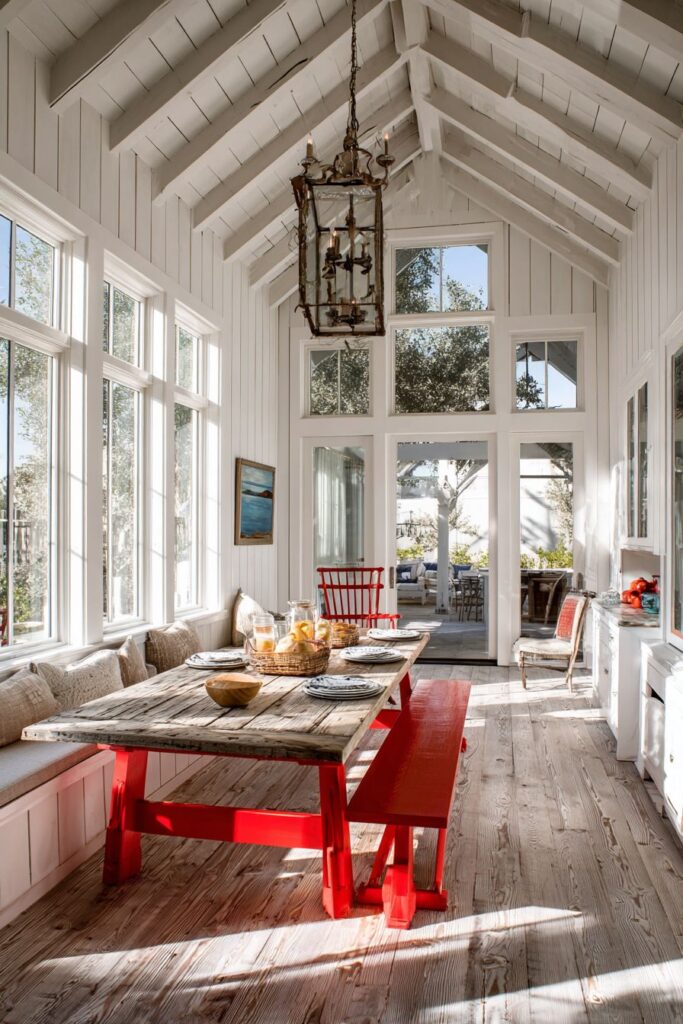
The cottage dining room designed for family life centers around a farmhouse-style trestle table with thick planked top and painted base in barn red, creating a substantial piece that can withstand daily family use while maintaining authentic cottage charm and character. This robust table, with its generous proportions and solid construction, provides the perfect foundation for family meals, homework sessions, and craft projects. The thick planked top celebrates traditional construction methods while providing a durable surface that improves with use and develops character through daily family life.
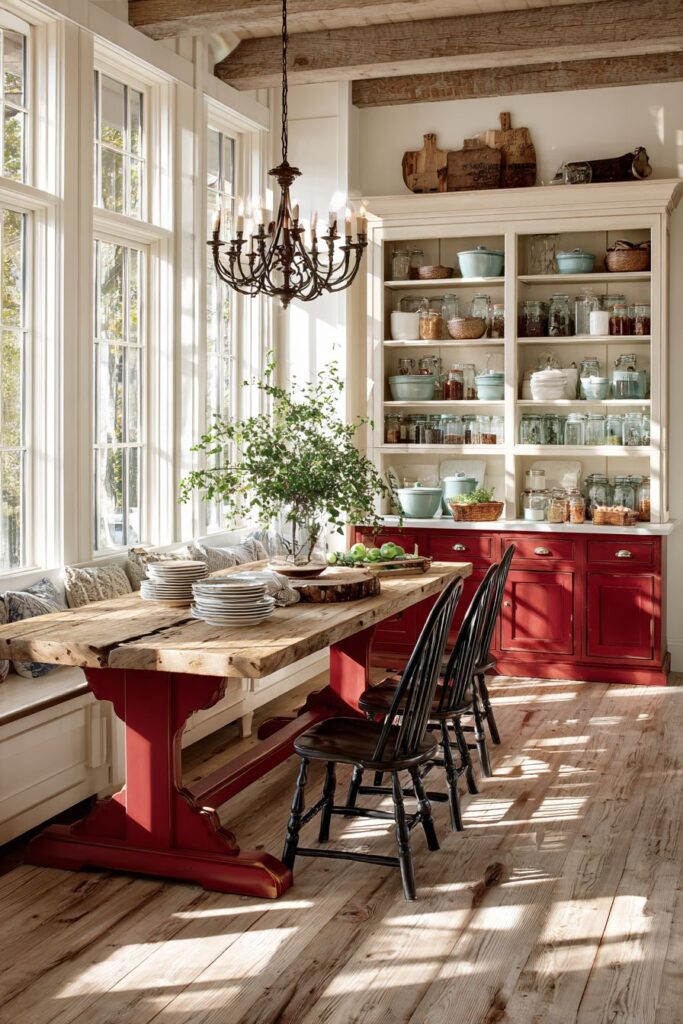
Bench seating on one side of the table accommodates families efficiently while creating the casual, welcoming atmosphere essential to family-friendly cottage design, supplemented by Windsor chairs that complete the seating arrangement with traditional cottage charm. The combination of bench and individual chair seating provides flexibility for different family sizes and dining occasions, while the bench creates opportunities for siblings to sit together and parents to easily assist young children during meals.
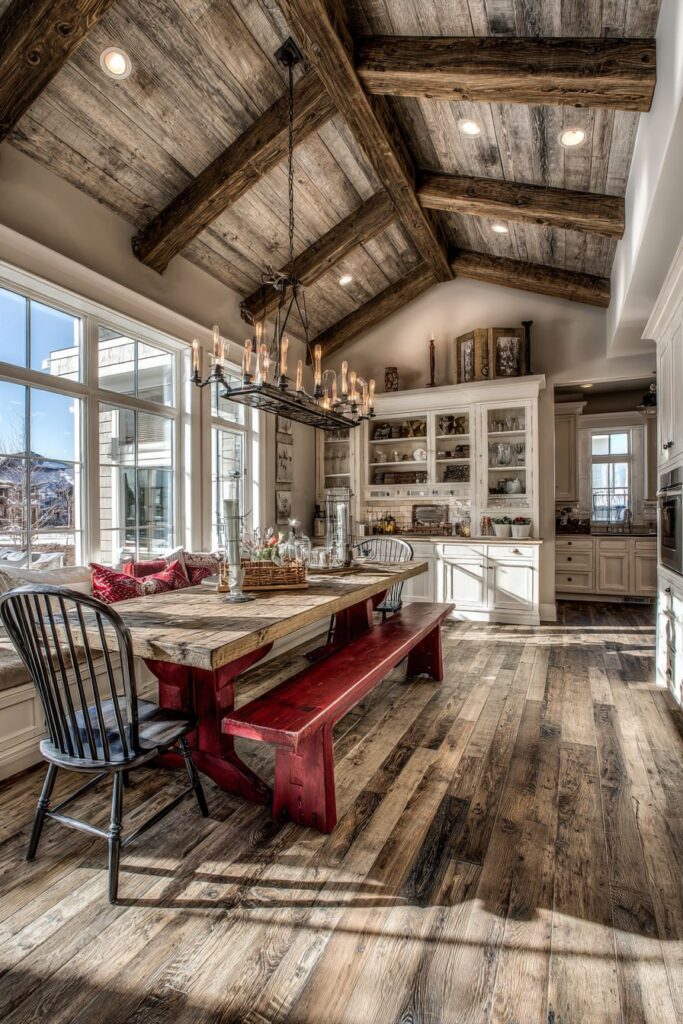
A large hutch displays everyday dishes and preserving jars, creating both functional storage and visual interest through collections that speak to family life and cottage traditions like home preserving and seasonal cooking. This substantial storage piece provides organization for the dishes, glasses, and serving pieces needed for family dining while creating display opportunities for collections that personalize the space and reflect family interests and traditions.
Wide-plank floors show natural wear patterns that speak to authentic family living, where beauty is found in the honest marks of daily life rather than pristine perfection that would be impossible to maintain with active family life. These floors, with their generous proportions and natural variations, provide the perfect foundation for family dining while developing character through the patterns of daily use. Above the table, a wrought iron chandelier provides essential lighting while adding rustic cottage charm that coordinates with the room’s authentic, family-friendly aesthetic.
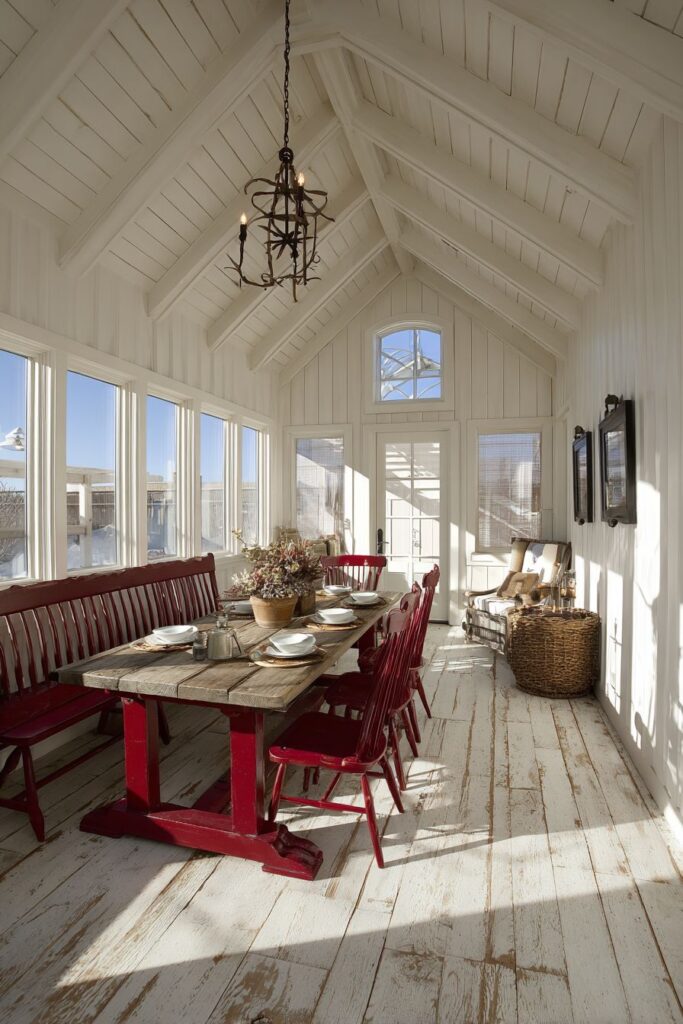
Key Design Tips:
- Choose durable materials: Select furniture and finishes that can withstand daily family use while maintaining cottage charm
- Incorporate flexible seating: Combine benches and chairs to accommodate different family sizes and dining occasions
- Prioritize functional storage: Use hutches and built-ins to organize family dining essentials while creating attractive displays
- Embrace honest wear: Allow floors and furniture to show gentle signs of family use rather than pursuing impractical perfection
13. English Country Garden Romance
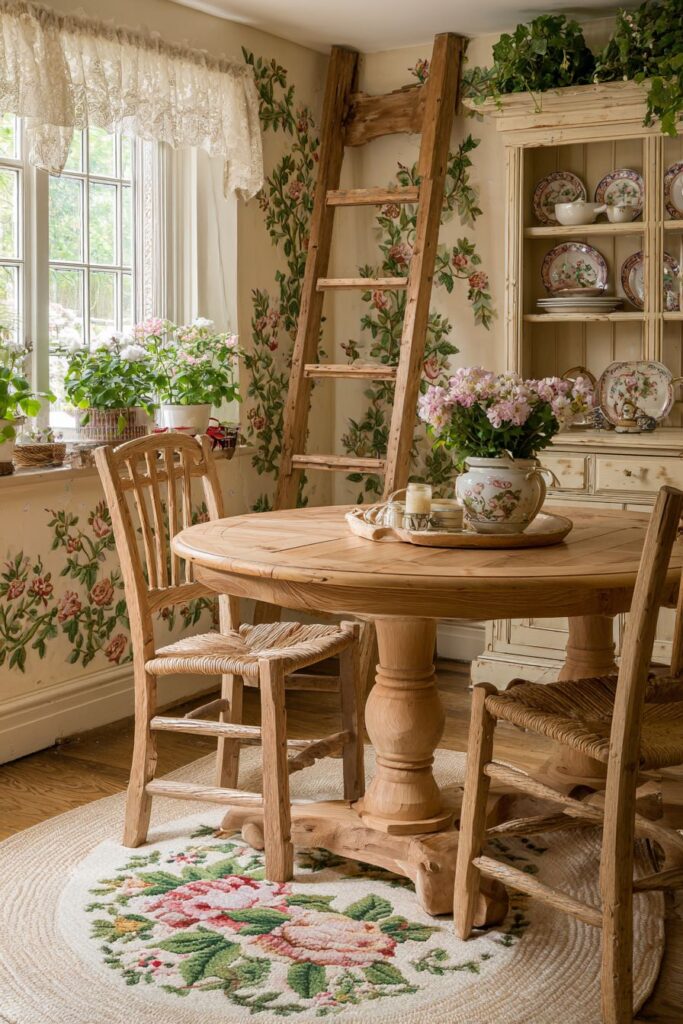
The cottage dining room channels English country garden romance through a gate-leg table in natural oak with drop leaves that provide dining flexibility while referencing traditional English cottage furniture craftsmanship and ingenuity. This classic piece, with its folding leaves and compact storage potential, represents the best of English cottage design—beautiful, functional, and perfectly scaled for intimate cottage dining rooms. The natural oak finish showcases beautiful wood grain while developing a rich patina through years of use and careful maintenance.
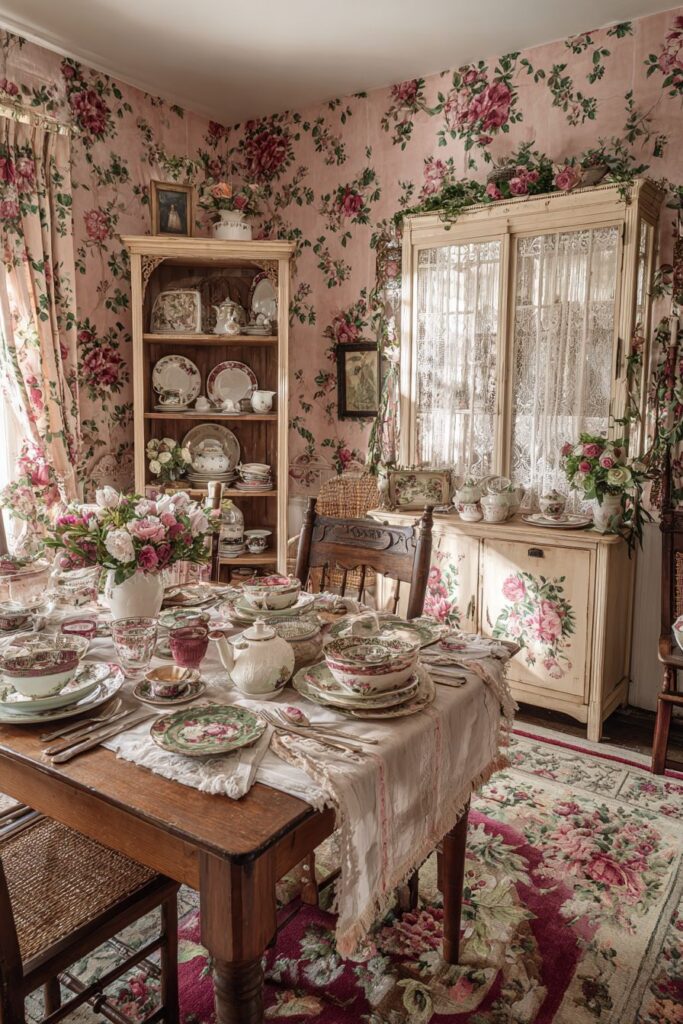
Ladderback chairs with rush seats maintain traditional English cottage styling while providing comfortable seating that references centuries of cottage craftsmanship, their honest construction and natural materials creating furniture that feels authentic and timeless. These chairs, with their distinctive back design and woven seats, provide both visual interest and comfortable seating that improves with age and use. The rush seats add natural texture and traditional craft techniques that reinforce the cottage connection to countryside traditions.
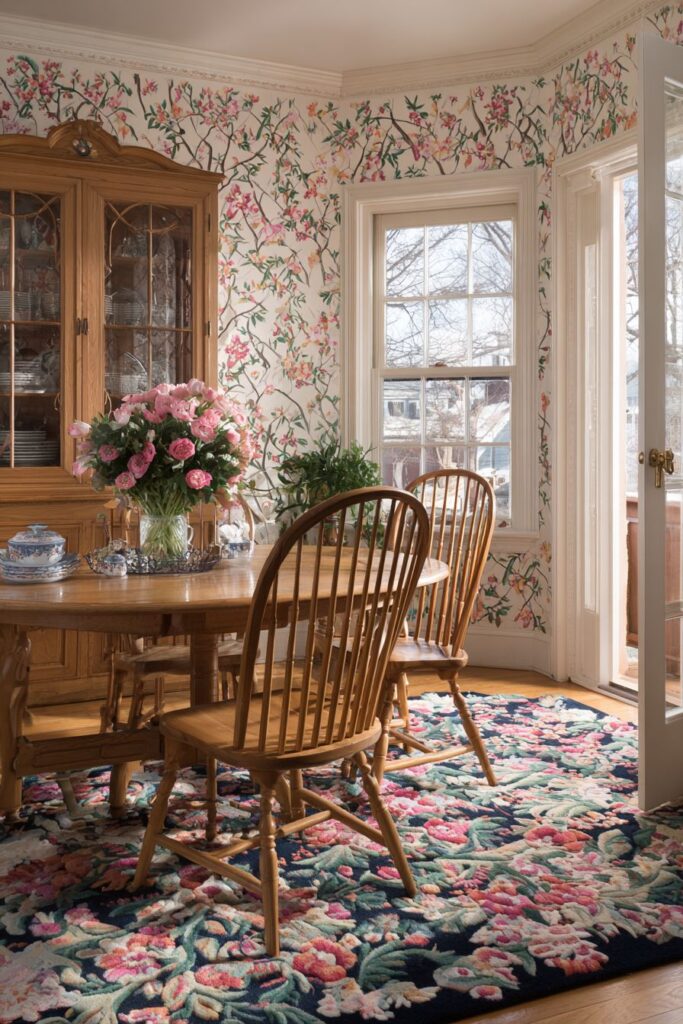
A painted corner cupboard displays floral china collections, its triangular design making efficient use of corner space while providing beautiful display opportunities for treasured dishware patterns that reference English cottage garden flowers and countryside motifs. This clever storage solution demonstrates cottage ingenuity in making the most of available space while creating opportunities for personal expression through curated collections of meaningful objects.
Botanical wallpaper with climbing roses creates a garden-like atmosphere that brings the romance of English cottage gardens indoors, while lace panels filter window light softly to create the gentle, romantic illumination perfect for intimate dining occasions. The wallpaper pattern, with its climbing roses and garden motifs, creates an immersive environment that makes diners feel like they’re enjoying meals in a secret garden pavilion.
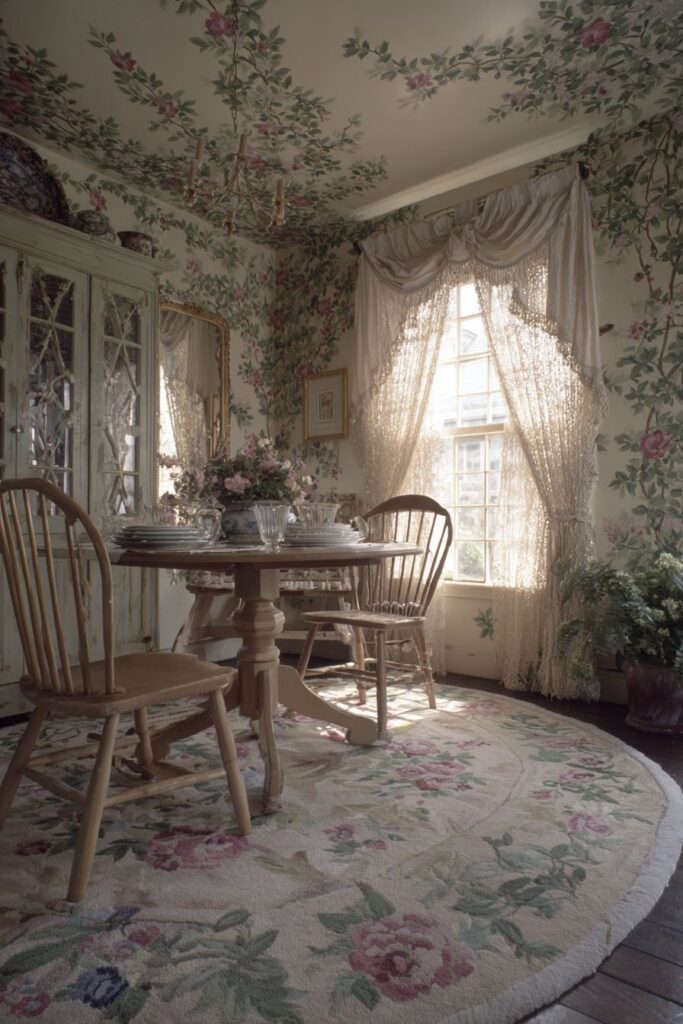
Key Design Tips:
- Choose traditional English pieces: Invest in furniture styles like gate-leg tables that reference authentic English cottage traditions
- Create garden atmospheres: Use botanical wallpapers and floral patterns to bring cottage garden romance indoors
- Maximize corner spaces: Use corner cupboards and other space-efficient pieces to make the most of compact cottage dining rooms
- Filter light romantically: Use lace or other delicate window treatments to create soft, romantic dining illumination
14. Industrial Cottage Fusion
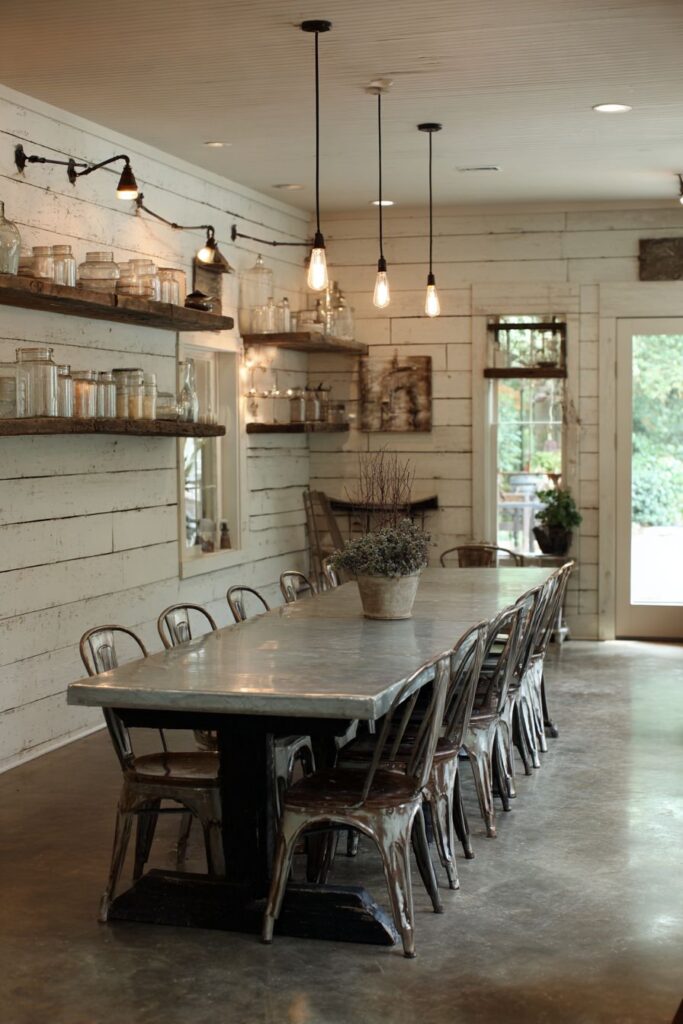
The cottage dining room takes an unexpected turn through industrial influences, featuring a converted farmhouse table with zinc top that brings durability and contemporary edge to traditional cottage charm, creating a unique aesthetic that speaks to modern cottage living while maintaining connection to traditional materials and forms. This zinc-topped table represents the perfect fusion of cottage practicality with industrial durability, its metal surface providing easy maintenance for busy family life while the farmhouse base maintains cottage authenticity and charm.
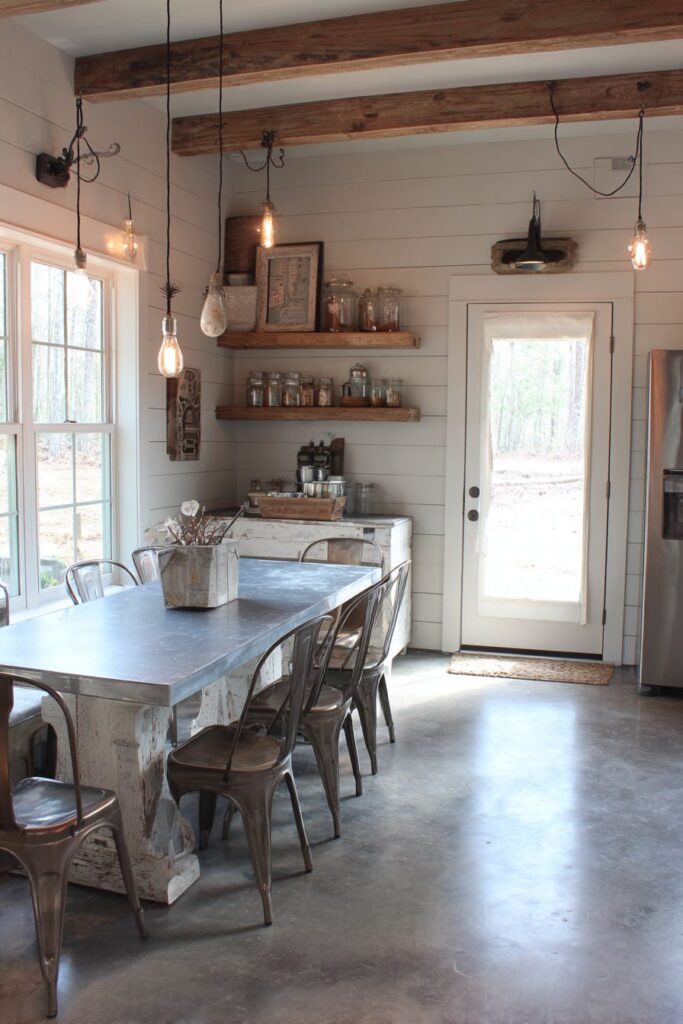
Industrial-style metal chairs with worn paint finishes provide seating that bridges cottage and industrial aesthetics, their honest construction and weathered surfaces creating furniture that tells stories of use and time while providing comfortable, durable seating for daily dining. These chairs, with their mixed materials and authentic wear patterns, demonstrate how cottage style can incorporate unexpected elements while maintaining its essential character and warmth.
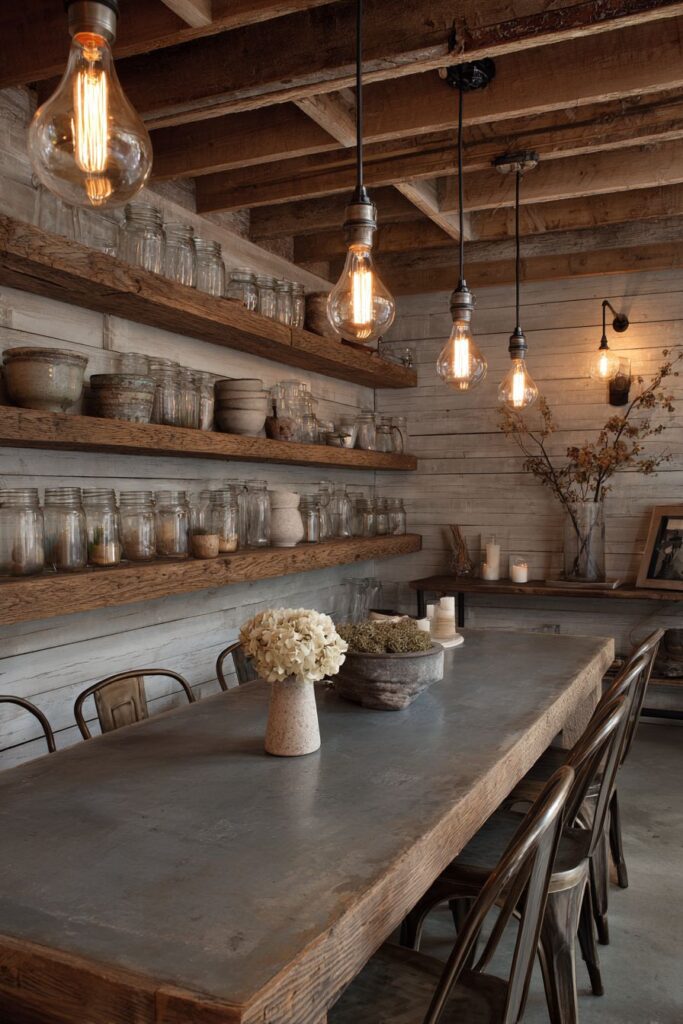
Open shelving made from reclaimed lumber displays ironstone and mason jars, creating storage that celebrates both cottage traditions and industrial materials through the combination of rustic wood and utilitarian dishware and storage vessels. This shelving system provides both functional storage and visual interest while demonstrating cottage style’s adaptability to different material palettes and aesthetic influences.
Shiplap walls painted in soft grey create textural interest while providing a neutral backdrop for the room’s mixed materials and industrial elements, their horizontal lines adding visual movement while maintaining cottage charm. Edison bulb fixtures hanging from iron pipes add functional lighting with industrial character that complements the table’s zinc top while providing the warm, atmospheric lighting essential to successful cottage dining rooms.
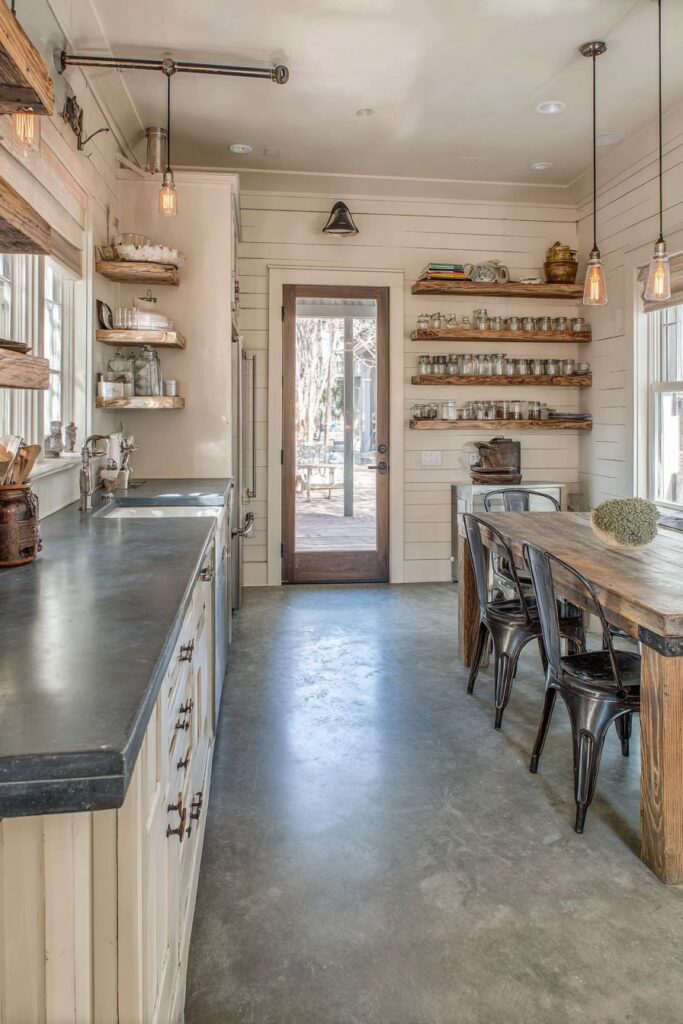
Key Design Tips:
- Mix unexpected materials: Combine industrial elements like zinc and metal with traditional cottage materials for unique, personalized spaces
- Embrace authentic wear: Choose furniture and fixtures that show honest signs of use and time rather than artificial distressing
- Balance hard and soft elements: Use neutral paint colors and natural textures to soften industrial materials in cottage settings
- Create cohesive lighting: Choose fixtures that bridge industrial and cottage aesthetics while providing warm, atmospheric illumination
15. Mediterranean Cottage Warmth
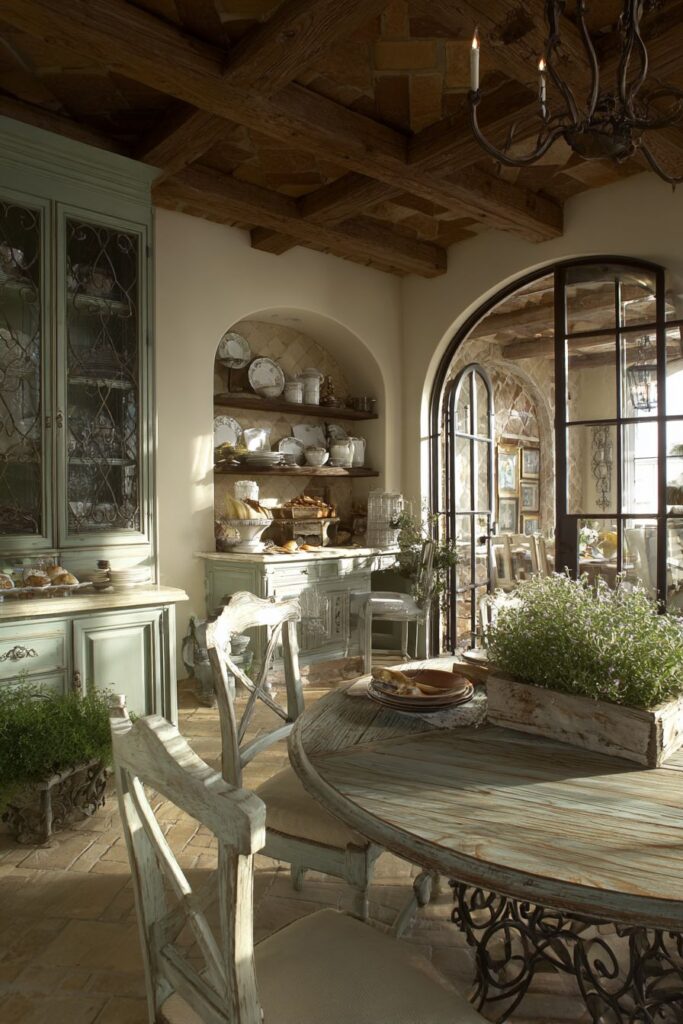
The cottage dining room embraces Mediterranean influences through a round table with wrought iron base and weathered wood top that brings European warmth and Old World charm to cottage living, creating a dining space that feels like a Mediterranean villa terrace brought indoors. This combination of materials—the strength and artistry of wrought iron paired with weathered wood’s natural beauty—creates furniture that feels both substantial and romantic, perfect for long, leisurely meals with family and friends.
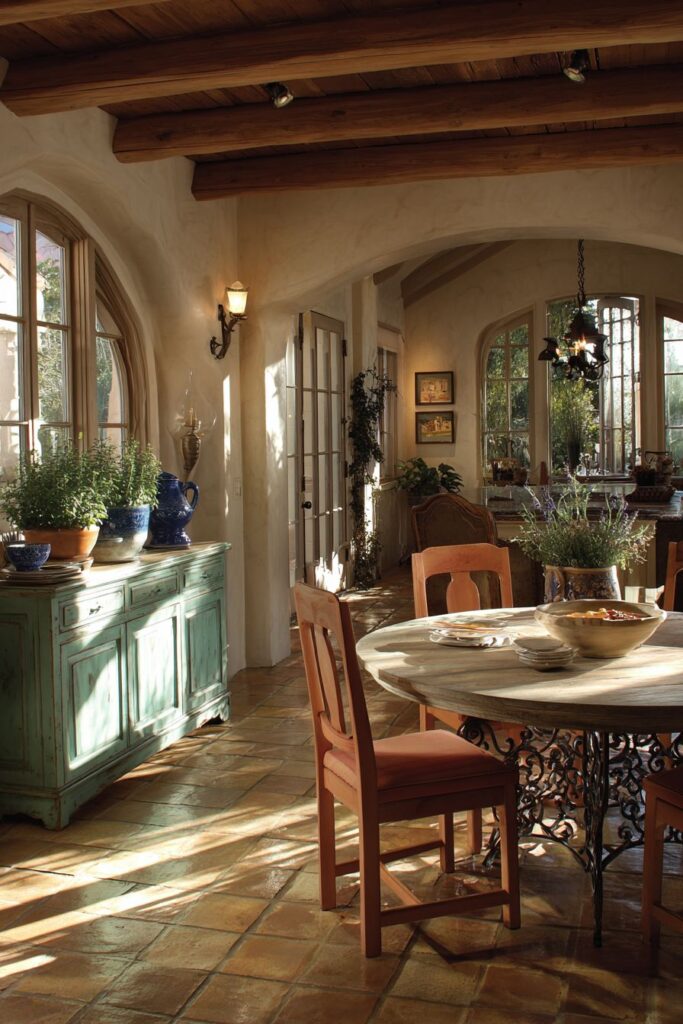
Painted wooden chairs in soft terra cotta and sage create a warm, earth-inspired color palette that references Mediterranean landscapes while providing comfortable seating that invites lingering over meals and conversation. These colors, inspired by Mediterranean ceramics and countryside vegetation, bring warmth and sophistication to cottage dining while remaining soft enough to maintain cottage charm and comfort.
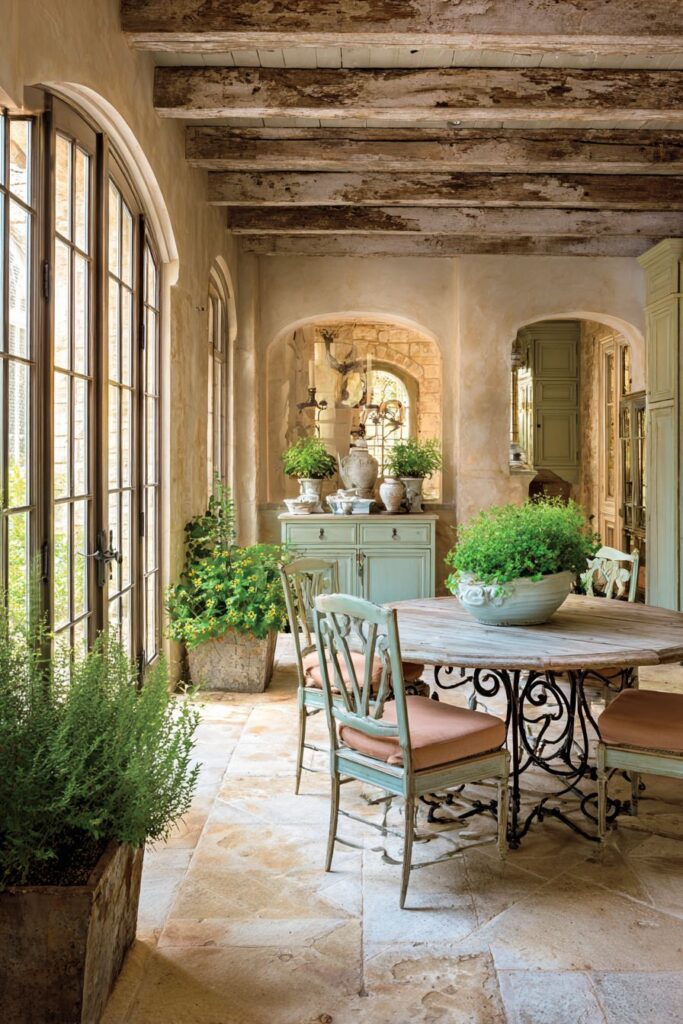
A vintage sideboard displays ceramic serving pieces, its generous proportions and traditional styling providing both functional storage and opportunities for displaying collections of pottery and serving ware that reinforce the Mediterranean cottage aesthetic through their earthy colors and handcrafted appeal. This storage piece grounds the dining room design while providing essential functionality for serving and entertaining.
Exposed ceiling beams and terra cotta tile flooring add significant architectural interest that references Mediterranean building traditions while creating the kind of textural richness that makes cottage dining rooms feel layered and authentic. The beams provide visual weight and traditional charm while the tile flooring offers practical durability with beautiful color and texture variations. Herb gardens in galvanized planters bring nature indoors while providing fresh cooking ingredients that enhance both the cottage connection to gardening and the Mediterranean emphasis on fresh, flavorful cuisine.
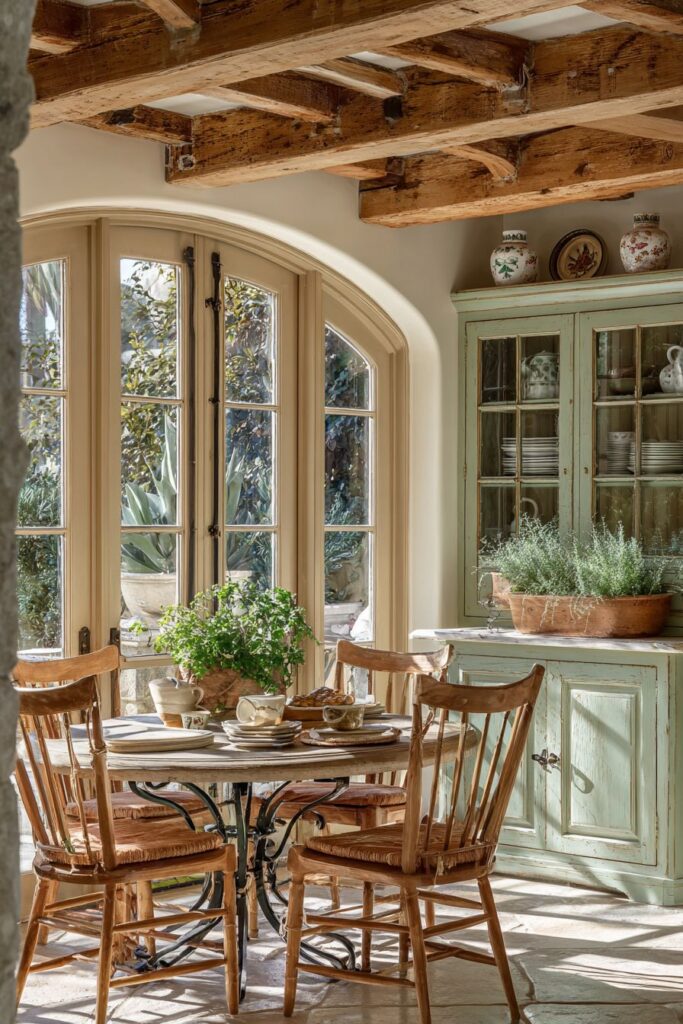
Key Design Tips:
- Incorporate Mediterranean materials: Use wrought iron, weathered wood, and terra cotta to create warm, Old World cottage charm
- Choose earth-inspired colors: Select paint colors that reference Mediterranean landscapes for warm, sophisticated cottage appeal
- Add architectural elements: Include exposed beams and tile flooring to create textural interest and authentic cottage character
- Bring gardens indoors: Use herb gardens and other plants to connect cottage dining rooms with gardening traditions and fresh cuisine
16. Harvest Table Heritage
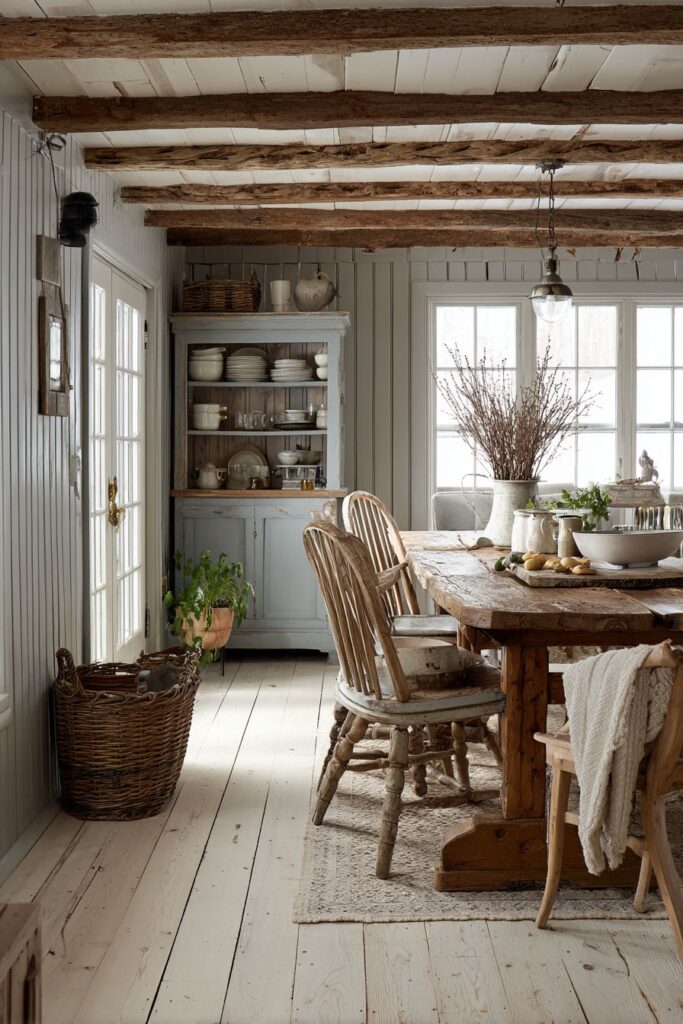
The cottage dining room celebrates traditional craftsmanship through a harvest table made from chestnut with natural edge detail and visible wood grain that showcases the beauty of working with natural materials while honoring traditional woodworking techniques and cottage furniture heritage. This magnificent piece, with its live-edge detail and rich chestnut coloring, represents the pinnacle of cottage dining room furniture—beautiful, substantial, and rich with natural character that improves with age and use.
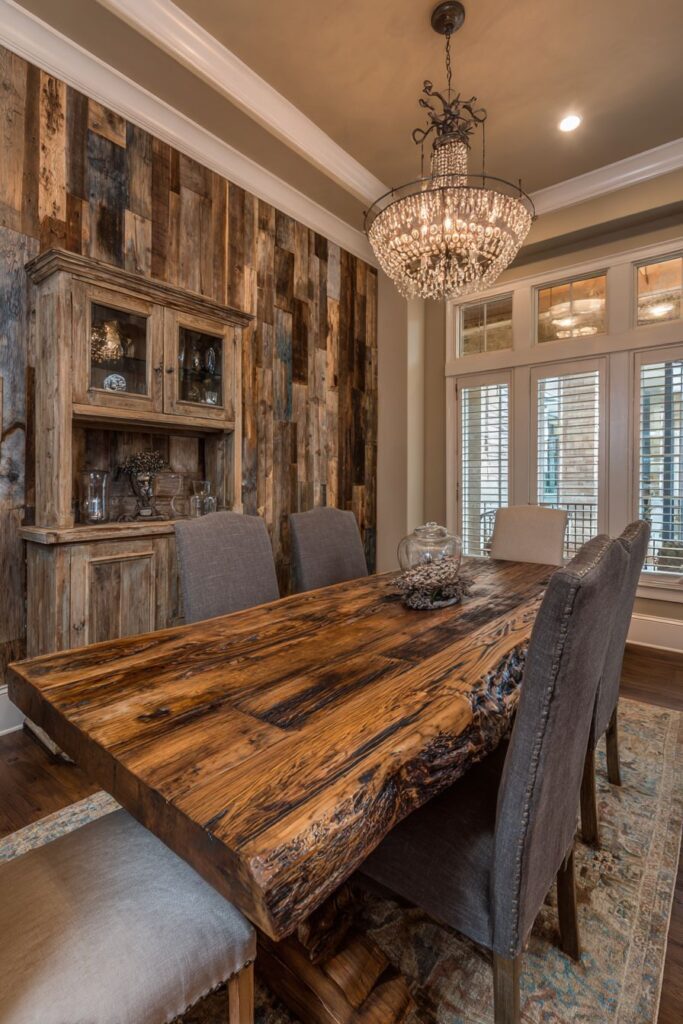
Mismatched antique chairs create a seating arrangement where each piece tells its own story through unique wear patterns and original paint, demonstrating cottage style’s emphasis on authentic collecting over matching furniture sets while providing comfortable seating that engages guests and encourages appreciation for traditional craftsmanship. These chairs, gathered over time from different sources and periods, create a dining room that feels collected and loved rather than purchased all at once.
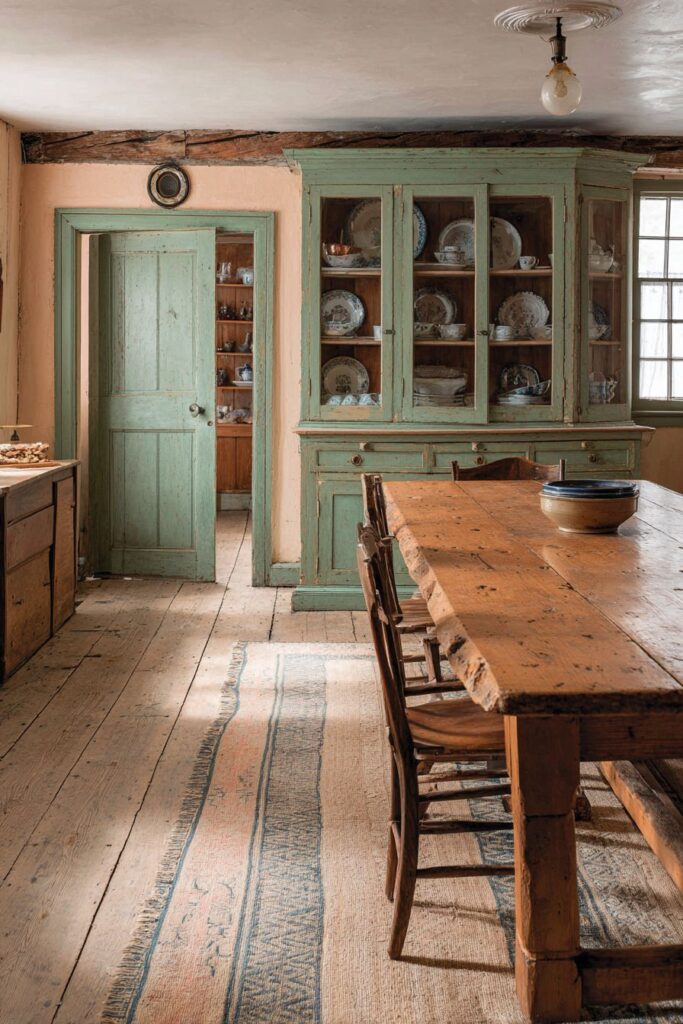
A painted corner cupboard in milk paint displays everyday dishes and glassware, its traditional finish and authentic construction techniques representing the best of American cottage furniture traditions while providing essential storage and display functionality. Milk paint, with its organic composition and authentic finish, creates the kind of genuine patina that speaks to cottage authenticity and traditional building methods.
Board and batten walls create vertical texture and authentic cottage architecture, their traditional construction method and painted finish providing visual interest while referencing historical cottage building techniques. This wall treatment adds architectural character while providing a beautiful backdrop for the room’s antique furnishings. Simple iron fixtures provide lighting that complements the room’s authentic materials while hand-hooked rugs in muted colors warm the wide-plank floors with traditional textile craftsmanship.
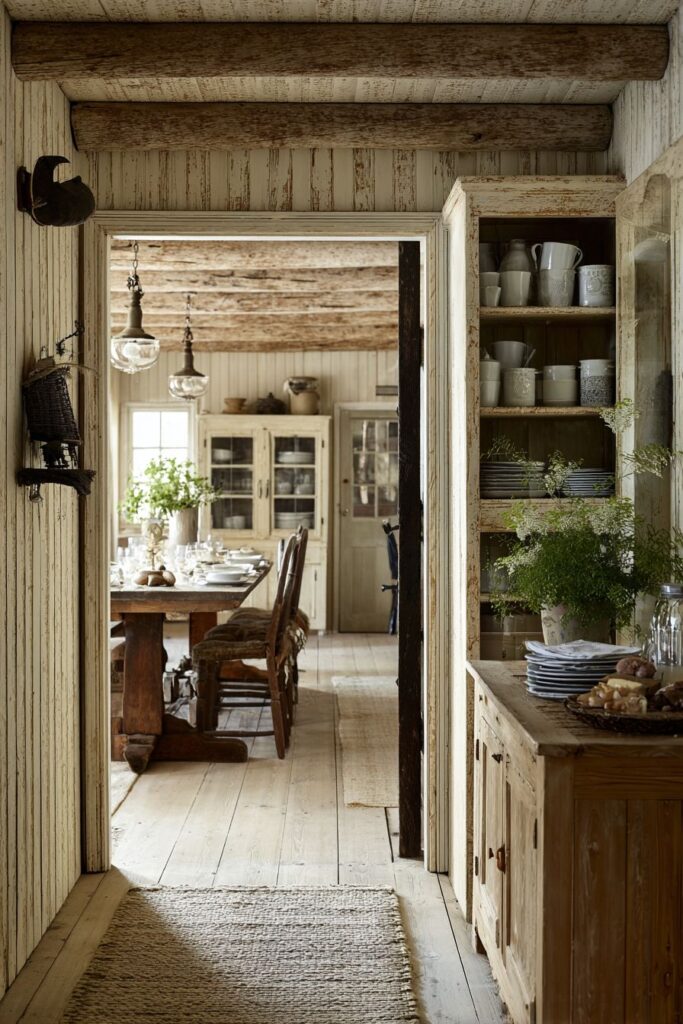
Key Design Tips:
- Invest in heritage pieces: Choose furniture that showcases traditional construction methods and natural material beauty
- Collect authentic antiques: Build seating arrangements over time with genuine antique pieces rather than manufactured reproductions
- Use traditional finishes: Choose authentic finishes like milk paint that age beautifully and develop genuine character
- Add architectural details: Incorporate traditional wall treatments and construction methods that reference cottage building heritage
17. Coastal Cottage Serenity
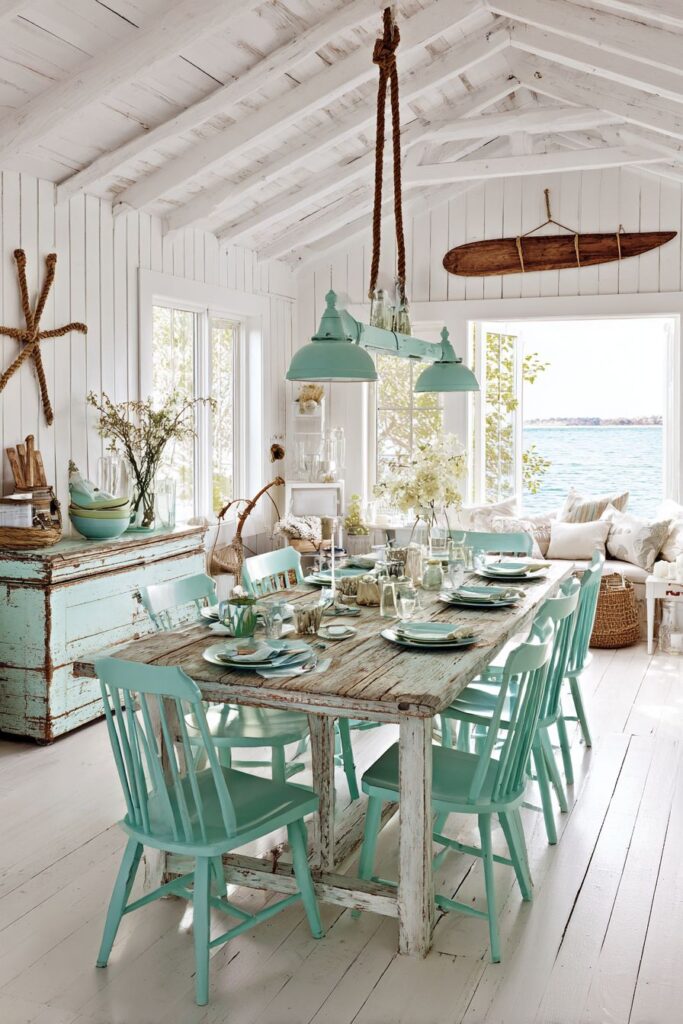
The cottage dining room embraces coastal influences through a weathered teak dining table with natural driftwood-like finish that brings the relaxed elegance of seaside living to cottage dining, creating a space that feels like a beach house retreat while maintaining cottage warmth and charm. This beautiful table, with its silvered finish and natural weathering patterns, suggests years of salt air and ocean breezes while providing a stunning centerpiece that anchors the coastal cottage aesthetic with authentic materials and organic beauty.
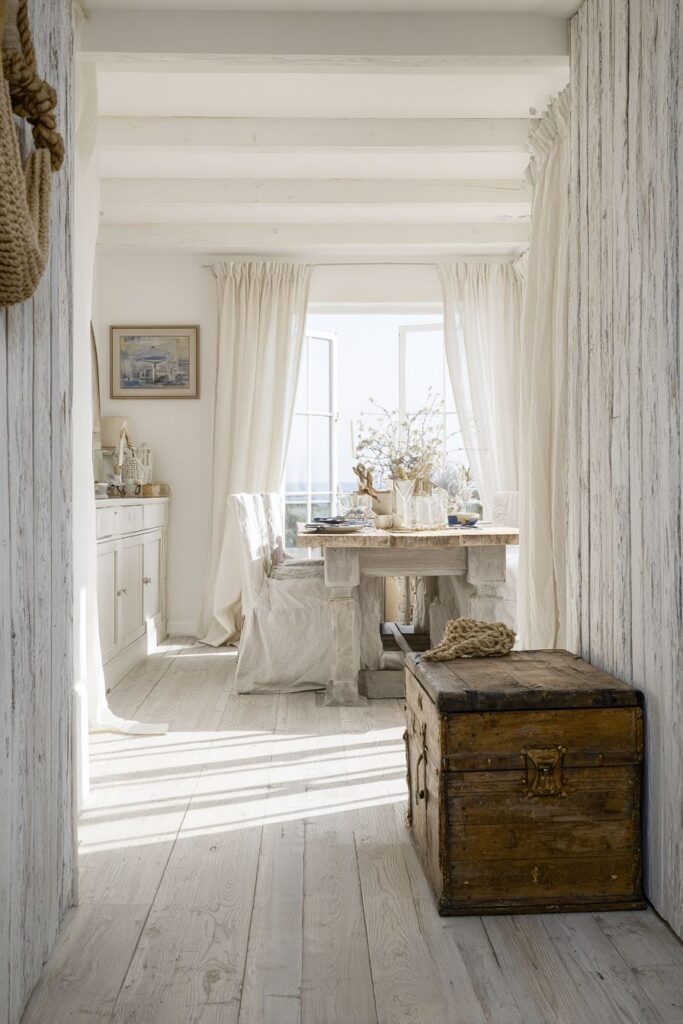
Painted wooden chairs in soft sea glass colors complement the beachy aesthetic while providing comfortable seating that references coastal cottage traditions, their gentle blue-green tones evoking calm ocean waters and sea-washed glass found along shorelines. These chairs, with their relaxed styling and ocean-inspired colors, create seating that invites leisurely meals and peaceful contemplation while maintaining the comfort essential to successful cottage dining rooms.
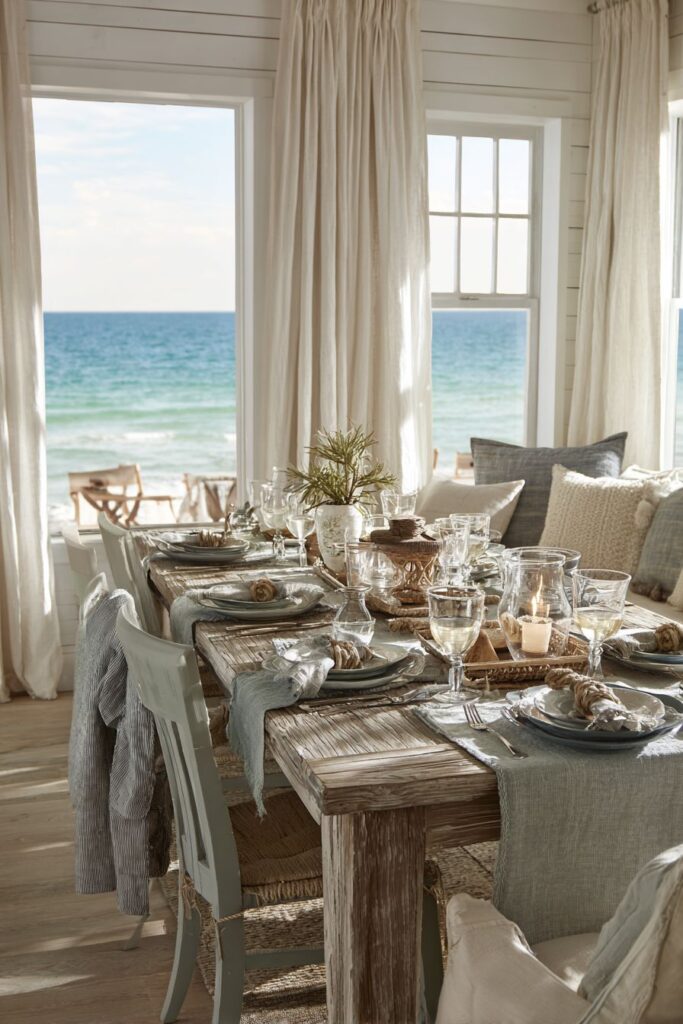
A vintage sea chest serves as both storage and authentic coastal cottage character, its weathered wood and traditional construction referencing maritime traditions while providing functional storage for table linens, serving pieces, or seasonal dining accessories. This piece brings instant coastal authenticity while demonstrating cottage style’s love of repurposed and historically significant furniture that tells stories of different lives and uses.
Whitewashed plank walls and linen curtains in natural tones create a light, airy feel that maximizes natural light while providing the clean, fresh backdrop essential to coastal cottage design. The whitewashed walls suggest driftwood bleached by sun and salt while the natural linen curtains filter ocean light beautifully. Rope details and nautical accessories add coastal charm without overwhelming the space with theme decorating, maintaining the sophisticated restraint that defines successful coastal cottage design.
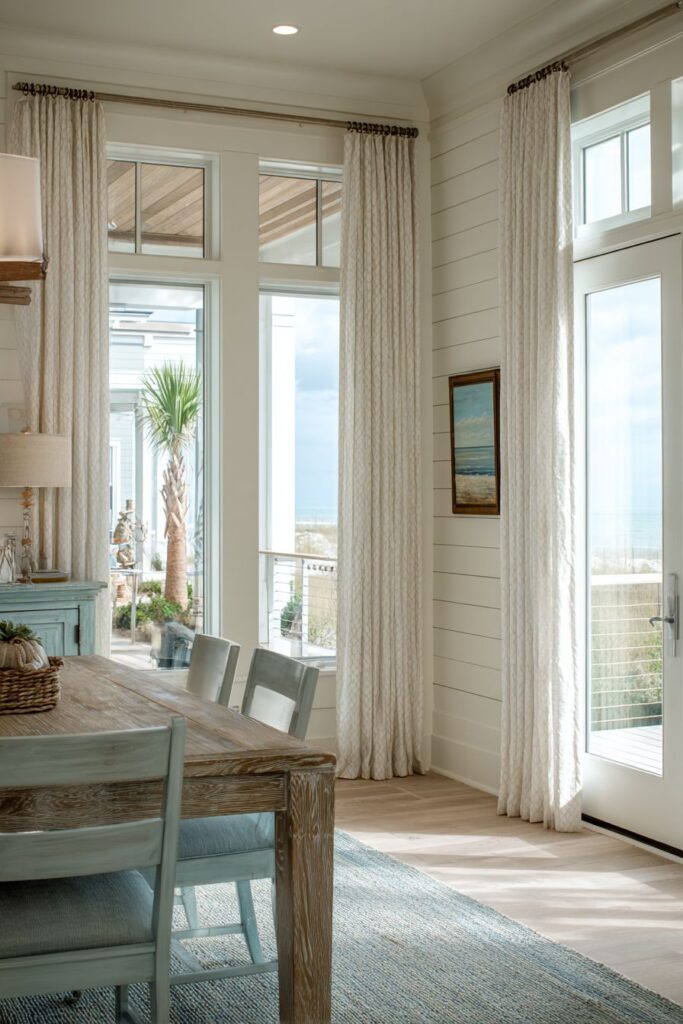
Key Design Tips:
- Choose weathered natural materials: Select furniture with authentic coastal weathering rather than artificial beach-themed pieces
- Use ocean-inspired colors: Incorporate soft blues and greens that reference natural coastal elements like sea glass and ocean water
- Add authentic maritime pieces: Include genuine coastal antiques like sea chests that bring real maritime history to cottage dining rooms
- Maintain sophisticated restraint: Use coastal elements thoughtfully rather than overwhelming spaces with obvious beach themes
18. Butter Yellow Country Charm
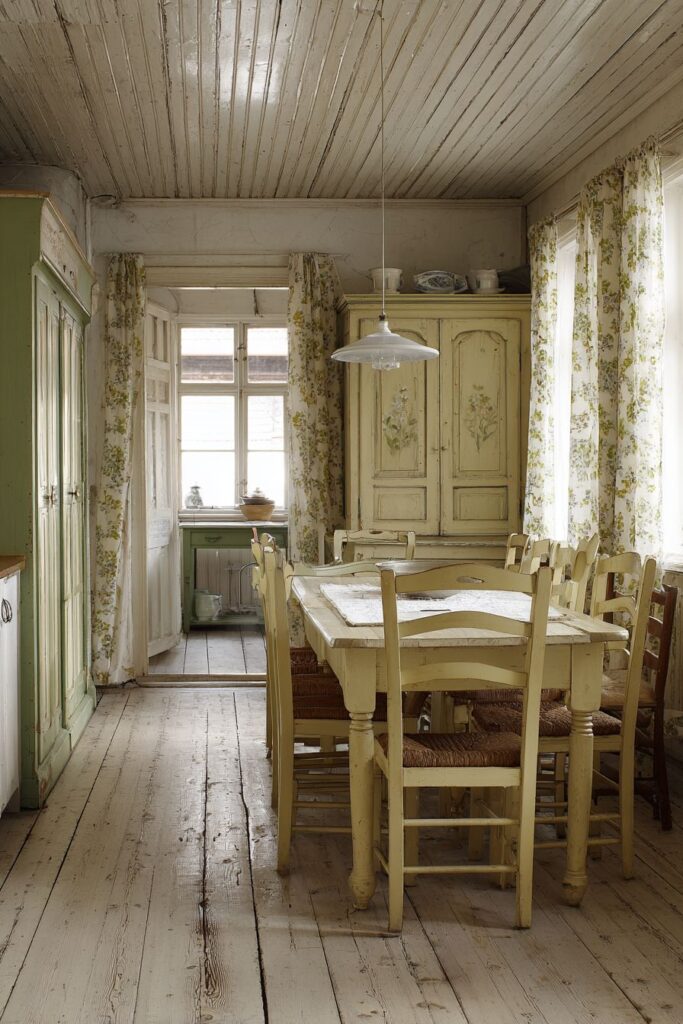
The cottage dining room radiates country charm through a painted pine table in soft butter yellow with naturally distressed edges that reveal wood underneath, creating a piece that feels both fresh and authentically aged through years of loving family use. This cheerful color choice brings sunshine and warmth to cottage dining while the honest distressing suggests genuine wear rather than artificial aging techniques. The soft butter yellow finish creates a focal point that brightens the entire dining room while maintaining cottage authenticity through its gentle, weathered appearance.
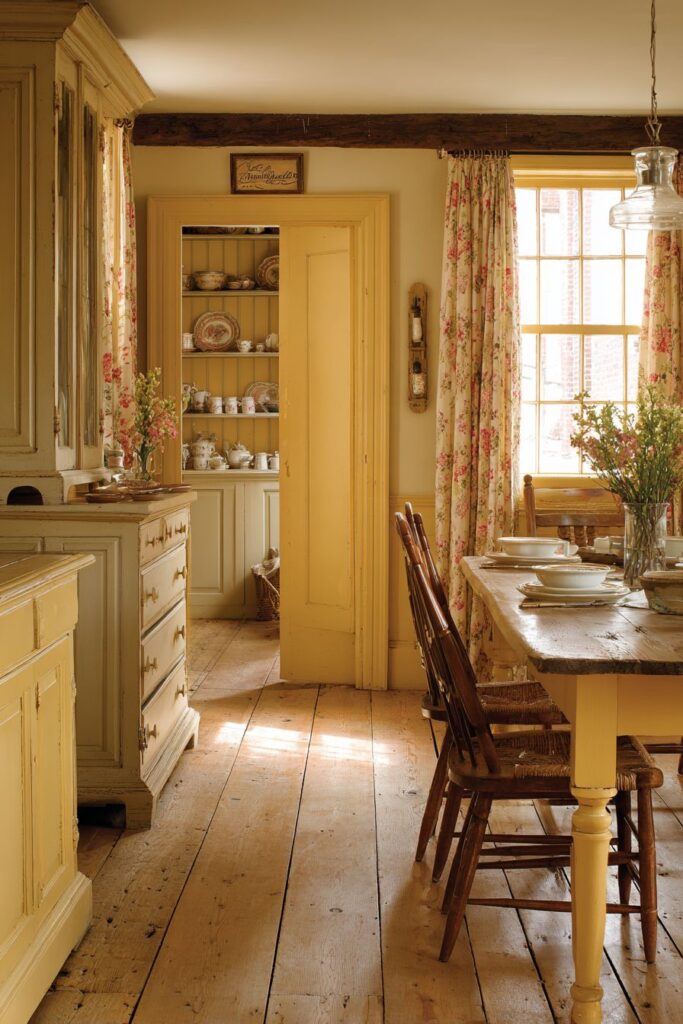
Country-style chairs with cane seats provide comfortable seating that references traditional cottage craftsmanship while adding natural texture and traditional weaving techniques that speak to cottage connections with traditional crafts and countryside traditions. These chairs, with their honest construction and organic materials, provide both visual interest and comfortable seating that improves with age and use while maintaining the natural material focus essential to cottage design.
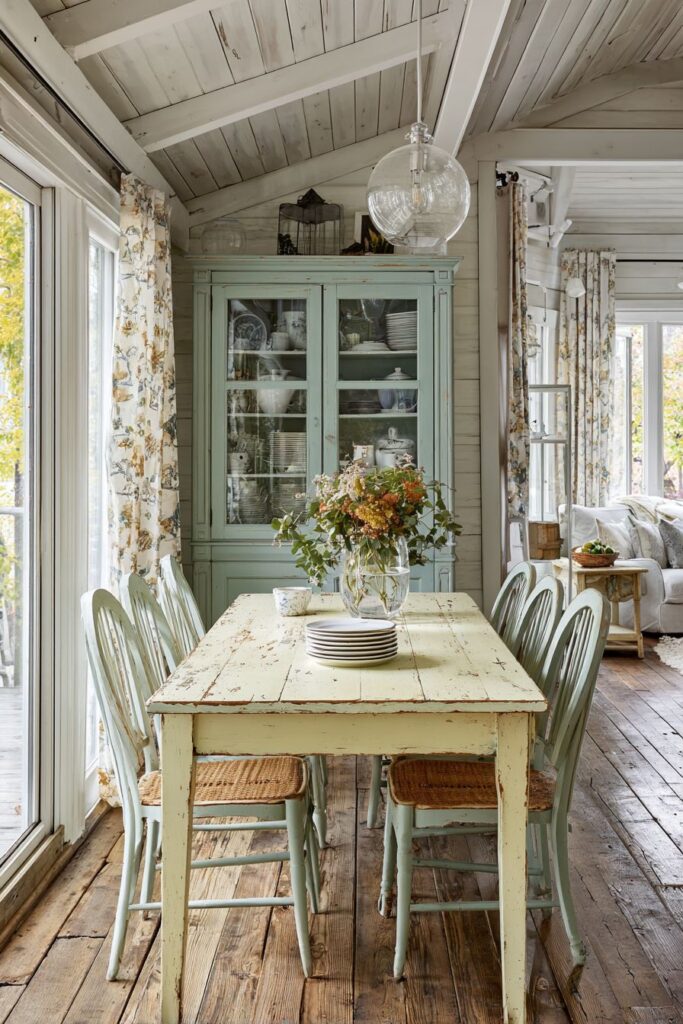
A tall cupboard painted in coordinating sage displays transferware and linens, its generous proportions and beautiful color coordination creating storage that feels intentional and curated while providing essential functionality for cottage dining room organization. This storage piece demonstrates cottage style’s love of painted furniture in soft, garden-inspired colors while providing the practical storage needed for family dining and entertaining.
Floral curtains in faded prints frame casement windows, their romantic patterns and gentle colors creating window treatments that feel collected over time rather than purchased as coordinated sets. These curtains, with their vintage appeal and garden-inspired motifs, filter natural light beautifully while adding cottage charm and romantic atmosphere. Wide-plank floors show honest wear patterns that speak to authentic cottage living, while a simple glass pendant light provides functional illumination that doesn’t compete with the room’s charming vintage character.
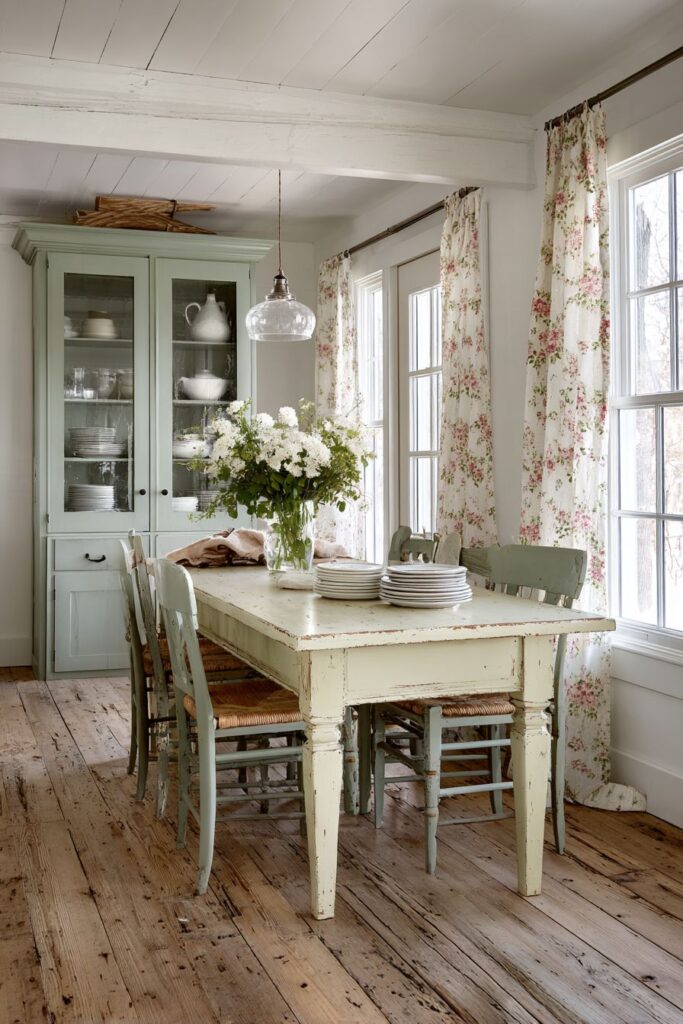
Key Design Tips:
- Use cheerful paint colors: Choose warm, sunny colors like butter yellow that brighten cottage dining rooms while maintaining authenticity
- Incorporate traditional crafts: Add furniture with cane seats and other traditional techniques that reference cottage craftsmanship heritage
- Coordinate painted pieces: Use related colors across multiple furniture pieces to create cohesive, intentional cottage color schemes
- Choose vintage-inspired fabrics: Select curtains and textiles with faded, romantic patterns that feel authentically aged
19. Arts and Crafts Heritage
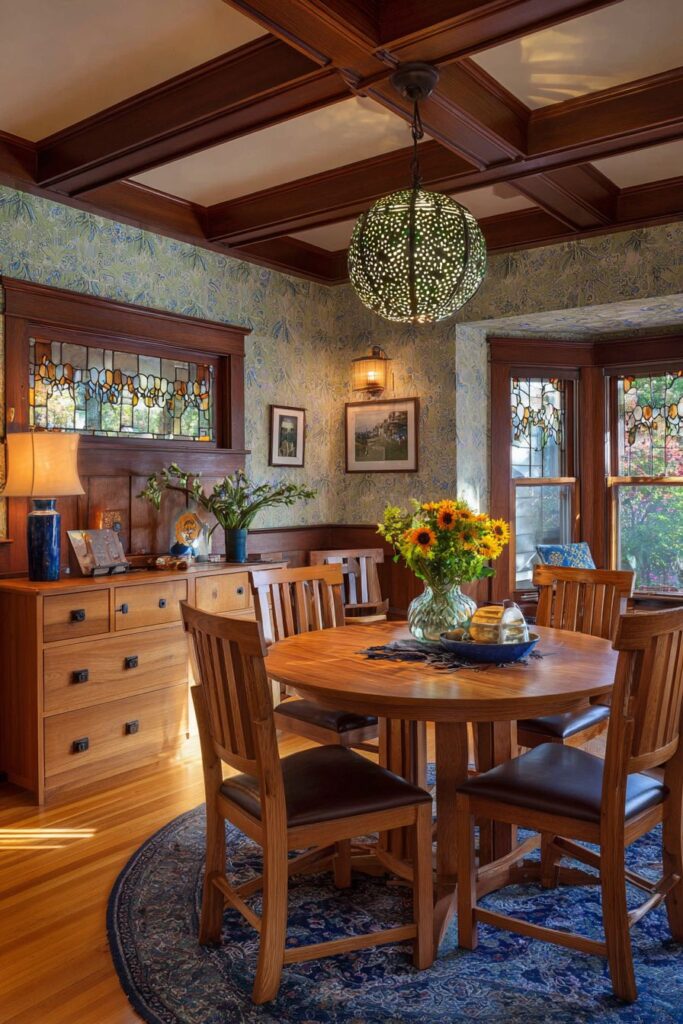
The cottage dining room takes inspiration from Arts and Crafts movement principles through a mission-style dining table in rich oak with visible joinery details that celebrates traditional woodworking craftsmanship while providing substantial, beautiful furniture that will last for generations. This table, with its honest construction and emphasis on material beauty, represents the Arts and Crafts ideal of furniture that serves both functional and aesthetic purposes through superior design and construction rather than applied decoration.
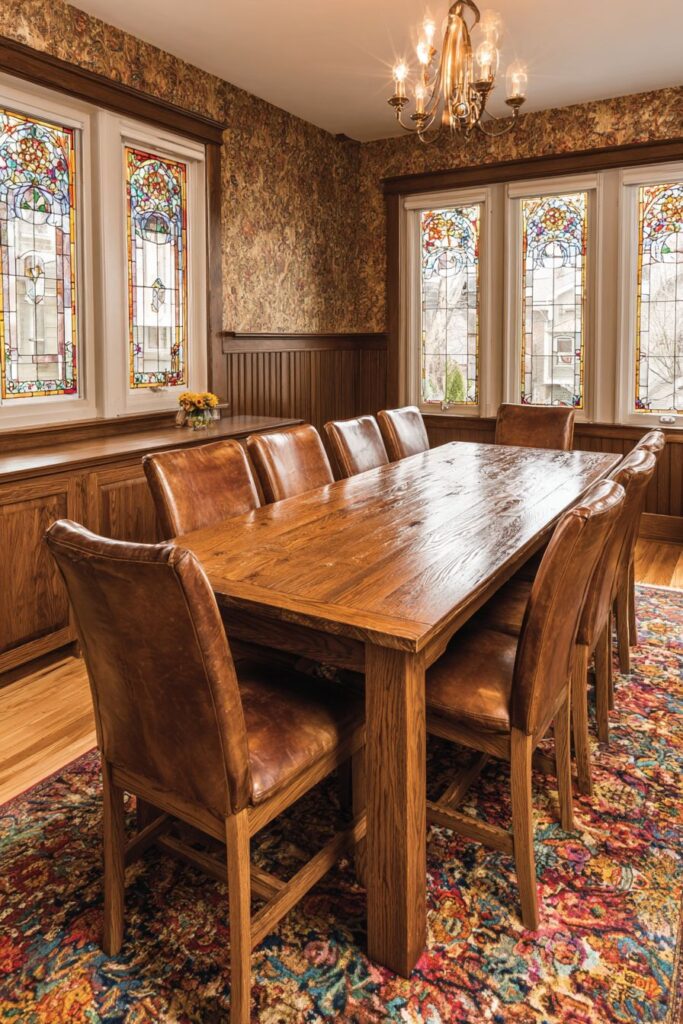
Leather-seated chairs with wooden frames maintain the craftsman aesthetic while providing comfortable seating that references traditional Arts and Crafts furniture design principles, their honest materials and visible construction techniques creating seating that celebrates woodworking skill and traditional joinery methods. These chairs, with their substantial construction and quality materials, provide dining seating that improves with age and use while maintaining the movement’s emphasis on authentic craftsmanship and material integrity.
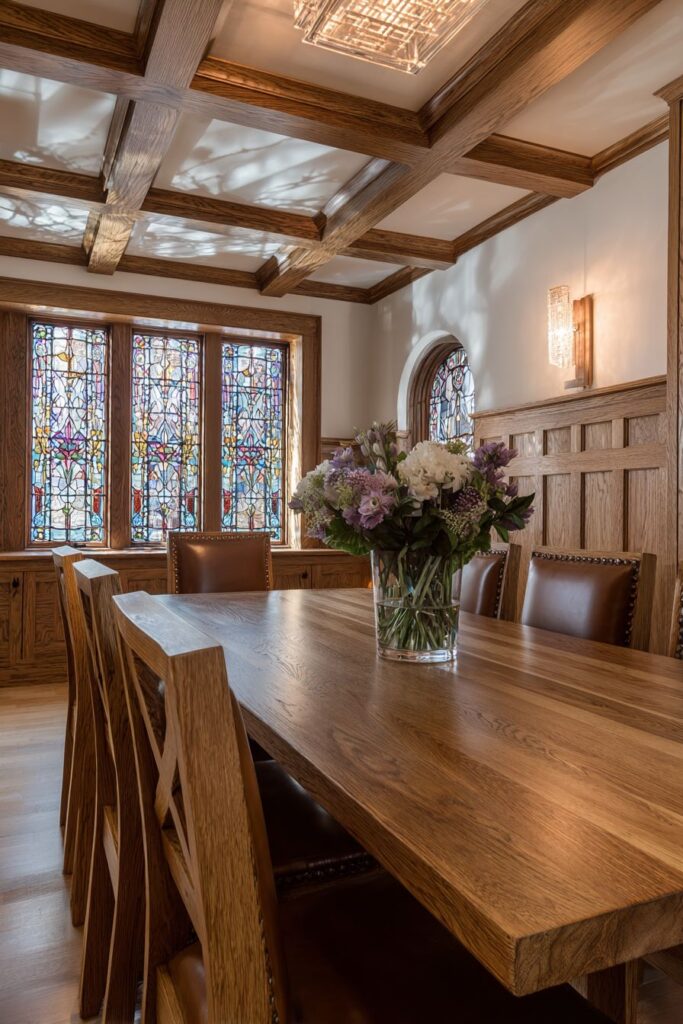
A built-in sideboard provides integrated storage that demonstrates Arts and Crafts emphasis on fitted furniture and architectural integration, creating storage solutions that feel permanent and intentional rather than added as afterthoughts. This approach to dining room storage creates seamless integration between furniture and architecture while providing the extensive storage needed for formal dining and entertaining.
Wainscoting in natural wood and Morris-inspired wallpaper create period-appropriate backgrounds that reference Arts and Crafts design principles while providing rich, textural environments that celebrate both natural materials and decorative arts traditions. The combination of natural wood and patterned wallpaper creates visual richness while maintaining the movement’s emphasis on quality materials and traditional craftsmanship. Stained glass accents in the windows cast colorful light patterns that add artistic interest while referencing Arts and Crafts emphasis on integrating decorative arts into architectural settings.
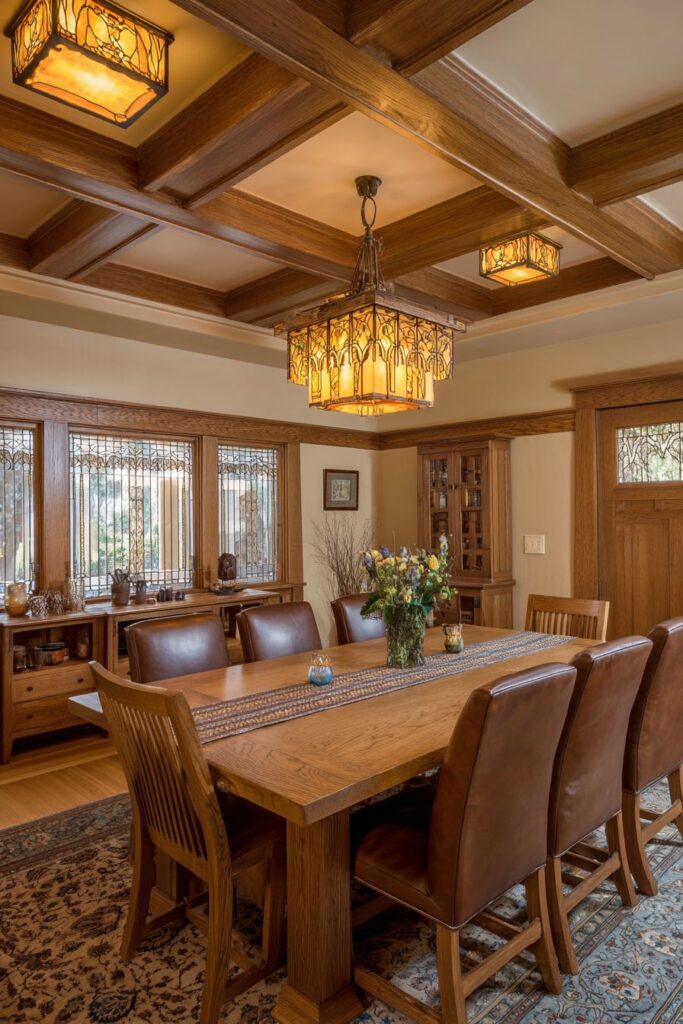
Key Design Tips:
- Emphasize visible craftsmanship: Choose furniture that showcases traditional joinery and woodworking techniques rather than hiding construction methods
- Integrate architectural elements: Use built-in storage and fitted furniture to create seamless integration between furniture and architecture
- Celebrate natural materials: Showcase wood grain and other natural materials rather than covering them with paint or artificial finishes
- Add decorative arts elements: Incorporate stained glass and patterned wallpapers that reference Arts and Crafts decorative traditions
20. Mint Green Farmhouse Freshness
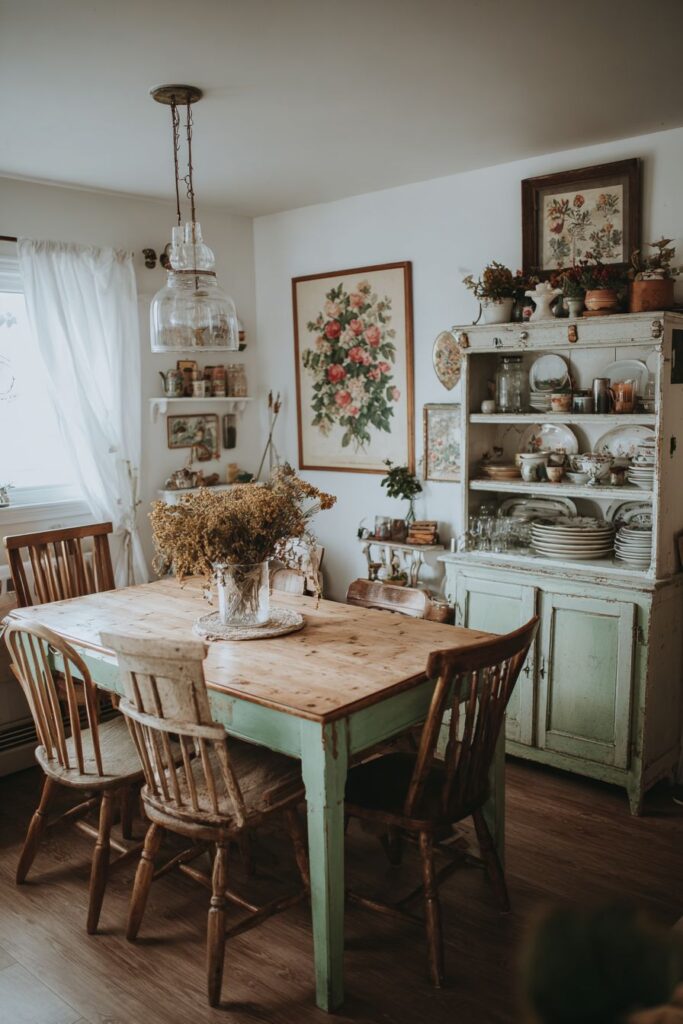
The cottage dining room achieves perfect farmhouse freshness through a dining table with painted base in soft mint green and natural pine top that shows gentle wear from daily family use, creating a piece that balances color and natural materials while demonstrating cottage style’s love of authentic wear and comfortable functionality. This color choice brings garden freshness and spring-like renewal to cottage dining while the honest wear patterns on the pine top speak to genuine family use and cherished memories created around the dining table.
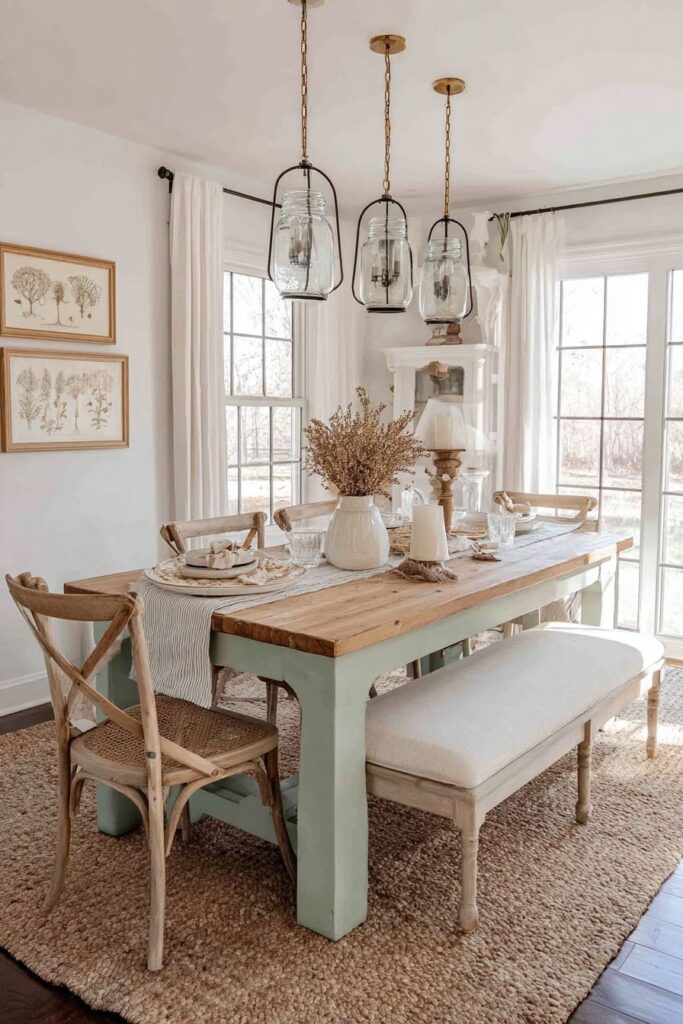
Mix-and-match seating including a deacon’s bench and vintage dining chairs creates a collected aesthetic that demonstrates cottage style’s emphasis on personality over perfection, each piece contributing its own character while working together to create comfortable, interesting seating arrangements. The deacon’s bench provides flexible seating that accommodates families while adding traditional cottage furniture styling, while the vintage chairs bring their own stories and character to the dining experience.
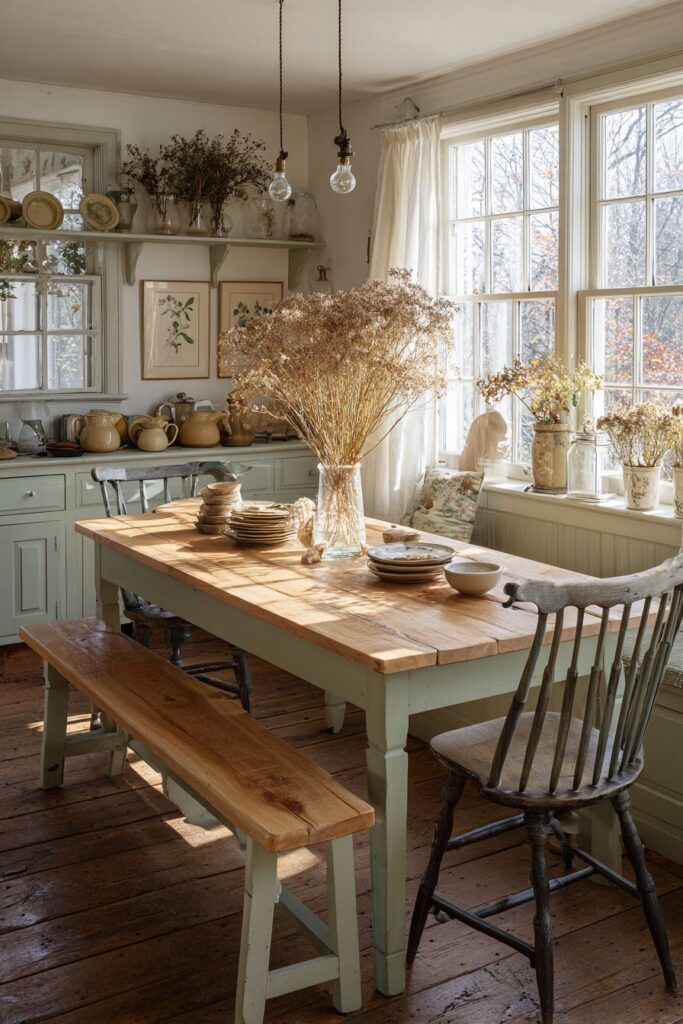
A plate rack displays everyday dishes while providing practical storage that keeps frequently used items within easy reach, demonstrating cottage style’s emphasis on functional beauty where storage solutions contribute to the room’s aesthetic appeal while serving essential organizational purposes. This traditional storage method allows dishes to air dry naturally while creating attractive displays that change with daily use and seasonal dish collections.
Mason jar pendant lights add rustic charm while providing practical task lighting over the dining table, their simple forms and natural materials creating fixtures that feel authentic rather than artificially rustic while contributing to the farmhouse cottage aesthetic through honest materials and traditional forms. Vintage botanical prints and dried flower arrangements complete the cottage look, bringing garden connections and natural beauty indoors while creating wall interest that references cottage connections to countryside and gardening traditions.
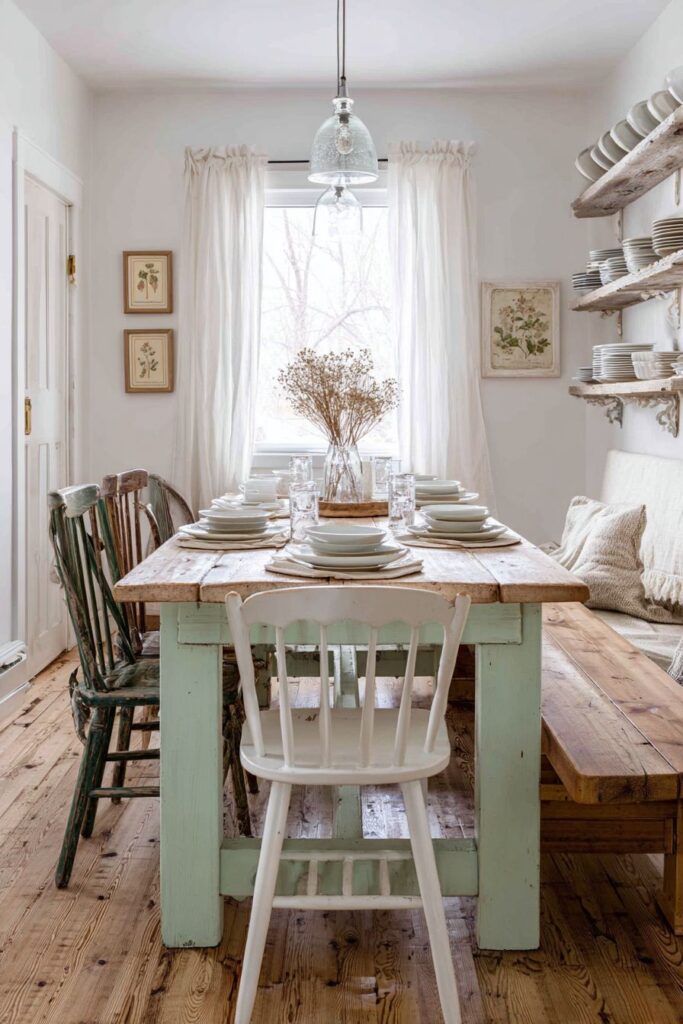
Key Design Tips:
- Choose fresh, garden-inspired colors: Use soft mint green and other garden colors to bring spring-like freshness to cottage dining rooms
- Create collected seating arrangements: Mix different chair styles and include benches to create interesting, personality-filled seating
- Display everyday items beautifully: Use plate racks and open storage to create functional displays that contribute to cottage charm
- Add authentic rustic lighting: Choose fixtures made from natural materials that feel genuinely rustic rather than artificially country-themed
Why These Cottage Dining Room Designs Represent the Best in Cottage Style
These twenty cottage dining room designs represent the pinnacle of cottage style because they successfully balance authenticity with functionality, creating spaces that feel genuinely lived-in while maintaining the timeless appeal that makes cottage design perpetually popular. Each design demonstrates key cottage principles including the celebration of natural materials, the embrace of honest wear and patina, the importance of collected rather than matched furnishings, and the integration of functional storage solutions that contribute to overall aesthetic appeal.
The rustic farmhouse designs with reclaimed materials showcase cottage style’s commitment to sustainability and environmental responsibility while creating furniture with instant character and authentic appeal. These spaces demonstrate how cottage style naturally incorporates green design principles through the use of salvaged and repurposed materials that bring history and character to contemporary cottage dining rooms.
The painted furniture examples throughout these designs illustrate cottage style’s love of soft, garden-inspired colors that bring freshness and personality to dining spaces while allowing the natural beauty of wood grain and construction details to show through honest wear patterns. These painted pieces demonstrate how cottage style achieves the perfect balance between color and natural materials, creating furniture that feels both cheerful and authentic.
The storage solutions featured in these designs—from Welsh dressers to built-in cupboards—show how cottage style successfully integrates functional needs with aesthetic appeal, creating storage that serves practical purposes while contributing to overall room design through beautiful proportions, traditional construction methods, and thoughtful display opportunities. These storage pieces demonstrate cottage style’s genius for making functional elements beautiful and meaningful.
The seating arrangements across these twenty designs showcase cottage style’s emphasis on comfort and personality over rigid formality, demonstrating how mismatched chairs and collected pieces create dining rooms with genuine character and engaging visual interest. These eclectic seating arrangements show how cottage style celebrates individual pieces while creating cohesive overall designs through shared color palettes, similar scales, and complementary materials.
The lighting solutions throughout these cottage dining rooms demonstrate how traditional fixtures and natural light work together to create the warm, welcoming atmospheres essential to successful cottage design. From wrought iron chandeliers to mason jar pendants, these lighting choices show how cottage style balances practical illumination needs with authentic material choices and traditional styling.
Conclusion
Creating the perfect cottage dining room requires balancing multiple elements—authentic materials, comfortable functionality, personal character, and timeless appeal—while maintaining the essential cottage principles of simplicity, sustainability, and connection to traditional craftsmanship. These twenty design concepts demonstrate how cottage style adapts to different influences and requirements while maintaining its core identity as a design approach that celebrates authentic living, natural materials, and the beauty found in honest wear and gentle imperfection.
Whether you’re drawn to the rustic charm of reclaimed farmhouse tables, the romantic appeal of shabby chic styling, the sophisticated elegance of French country influences, or the clean simplicity of Scandinavian-inspired cottage design, the key to successful cottage dining rooms lies in choosing pieces and approaches that feel authentic to your lifestyle while honoring cottage traditions of comfort, functionality, and timeless beauty.
The cottage dining room serves as more than just a place to eat—it becomes the heart of family life, the setting for memorable gatherings, and a reflection of personal style that grows more beautiful with time and use. By incorporating the design principles and specific ideas presented in these twenty concepts, you can create a cottage dining room that not only serves your practical needs but also provides the kind of timeless, welcoming atmosphere that makes every meal feel like a celebration of home, family, and the enduring appeal of authentic cottage living.
